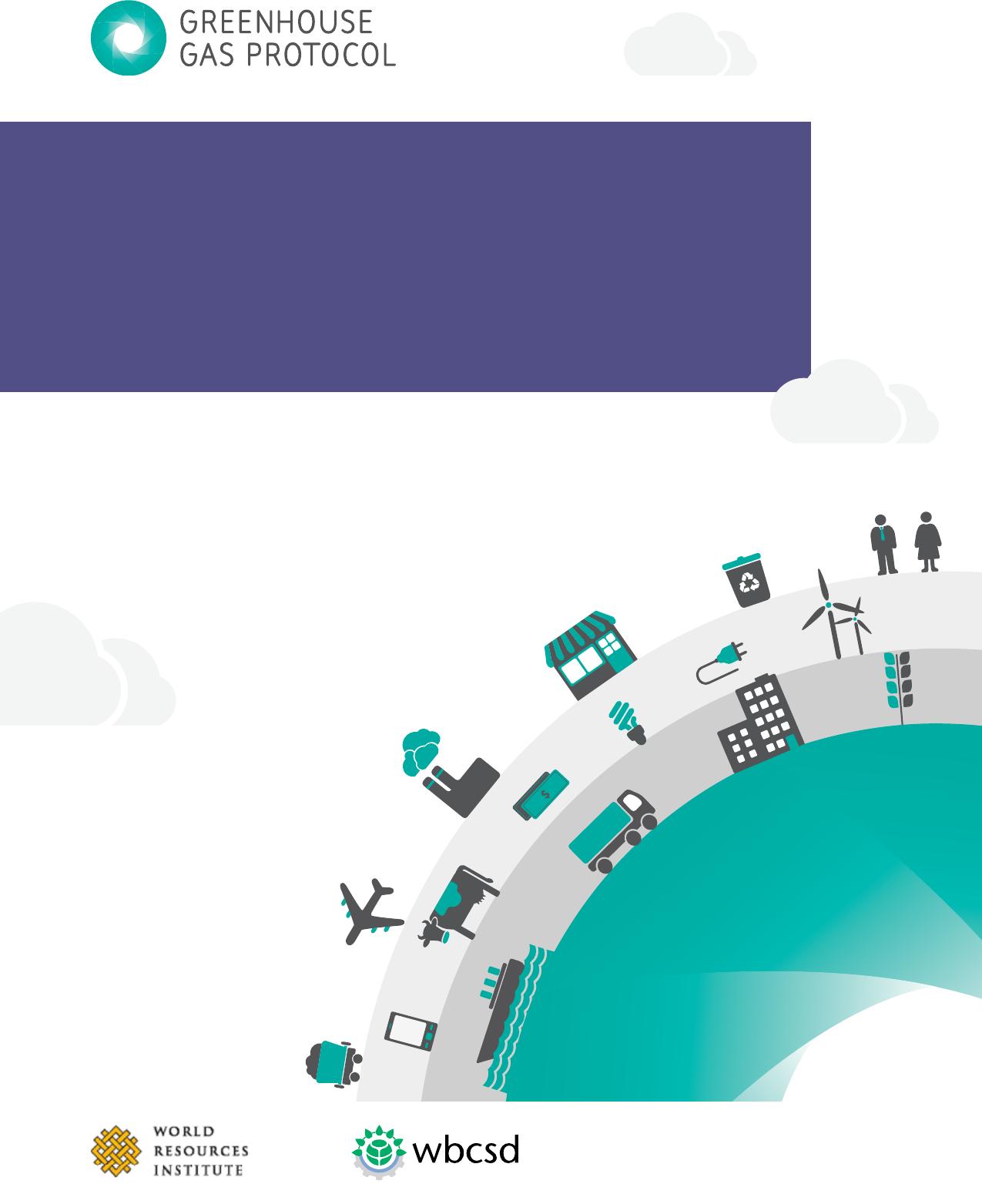CorporateValueChain(Scope3)AccountingandReportingStandardSupplementtotheGHGProtocolCorporateAccountingandReportingStandarde-readerversionCO2CH4SF6N2OHFCsPFCspurchasedelectricity,steam,heating&coolingforownusepurchasedgoodsandservicescapitalgoodsfuelandenergyrelatedactivitiestransportationanddistributionwastegeneratedinoperationsbusinesstraveltransportationanddistributionprocessingofsoldproductsuseofsoldproductsend-of-lifetreatmentofsoldproductsleasedassetsfranchisesemployeecommutingleasedassetsinvestmentscompanyfacilitiescompanyvehiclesGHGProtocolTeamPankajBhatia,WorldResourcesInstituteCynthiaCummis,WorldResourcesInstituteAndreaBrown,WorldBusinessCouncilforSustainableDevelopmentDavidRich,WorldResourcesInstituteLauraDraucker,WorldResourcesInstituteHollyLahd,WorldResourcesInstituteSteeringCommitteeGeraldRebitzer,AmcorLtd.NigelTopping,FrancesWay,CarbonDisclosureProject(CDP)GrahamSinden,TheCarbonTrustH.ScottMatthews,CarnegieMellonUniversityLucLarmuseau,DNVClimateChangeServicesDavidA.Russell,RobRouse,TheDowChemicalCompanyJiangKejun,EnergyResearchInstitute,China’sNationalDevelopmentandReformCommissionAndrewHutson,EnvironmentalDefenseFundSimonAumônier,EnvironmentalResourcesManagementUgoPretato,KiranaChomkhamsri,EuropeanCommissionJointResearchCentreStevenMeyers,GeneralElectricSergioGaleano,GeorgiaPacific,ISOTC207U.S.TechnicalAdvisoryGroupGregoryA.Norris,HarvardUniversity,NewEarth,UniversityofArkansasKlausRadunsky,ISO14067WorkingGroupConvenerAtsushiInaba,KogakuinUniversityAlisonWatson,NewZealandMinistryofAgricultureandForestrySusanCosper,NickShufro,PricewaterhouseCoopersLLPRasmusPriess,THEMA1GmbH,ProductCarbonFootprintWorldForumWandaCallahan,ShellJamesA.Fava,UNEPSETACLifeCycleInitiative,FiveWindsInternationalMatthiasFinkbeiner,UNEPSETACLifeCycleInitiative,TechnischeUniversitätBerlinHenryKing,UnileverSusanWickwire,JohnSottong,UnitedStatesEnvironmentalProtectionAgencyMaureenNowak,UnitedKingdomDepartmentofEnvironment,Food,andRuralAffairsJamesStanway,MirandaBallentine,WalmartStoresInc.CorporateValueChain(Scope3)AccountingandReportingStandard•e-readerversion[01]guidanceguidanceguidancerequirementsguidancerequirementsguidancerequirementsguidanceguidanceguidancerequirementsguidanceguidancerequirementsTableofContentsCHAPTERS1.Introduction022.BusinessGoals103.SummaryofStepsandRequirements184.AccountingandReportingPrinciples225.IdentifyingScope3Emissions266.SettingtheScope3Boundary587.CollectingData648.AllocatingEmissions869.SettingaGHGReductionTargetandTrackingEmissionsOverTime9810.Assurance11311.Reporting120APPENDICESA.AccountingforEmissionsfromLeasedAssets126B.UncertaintyinScope3Emissions128C.DataManagementPlan132Abbreviations138Glossary139References146Recognitions147guidanceCorporateValueChain(Scope3)AccountingandReportingStandard•e-readerversion[02]Introduction01CorporateValueChain(Scope3)AccountingandReportingStandard•e-readerversion[03]Emissionsoftheanthropogenicgreenhousegases(GHG)thatdriveclimatechangeanditsimpactsaroundtheworldaregrowing.Accordingtoclimatescientists,globalcarbondioxideemissionsmustbecutbyasmuchas85percentbelow2000levelsby2050tolimitglobalmeantemperatureincreaseto2degreesCelsiusabovepre-industriallevels.1Temperatureriseabovethislevelwillproduceincreasinglyunpredictableanddangerousimpactsforpeopleandecosystems.Asaresult,theneedtoaccelerateeffortstoreduceanthropogenicGHGemissionsisincreasinglyurgent.Existinggovernmentpolicieswillnotsufficientlysolvetheproblem.Leadershipandinnovationfrombusinessisvitaltomakingprogress.Corporateactioninthisarenaalsomakesgoodbusinesssense.ByaddressingGHGemissions,companiescanidentifyopportunitiestobolstertheirbottomline,reducerisk,anddiscovercompetitiveadvantages.Asimpactsfromclimatechangebecomemorefrequentandprominent,governmentsareexpectedtosetnewpoliciesandprovideadditionalmarket-basedincentivestodrivesignificantreductionsinemissions.Thesenewpolicyandmarketdriverswilldirecteconomicgrowthonalow-carbontrajectory.Businessesneedtostartplanningforthistransitionnowastheymakedecisionsthatwilllockintheirinvestmentsforyearstocome.Aneffectivecorporateclimatechangestrategyrequiresadetailedunderstandingofacompany’sGHGimpact.AcorporateGHGinventoryisthetooltoprovidesuchanunderstanding.Itallowscompaniestotakeintoaccounttheiremissions-relatedrisksandopportunitiesandfocuscompanyeffortsontheirgreatestGHGimpacts.Untilrecently,companieshavefocusedtheirattentiononemissionsfromtheirownoperations.ButincreasinglycompaniesunderstandtheneedtoalsoaccountforGHGemissionsalongtheirvaluechainsandproductportfoliostocomprehensivelymanageGHG-relatedrisksandopportunities.ThroughthedevelopmentoftheGHGProtocolCorporateValueChain(Scope3)AccountingandReportingStandard,theGHGProtocolhasrespondedtothedemandforaninternationallyacceptedmethodtoenableGHGmanagementofcompanies’valuechains.Followingthereleaseofthisstandard,theGHGProtocolanditspartnerswillproactivelyworkwithindustrygroupsandgovernmentstopromoteitswidespreaduse–alongwiththeentiresuiteofGHGProtocolstandardsandtools–toenablemoreeffectiveGHGmanagementworldwide.guidanceCHAPTER01IntroductionCorporateValueChain(Scope3)AccountingandReportingStandard•e-readerversion[04]CHAPTER01Introduction1.1TheGreenhouseGasProtocolTheGreenhouseGasProtocol(GHGProtocol)isamulti-stakeholderpartnershipofbusinesses,non-governmentalorganizations(NGOs),governments,andothersconvenedbytheWorldResourcesInstitute(WRI)andtheWorldBusinessCouncilforSustainableDevelopment(WBCSD).Launchedin1998,themissionoftheGHGProtocolistodevelopinternationallyacceptedgreenhousegas(GHG)accountingandreportingstandardsandtools,andtopromotetheiradoptioninordertoachievealowemissionseconomyworldwide.TheGHGProtocolhasproducedthefollowingseparatebutcomplementarystandards,protocols,andguidelines:••GHGProtocolCorporateAccountingandReportingStandard(2004):AstandardizedmethodologyforcompaniestoquantifyandreporttheircorporateGHGemissions.AlsoreferredtoastheCorporateStandard.••GHGProtocolProductLifeCycleAccountingandReportingStandard(2011):AstandardizedmethodologytoquantifyandreportGHGemissionsassociatedwithindividualproductsthroughouttheirlifecycle.AlsoreferredtoastheProductStandard.••GHGProtocolforProjectAccounting(2005):AguideforquantifyingreductionsfromGHG-mitigationprojects.AlsoreferredtoastheProjectProtocol.••GHGProtocolfortheU.S.PublicSector(2010):Astep-by-stepapproachtomeasuringandreportingemissionsfrompublicsectororganizations,complementarytotheCorporateStandard.••GHGProtocolGuidelinesforQuantifyingGHGReductionsfromGrid-ConnectedElectricityProjects(2007):Aguideforquantifyingreductionsinemissionsthateithergenerateorreducetheconsumptionofelectricitytransmittedoverpowergrids,tobeusedinconjunctionwiththeProjectProtocol.••GHGProtocolLandUse,Land-UseChange,andForestryGuidanceforGHGProjectAccounting(2006):Aguidetoquantifyandreportreductionsfromlanduse,land-usechange,andforestry,tobeusedinconjunctionwiththeProjectProtocol.••MeasuringtoManage:AGuidetoDesigningGHGAccountingandReportingPrograms(2007):AguideforprogramdevelopersondesigningandimplementingeffectiveGHGprogramsbasedonacceptedstandardsandmethodologies.1.2�PurposeofthisstandardTheGHGProtocolCorporateValueChain(Scope3)AccountingandReportingStandard(alsoreferredtoastheScope3Standard)providesrequirementsandguidanceforcompaniesandotherorganizationstoprepareandpubliclyreportaGHGemissionsinventorythatincludesindirectemissionsresultingfromvaluechainactivities(i.e.,scope3emissions).Theprimarygoalofthisstandardistoprovideastandardizedstep-by-stepapproachtohelpcompaniesunderstandtheirfullvaluechainemissionsimpactinordertofocuscompanyeffortsonthegreatestGHGreductionopportunities,leadingtomoresustainabledecisionsaboutcompanies’activitiesandtheproductstheybuy,sell,andproduce.Thestandardwasdevelopedwiththefollowingobjectivesinmind:••Tohelpcompaniesprepareatrueandfairscope3GHGinventoryinacost-effectivemanner,throughtheuseofstandardizedapproachesandprinciples••Tohelpcompaniesdevelopeffectivestrategiesformanagingandreducingtheirscope3emissionsthroughanunderstandingofvaluechainemissionsandassociatedrisksandopportunities••TosupportconsistentandtransparentpublicreportingofcorporatevaluechainemissionsaccordingtoastandardizedsetofreportingrequirementsCHAPTER01IntroductionCorporateValueChain(Scope3)AccountingandReportingStandard•e-readerversion[05]Ultimately,thisismorethanatechnicalaccountingstandard.Itisintendedtobetailoredtobusinessrealitiesandtoservemultiplebusinessobjectives.Companiesmayfindmostvalueinimplementingthestandardusingaphasedapproach,withafocusonimprovingthequalityoftheGHGinventoryovertime.1.3�RelationshiptotheGHGProtocolCorporateStandardTheGHGProtocolScope3StandardisasupplementtotheGHGProtocolCorporateAccountingandReportingStandard,RevisedEdition(2004)andshouldbeusedinconjunctionwithit.TheCorporateStandard–firstlaunchedin2001andrevisedin2004–hasbeenwidelyadoptedbybusinesses,NGOs,andgovernmentsaroundtheworldastheinternationalstandardfordevelopingandreportingacompany-wideGHGinventory.TheScope3StandardcomplementsandbuildsupontheCorporateStandardtopromoteadditionalcompletenessandconsistencyinthewaycompaniesaccountforandreportonindirectemissionsfromvaluechainactivities.TheCorporateStandardclassifiesacompany’sdirectandindirectGHGemissionsintothree“scopes,”andrequiresthatcompaniesaccountforandreportallscope1emissions(i.e.,directemissionsfromownedorcontrolledsources)andallscope2emissions(i.e.,indirectemissionsfromthegenerationofpurchasedenergyconsumedbythereportingcompany).TheCorporateStandardgivescompaniesflexibilityinwhetherandhowtoaccountforscope3emissions(i.e.,allotherindirectemissionsthatoccurinacompany’svaluechain).Figure1.1providesanoverviewofthethreeGHGProtocolscopesandcategoriesofscope3emissions.Figure[1.1]OverviewofGHGProtocolscopesandemissionsacrossthevaluechainCO2CH4SF6N2OHFCsPFCspurchasedelectricity,steam,heating&coolingforownusepurchasedgoodsandservicescapitalgoodsfuelandenergyrelatedactivitiestransportationanddistributionwastegeneratedinoperationsbusinesstraveltransportationanddistributionprocessingofsoldproductsuseofsoldproductsend-of-lifetreatmentofsoldproductsleasedassetsfranchisesemployeecommutingleasedassetsinvestmentscompanyfacilitiescompanyvehiclesScope3INDIRECTCO2CH4N2OHFpurchasedelectricity,steam,heating&coolingforownusepurchasedgoodsandservicescapitalgoodsfuelandenergyrelatedactivitiestransportationanddistributionwastegeneratedinoperationsbusinesstravelemployeecommutingleasedassetsinvestmentscompanfacilitiecompanvehicleCO2CH4SF6N2OHFCsPFCspurchasedelectricity,steam,heating&coolingforownusepurchasedgoodsandservicescapitalgoodsfuelandenergyrelatedactivitiestransportationanddistributionwastegeneratedinoperationsbusinesstraveltransportationanddistributionprocessingofsoldproductsuseofsoldproductsend-of-lifetreatmentofsoldproductsleasedassetsfranchisesemployeecommutingleasedassetsinvestmentscompanyfacilitiescompanyvehiclesCO2CH4SF6N2OHFCsPFCspurchasedelectricity,steam,heating&coolingforownusepurchasedgoodsandservicescapitalgoodsfuelandenergyrelatedactivitiestransportationanddistributionwastegeneratedinoperationsbusinesstraveltransportationanddistributionprocessingofsoldproductsuseofsoldproductsend-of-lifetreatmentofsoldproductsleasedassetsfranchisesemployeecommutingleasedassetsinvestmentscompanyfacilitiescompanyvehiclesCO2CH4SF6N2OHFCsPFCspurchasedelectricity,steam,heating&coolingforownusepurchasedgoodsandservicescapitalgoodsfuelandenergyrelatedactivitiestransportationanddistributionwastegeneratedinoperationsbusinesstraveltransportationanddistributionprocessingofsoldproductsuseofsoldproductsend-of-lifetreatmentofsoldproductsleasedassetsfranchisesemployeecommutingleasedassetsinvestmentscompanyfacilitiescompanyvehiclesCO2CH4SF6N2OHFCsPFCspurchasedelectricity,steam,heating&coolingforownusepurchasedgoodsandservicescapitalgoodsfuelandenergyrelatedactivitiestransportationanddistributionwastegeneratedinoperationsbusinesstraveltransportationanddistributionprocessingofsoldproductsuseofsoldproductsend-of-lifetreatmentofsoldproductsleasedassetsfranchisesemployeecommutingleasedassetsinvestmentscompanyfacilitiescompanyvehiclesCO2CH4SF6N2OHFCsPFCspurchasedelectricity,steam,heating&coolingforownusepurchasedgoodsandservicescapitalgoodsfuelandenergyrelatedactivitiestransportationanddistributionwastegeneratedinoperationsbusinesstraveltransportationanddistributionprocessingofsoldproductsuseofsoldproductsend-of-lifetreatmentofsoldproductsleasedassetsfranchisesemployeecommutingleasedassetsinvestmentscompanyfacilitiescompanyvehiclesCO2CH4SF6N2OHFCsPFCspurchasedelectricity,steam,heating&coolingforownusepurchasedgoodsandservicescapitalgoodsfuelandenergyrelatedactivitiestransportationanddistributionwastegeneratedinoperationsbusinesstraveltransportationanddistributionprocessingofsoldproductsuseofsoldproductsend-of-lifetreatmentofsoldproductsleasedassetsfranchisesemployeecommutingleasedassetsinvestmentscompanyfacilitiescompanyvehiclesReportingcompanyUpstreamactivitiesDownstreamactivitiesCO2CH4SF6N2OHFCsPFCspurchasedelectricity,steam,heating&coolingforownusepurchasedgoodsandservicescapitalgoodsfuelandenergyrelatedactivitiestransportationanddistributionwastegeneratedinoperationsbusinesstraveltransportationanddistributionprocessingofsoldproductsuseofsoldproductsend-of-lifetreatmentofsoldproductsleasedassetsfranchisesemployeecommutingleasedassetsinvestmentscompanyfacilitiescompanyvehiclesCO2CH4SF6N2OHFCsPFCspurchasedelectricity,steam,heating&coolingforownusepurchasedgoodsandservicescapitalgoodsfuelandenergyrelatedactivitiestransportationanddistributionwastegeneratedinoperationsbusinesstraveltransportationanddistributionprocessingofsoldproductsuseofsoldproductsend-of-lifetreatmentofsoldproductsleasedassetsfranchisesemployeecommutingleasedassetsinvestmentscompanyfacilitiescompanyvehiclesScope1DIRECTScope2INDIRECTScope3INDIRECTCO2CH4SF6N2OHFCsPFCspurchasedelectricity,steam,heating&coolingforownusepurchasedgoodsandservicescapitalgoodsfuelandenergyrelatedactivitiestransportationanddistributionwastegeneratedinoperationsbusinesstraveltransportationanddistributionprocessingofsoldproductsuseofsoldproductsend-of-lifetreatmentofsoldproductsleasedassetsfranchisesemployeecommutingleasedassetsinvestmentscompanyfacilitiescompanyvehiclesCO2CH4SF6N2OHFCsPFCspurchasedelectricity,steam,heating&coolingforownusepurchasedgoodsandservicescapitalgoodsfuelandenergyrelatedactivitiestransportationanddistributionwastegeneratedinoperationsbusinesstraveltransportationanddistributionprocessingofsoldproductsuseofsoldproductsend-of-lifetreatmentofsoldproductsleasedassetsfranchisesemployeecommutingleasedassetsinvestmentscompanyfacilitiescompanyvehiclesCO2CH4SF6N2OHFCsPFCspurchasedelectricity,steam,heating&coolingforownusepurchasedgoodsandservicescapitalgoodsfuelandenergyrelatedactivitiestransportationanddistributionwastegeneratedinoperationsbusinesstraveltransportationanddistributionprocessingofsoldproductsuseofsoldproductsend-of-lifetreatmentofsoldproductsleasedassetsfranchisesemployeecommutingleasedassetsinvestmentscompanyfacilitiescompanyvehiclesCO2CH4SF6N2OHFCsPFCspurchasedelectricity,steam,heating&coolingforownusepurchasedgoodsandservicescapitalgoodsfuelandenergyrelatedactivitiestransportationanddistributionwastegeneratedinoperationsbusinesstraveltransportationanddistributionprocessingofsoldproductsuseofsoldproductsend-of-lifetreatmentofsoldproductsleasedassetsfranchisesemployeecommutingleasedassetsinvestmentscompanyfacilitiescompanyvehiclesCO2CH4SF6N2OHFCsPFCspurchasedelectricity,steam,heating&coolingforownusepurchasedgoodsandservicescapitalgoodsfuelandenergyrelatedactivitiestransportationanddistributionwastegeneratedinoperationsbusinesstraveltransportationanddistributionprocessingofsoldproductsuseofsoldproductsend-of-lifetreatmentofsoldproductsleasedassetsfranchisesemployeecommutingleasedassetsinvestmentscompanyfacilitiescompanyvehiclesCO2CH4SF6N2OHFCsPFCspurchasedelectricity,steam,heating&coolingforownusepurchasedgoodsandservicescapitalgoodsfuelandenergyrelatedactivitiestransportationanddistributionwastegeneratedinoperationsbusinesstraveltransportationanddistributionprocessingofsoldproductsuseofsoldproductsend-of-lifetreatmentofsoldproductsleasedassetsfranchisesemployeecommutingleasedassetsinvestmentscompanyfacilitiescompanyvehiclesCO2CH4SF6N2OHFCsPFCspurchasedelectricity,steam,heating&coolingforownusepurchasedgoodsandservicescapitalgoodsfuelandenergyrelatedactivitiestransportationanddistributionwastegeneratedinoperationsbusinesstraveltransportationanddistributionprocessingofsoldproductsuseofsoldproductsend-of-lifetreatmentofsoldproductsleasedassetsfranchisesemployeecommutingleasedassetsinvestmentscompanyfacilitiescompanyvehiclesCO2CH4SF6N2OHFCsPFCspurchasedelectricity,steam,heating&coolingforownusepurchasedgoodsandservicescapitalgoodsfuelandenergyrelatedactivitiestransportationanddistributionwastegeneratedinoperationsbusinesstraveltransportationanddistributionprocessingofsoldproductsuseofsoldproductsend-of-lifetreatmentofsoldproductsleasedassetsfranchisesemployeecommutingleasedassetsinvestmentscompanyfacilitiescompanyvehiclesCO2CH4SF6N2OHFCsPFCspurchasedelectricity,steam,heating&coolingforownusepurchasedgoodsandservicescapitalgoodsfuelandenergyrelatedactivitiestransportationanddistributionwastegeneratedinoperationsbusinesstraveltransportationanddistributionprocessingofsoldproductsuseofsoldproductsend-of-lifetreatmentofsoldproductsleasedassetsfranchisesemployeecommutingleasedassetsinvestmentscompanyfacilitiescompanyvehiclesCorporateValueChain(Scope3)AccountingandReportingStandard•e-readerversion[06]CHAPTER01IntroductionSincetheCorporateStandardwasrevisedin2004,businesscapabilitiesandneedsinthefieldofGHGaccountingandreportinghavegrownsignificantly.Corporateleadersarebecomingmoreadeptatcalculatingscope1andscope2emissions,asrequiredbytheCorporateStandard.AsGHGaccountingexpertisehasgrown,sohastherealizationthatsignificantemissions–andassociatedrisksandopportunities–resultfromvaluechainactivitiesnotcapturedbyscope1andscope2inventories.Scope3emissionscanrepresentthelargestsourceofemissionsforcompaniesandpresentthemostsignificantopportunitiestoinfluenceGHGreductionsandachieveavarietyofGHG-relatedbusinessobjectives(seechapter2).DevelopingafullcorporateGHGemissionsinventory–incorporatingscope1,scope2,andscope3emissions–enablescompaniestounderstandtheirfullemissionsimpactacrossthevaluechainandfocuseffortswheretheycanhavethegreatestimpact.CompaniesreportingtheircorporateGHGemissionshavetworeportingoptions(seetable1.1).UndertheCorporateStandard,companiesarerequiredtoreportallscope1andscope2emissions,whilereportingscope3emissionsisoptional.TheScope3Standardisdesignedtocreatefurtherconsistencyinscope3inventoriesthroughadditionalrequirementsandguidanceforscope3accountingandreporting.Companiesshouldmakeandapplydecisionsconsistentlyacrossbothstandards.Forexample,theselectionofaconsolidationapproach(equityshare,operationalcontrolorfinancialcontrol)shouldbeappliedconsistentlyacrossscope1,scope2,andscope3.Formoreinformation,seesection5.2.1.4Whoshouldusethisstandard?Thisstandardisintendedforcompaniesofallsizesandinalleconomicsectors.Itcanalsobeappliedtoothertypesoforganizationsandinstitutions,bothpublicandprivate,suchasgovernmentagencies,non-profitorganizations,assurersandverifiers,anduniversities.PolicymakersanddesignersofGHGreportingorreductionprogramscanuserelevantpartsofthisstandardtodevelopaccountingandreportingrequirements.Throughoutthisstandard,theterm“company”isusedasshorthandtorefertotheentitydevelopingascope3inventory.Table[1.1]Corporate-levelGHGProtocolreportingoptionsReportingOptionScope1Scope2Scope3ReportinconformancewiththeGHGProtocolCorporateStandardRequiredRequiredOptional:Companiesmayreportanyscope3emissionsthecompanychoosesReportinconformancewiththeGHGProtocolCorporateStandardandtheGHGProtocolScope3StandardRequiredRequiredRequired:Companiesshallreportscope3emissionsfollowingtherequirementsoftheScope3StandardCHAPTER01IntroductionCorporateValueChain(Scope3)AccountingandReportingStandard•e-readerversion[07]1.5ScopeofthestandardThisstandardisdesignedtoaccountfortheemissionsgeneratedfromcorporatevaluechainactivitiesduringthereportingperiod(usuallyaperiodofoneyear),andcoversthesixmaingreenhousegases:carbondioxide(CO2),methane(CH4),nitrousoxide(N2O),hydrofluorocarbons(HFCs),perfluorocarbons(PFCs),andsulphurhexafluoride(SF6).ThisstandarddoesnotaddressthequantificationofavoidedemissionsorGHGreductionsfromactionstakentocompensatefororoffsetemissions.ThesetypesofreductionsareaddressedbytheGHGProtocolforProjectAccounting.Useofthisstandardisintendedtoenablecomparisonsofacompany’sGHGemissionsovertime.Itisnotdesignedtosupportcomparisonsbetweencompaniesbasedontheirscope3emissions.Differencesinreportedemissionsmaybearesultofdifferencesininventorymethodologyordifferencesincompanysizeorstructure.Additionalmeasuresarenecessarytoenablevalidcomparisonsacrosscompanies.Suchmeasuresincludeconsistencyinmethodologyanddatausedtocalculatetheinventory,andreportingofadditionalinformationsuchasintensityratiosorperformancemetrics.AdditionalconsistencycanbeprovidedthroughGHGreportingprogramsorsector-specificguidance(seesection1.9).1.6Howwasthisstandarddeveloped?TheGHGProtocolfollowsabroadandinclusivemulti-stakeholderprocesstodevelopgreenhousegasaccountingandreportingstandardswithparticipationfrombusinesses,governmentagencies,NGOs,andacademicinstitutionsfromaroundtheworld.In2008,WRIandWBCSDlaunchedathree-yearprocesstodeveloptheGHGProtocolScope3Standard.A25-memberSteeringCommitteeofexpertsprovidedstrategicdirectionthroughouttheprocess.ThefirstdraftoftheScope3Standardwasdevelopedin2009byTechnicalWorkingGroupsconsistingof96members(representingdiverseindustries,governmentagencies,academicinstitutions,andnon-profitorganizationsworldwide).In2010,34companiesfromavarietyofindustrysectorsroad-testedthefirstdraftandprovidedfeedbackonitspracticalityandusability,whichinformedaseconddraft.MembersofaStakeholderAdvisoryGroup(consistingofmorethan1,600participants)providedfeedbackoneachdraftofthestandard.CHAPTER01IntroductionCorporateValueChain(Scope3)AccountingandReportingStandard•e-readerversion[08]1.7�RelationshiptotheGHGProtocolProductStandardTheGHGProtocolScope3StandardandGHGProtocolProductStandardbothtakeavaluechainorlifecycleapproachtoGHGaccountingandweredevelopedsimultaneously.TheScope3Standardaccountsforvaluechainemissionsatthecorporatelevel,whiletheProductStandardaccountsforlifecycleemissionsattheindividualproductlevel.TogetherwiththeCorporateStandard,thethreestandardsprovideacomprehensiveapproachtovaluechainGHGmeasurementandmanagement.Thereportingcompany’sbusinessgoalsshoulddrivetheuseofaparticularGHGProtocolaccountingstandard.TheScope3StandardenablesacompanytoidentifythegreatestGHGreductionopportunitiesacrosstheentirecorporatevaluechain,whiletheProductStandardenablesacompanytotargetindividualproductswiththegreatestpotentialforreductions.TheScope3StandardhelpsacompanyidentifyGHGreductionopportunities,trackperformance,andengagesuppliersatacorporatelevel,whiletheProductStandardhelpsacompanymeetthesameobjectivesataproductlevel.Commondataisusedtodevelopscope3inventoriesandproductinventories,includingdatacollectedfromsuppliersandothercompaniesinthevaluechain.Sincetherecanbeoverlapindatacollection,companiesmayfindaddedbusinessvalueandefficienciesindevelopingscope3andproductinventoriesinparallel.Whileeachstandardcanbeimplementedindependently,bothstandardsaremutuallysupportive.Integratedusemightinclude:••ApplyingtheScope3Standard,usingtheresultstoidentifyproductswiththemostsignificantemissions,thenusingtheProductStandardtoidentifymitigationopportunitiesintheselectedproducts’lifecycles••Usingproduct-levelGHGdatabasedontheProductStandardasasourceofdatatocalculatescope3emissionsassociatedwithselectedproducttypes••ApplyingeithertheScope3StandardortheProductStandardandusingtheresultstoinformGHG-reductionstrategiesthatreducebothproductandcorporatelevel(scope3)emissionsFigure[1.2]�Relationshipbetweenascope3GHGinventoryandaproductGHGinventory(foracompanymanufacturingProductA)productAupstreamscope3emissionsdownstreamscope3emissionsscope1and2emissionsscope1and2emissionsrequiredbytheCorporateStandardscope3emissionsrequiredbytheScope3StandardproductlifecycleemissionsrequiredbytheProductStandarduseend-of-lifematerialacquisition&pre-processingproductiondistribution&storageCHAPTER01IntroductionCorporateValueChain(Scope3)AccountingandReportingStandard•e-readerversion[09]Thesumofthelifecycleemissionsofeachofacompany’sproducts,combinedwithadditionalscope3categories(e.g.,employeecommuting,businesstravel,andinvestments),shouldapproximatethecompany’stotalcorporateGHGemissions(i.e.,scope1+scope2+scope3).Inpractice,companiesarenotexpectedorrequiredtocalculatelifecycleinventoriesforindividualproductswhencalculatingscope3emissions.Figure1.2illustratestherelationshipbetweentheCorporateStandard,ProductStandard,andScope3Standard.Inthissimplifiedexample,acompanymanufacturesoneproduct(ProductA).Theexampleshowshowscopesofemissionsatthecorporatelevelcorrespondtolifecyclestages2attheproductlevel.1.8GHGcalculationtoolsandguidanceTohelpcompaniesimplementtheScope3Standard,theGHGProtocolwebsiteprovidesavarietyofusefulGHGcalculationtoolsandguidance,including:••GuidanceforCalculatingScope3Emissions,acompaniondocumenttotheScope3Standardthatprovidesdetailedguidanceforcalculatingscope3emissions,includingcalculationmethods,datasources,andexamplesofcalculatingscope3emissions••Alistofavailabledatasourcesforcalculatingscope3emissions,includingover80emissionfactordatabasescoveringavarietyofsectorsandgeographicregions••Severalcross-sectorandsector-specificcalculationtools,whichprovidestep-by-stepguidance,togetherwithelectronicworksheetstohelpcompaniescalculateGHGemissionsfromspecificsourcesorsectorsAllGHGcalculationtoolsandguidanceareavailableatwww.ghgprotocol.org.1.9SectorguidanceThedevelopmentofsector-specificimplementationguidanceandtoolscandrivemoreconsistentcorporateGHGmeasurement,reporting,andperformancetrackingpracticesforaparticularsector.Helpfulsector-levelinformationcouldincludeguidanceoninterpretingthestandardforaspecificsector,guidanceandtoolsforcalculatingemissionsfromsector-specificactivities,recommendedperformancemetrics,specificguidanceforidentifyingthelargestsectoremissionssources,andsuggesteddatasourcesandemissionsfactors.Sectorsshoulddevelopguidancethroughaninclusivemulti-stakeholderprocesstoensurebroadacceptanceandfacilitateincreasedconsistencyandcredibility.Endnotes1IPCC,SummaryforPolicymakers(TableSPM.5:Characteristicsofpost-TARstabilizationscenarios),inClimateChange2007:Mitigation.ContributionofWorkingGroupIIItotheFourthAssessmentReportoftheIntergovernmentalPanelonClimateChange,ed.B.Metz,O.R.Davidson,P.R.Bosch,R.Dave,L.A.Meyer(Cambridge,UnitedKingdomandNewYork,NY,USA:CambridgeUniversityPress,2007).2Alifecyclestageisoneoftheinterconnectedstepsinaproduct’slifecycle.BusinessGoals02CorporateValueChain(Scope3)AccountingandReportingStandard•e-readerversion[11]Developingascope3inventorystrengthenscompanies’understandingoftheirvaluechainGHGemissionsasasteptowardseffectivelymanagingemissions-relatedrisksandopportunitiesandreducingvaluechainGHGemissions.Businessgoalsofascope3inventoryBeforeaccountingforscope3emissions,companiesshouldconsiderwhichbusinessgoalorgoalstheyintendtoachieve.Seetable2.1foralistofgoalsfrequentlycitedbybusinessesasreasonsfordevelopingascope3inventory.IdentifyandunderstandrisksandopportunitiesassociatedwithvaluechainemissionsGHGemissionsfromcorporateactivitiesareincreasinglybecomingamainstreammanagementissueforbusinesses.PotentialliabilitiesfromGHGexposurearisefromunstableresourceandenergycosts,futureresourcescarcity,environmentalregulations,changingconsumerpreferences,scrutinyfrominvestorsandshareholders,aswellasreputationalriskfromotherstakeholders.(Seetable2.2forexamplesofrisksrelatedtoscope3GHGemissions.)Bydevelopingascope3inventory,companiescanunderstandtheoverallemissionsprofileoftheirupstreamanddownstreamactivities.Thisinformationprovidescompanieswithanunderstandingofwherepotentialemissionsandassociatedrisksandopportunitieslieinthevaluechain,aswellastherelativerisksandopportunitiesofscope3emissionscomparedtocompanies’directemissions.Forsomecompanies,developingascope3inventorymayimproveplanningforpotentialfuturecarbonregulations.Forexample,energyoremissionstaxesorregulationsinacompany’ssupplychainmaysignificantlyincreasethecostofgoodsorcomponentspurchasedbyacompany.Understandingscope3emissionshelpscompaniesplanforpotentialregulationsandcanguidecorporateprocurementdecisionsandproductdesign.Additionally,companiesmayfindthatthereisareputationalriskiftheydonotunderstandtheimpactsoftheirbroadercorporatevaluechainactivities.Byundertakingascope3inventoryandunderstandingwheretheiremissionsare,companiescancrediblycommunicatetotheirstakeholdersthepotentialimpactsoftheseemissionsandtheactionsplannedortakentoreducetheassociatedrisks.Companiescanalsousetheresultsofthescope3inventorytoidentifynewmarketopportunitiesforproducingandsellinggoodsandserviceswithlowerGHGemissions.AsmorecompaniesinthevaluechainmeasureandmanageGHGemissions,demandwillgrowfornewproductsthatreduceemissionsthroughoutthevaluechain.Seetable2.2forexamplesofopportunitiesrelatedtoscope3emissions.guidanceCHAPTER02BusinessGoalsCHAPTER02BusinessGoalsCorporateValueChain(Scope3)AccountingandReportingStandard•e-readerversion[12]IdentifyGHGreductionopportunities,setreductiontargets,andtrackperformanceThescope3inventoryprovidesaquantitativetoolforcompaniestoidentifyandprioritizeemissions-reductionopportunitiesalongtheirvaluechain.Scope3inventoriesprovidedetailedinformationontherelativesizeandscaleofemission-generatingactivitieswithinandacrossthevariousscope3categories.Thisinformationmaybeusedtoidentifythelargestemissionsources(i.e.,“hotspots”)inthevaluechainandfocuseffortsonthemosteffectiveemission-reductionopportunities,resultingincostsavingsforcompanies.Forexample,acompanywhoselargestsourceofvaluechainemissionsiscontractedlogisticsmaychoosetooptimizetheseoperationsthroughchangestoproductpackagingtoincreasethevolumepershipment,orbyincreasingthenumberoflow-carbonlogisticsproviders.Additionally,companiesmayutilizethisinformationtochangetheirprocurementpracticesorimproveproductdesignorproductefficiency,resultinginreducedenergyuse.ConductingaGHGinventoryaccordingtoaconsistentframeworkisalsoaprerequisiteforsettingcrediblepublicGHGreductiontargets.Externalstakeholders,includingcustomers,investors,shareholders,andothers,areincreasinglyinterestedincompanies’documentedemissionsreductions.Therefore,identifyingreductionopportunities,settinggoals,andreportingonprogresstostakeholdersmayhelpdifferentiateacompanyinanincreasinglyenvironmentally-consciousmarketplace.Table[2.1]Businessgoalsservedbyascope3GHGinventoryBusinessgoalDescriptionIdentifyandunderstandrisksandopportunitiesassociatedwithvaluechainemissions•IdentifyGHG-relatedrisksinthevaluechain•Identifynewmarketopportunities•InforminvestmentandprocurementdecisionsIdentifyGHGreductionopportunities,setreductiontargets,andtrackperformance•IdentifyGHG“hotspots”andprioritizereductioneffortsacrossthevaluechain•Setscope3GHGreductiontargets•QuantifyandreportGHGperformanceovertimeEngagevaluechainpartnersinGHGmanagement•Partnerwithsuppliers,customers,andothercompaniesinthevaluechaintoachieveGHGreductions•ExpandGHGaccountability,transparency,andmanagementinthesupplychain•Enablegreatertransparencyoncompanies’effortstoengagesuppliers•Reduceenergyuse,costs,andrisksinthesupplychainandavoidfuturecostsrelatedtoenergyandemissions•Reducecoststhroughimprovedsupplychainefficiencyandreductionofmaterial,resource,andenergyuseEnhancestakeholderinformationandcorporatereputationthroughpublicreporting•Improvecorporatereputationandaccountabilitythroughpublicdisclosure•Meetneedsofstakeholders(e.g.,investors,customers,civilsociety,governments),enhancestakeholderreputation,andimprovestakeholderrelationshipsthroughpublicdisclosureofGHGemissions,progresstowardGHGtargets,anddemonstrationofenvironmentalstewardship•Participateingovernment-andNGO-ledGHGreportingandmanagementprogramstodiscloseGHG-relatedinformationCHAPTER02BusinessGoalsCorporateValueChain(Scope3)AccountingandReportingStandard•e-readerversion[13]Table[2.2]ExamplesofGHG-relatedrisksandopportunitiesrelatedtoscope3emissionsTypeofriskExamplesRegulatoryGHGemissions-reductionlawsorregulationsintroducedorpendinginregionswherethecompany,itssuppliers,oritscustomersoperateSupplychaincostsandreliabilitySupplierspassinghigherenergy-oremissions-relatedcoststocustomers;supplychainbusinessinterruptionriskProductandtechnologyDecreaseddemandforproductswithrelativelyhighGHGemissions;increaseddemandforcompetitors’productswithloweremissionsLitigationGHG-relatedlawsuitsdirectedatthecompanyoranentityinthevaluechainReputationConsumerbacklash,stakeholderbacklash,ornegativemediacoverageaboutacompany,itsactivities,orentitiesinthevaluechainbasedonGHGmanagementpractices,emissionsinthevaluechain,etc.TypeofopportunityExamplesEfficiencyandcostsavingsAreductioninGHGemissionsoftencorrespondstodecreasedcostsandanincreaseincompanies’operationalefficiency.DriveinnovationAcomprehensiveapproachtoGHGmanagementprovidesnewincentivesforinnovationinsupplychainmanagementandproductdesign.IncreasesalesandcustomerloyaltyLow-emissionsgoodsandservicesareincreasinglymorevaluabletoconsumers,anddemandwillcontinuetogrowfornewproductsthatdemonstrablyreduceemissionsthroughoutthevaluechain.ImprovestakeholderrelationsImprovestakeholderrelationshipsthroughproactivedisclosureanddemonstrationofenvironmentalstewardship.Examplesincludedemonstratingfiduciaryresponsibilitytoshareholders,informingregulators,buildingtrustinthecommunity,improvingrelationshipswithcustomersandsuppliers,andincreasingemployeemorale.CompanydifferentiationExternalparties(e.g.customers,investors,regulators,shareholders,andothers)areincreasinglyinterestedindocumentedemissionsreductions.Ascope3inventoryisabestpracticethatcandifferentiatecompaniesinanincreasinglyenvironmentally-consciousmarketplace.CHAPTER02BusinessGoalsCorporateValueChain(Scope3)AccountingandReportingStandard•e-readerversion[14]EngagevaluechainpartnersinGHGmanagementDevelopingascope3inventoryencouragesthequantificationandreportingofemissionsfromvariouspartnersacrossthevaluechain.Formanycompanies,aprimarygoalofdevelopingascope3inventoryistoencouragesupplierGHGmeasurementandreduction,andtoreportonsupplierperformance.Forexample,acompanymayengagewiththeirmajorsupplierstoobtainemissionsinformationontheproductsitpurchasesfromthem,aswellasinformationonsuppliers’GHGmanagementplans.Successfulengagementwithsuppliersoftenrequiresacompanytoworkcloselywithitssupplychainpartnerstobuildacommonunderstandingofemissions-relatedinformationandtheopportunitiesandbenefitsofachievingGHGreductions.Reportingontheprogressofacompany’sengagementwithitssupplychaincanbeusefulinformationforstakeholdersexternalandinternaltothereportingcompany.Companiesmayalsowishtoengagewiththeircustomersbyprovidinginformationonproductuseanddisposal.Forexample,acompanymaywanttoworkwithstakeholderssuchasretailers,marketersoradvertiserstoconveyinformationtocustomersonlessenergyintensiveproducts,howtouseaproductmoreefficiently,ortoencouragerecycling.Ascope3inventoryenablescompaniestoidentifytheirdownstreamhotspotssothattheycancrediblyengagewithcustomerstoreducetheirvaluechainemissions.Bydevelopingascope3inventory,companiescanidentifywherethelargestenergy,materialandresourceuseiswithinthesupplychain.Thisknowledgecaninformcostsavingsthroughreducingmaterial,energyandresourceuse,improvingoverallefficiencyofcompanies’supplychains,reducingregulatoryrisks,andstrengtheningsupplierandcustomerrelationships.NationalGridisaninternationalelectricityandgascompanyandoneofthelargestinvestor-ownedenergycompaniesintheworld.AttheheartofNationalGrid’scorporatevisionis“safeguardingourenvironmentforfuturegenerations.”OneofNationalGrid’sstrategicobjectivesistoensurethatNationalGridisasustainablelowcarbonbusiness.NationalGridrecognizedthatinordertodeliverafullyeffectivegreenhousegasreductionplan,allemissionsneedtobetakenintoaccount.Therefore,NationalGriddevelopedastrategyforquantifyingandreducingitsscope3emissions,withseveralspecificobjectivesinmind:••Understandingtherisksandopportunitiesassociatedwithemissionsacrosstheentirevaluechain••Consideringtheenvironmentalimpactininvestmentandotherbusinessdecisionsthroughinternalizationofcarboncostsandassessmentofbenefits••BecomingagentsforchangebyworkingwithcustomersandsupplychainpartnerstodriveGHGreductionsandprovidingtransparencyandaccountabilitywithinthevaluechain••Workingwithgovernmentsandregulatorstoencourageallowableinvestmentsthroughcarbon-tradingmechanismsandclearlegislationTohelpachievetheseobjectives,NationalGridusedtheGHGProtocolScope3Standardtoinventoryitsscope3emissions.Afterdevelopingthefullscope3inventory,aclearpictureappearedwithemissionsfromtheuseofsoldproductsemergingasbyfarthebiggestsourceofscope3emissions.ThisvaluableinsighthelpedNationalGridunderstandthefullimpactofitsbusinessoperationsandprovidedmorefocuseddirectionforfuturestrategiesandtargets.NationalGrid:Businessobjectivesforscope3accountingTodeliverafullyeffectivegreenhousegasreductionplan,allemissionsneedtobetakenintoaccountCHAPTER02BusinessGoalsCorporateValueChain(Scope3)AccountingandReportingStandard•e-readerversion[15]EnhancestakeholderinformationandcorporatereputationthroughpublicreportingAsconcernsoverclimatechangegrow,NGOs,investors,governmentsandotherstakeholdersareincreasinglycallingforgreaterdisclosureofcorporateactivitiesandGHGinformation.Theyareinterestedintheactionscompaniesaretakingandinhowcompaniesarepositionedrelativetotheircompetitors.Formanycompanies,respondingtothisstakeholderinterestbydisclosinginformationoncorporateemissionsandreductionactivitiesisabusinessobjectiveofdevelopingascope3inventory.Companiescanimprovestakeholderrelationshipsthroughproactivedisclosureanddemonstrationofenvironmentalstewardship.Examplesincludedemonstratingfiduciaryresponsibilitytoshareholders,informingregulators,buildingtrustinthecommunity,improvingrelationshipswithcustomersandsuppliers,andincreasingemployeemorale.Companieshaveavarietyofavenuesforcommunicatingwithstakeholders.Companiescandiscloseinformationthroughstand-alonecorporatesustainabilityreports,mandatorygovernmentregistries,industrygroups,orthroughstakeholder-ledreportingprograms.MandatoryandvoluntaryreportingprogramsoftenoffercompaniesassistanceinsettingGHGtargets,provideindustry-specificbenchmarkinginformation,andprovideinformationoncorporateactivitiestoaspecificstakeholderaudience.AnexampleofaglobalvoluntaryreportingprogramistheCarbonDisclosureProject,whichrequestscorporateGHGperformanceinformationonbehalfofacommunityofinvestors.CompaniesmayalsofindthatpublicreportingthroughavoluntaryGHGreportingprogramcanstrengthentheirstandingwithcustomersanddifferentiatethemfromtheircompetitors.CHAPTER02BusinessGoalsCorporateValueChain(Scope3)AccountingandReportingStandard•e-readerversion[16]ForAbengoa-aglobaltechnologyandengineeringcompanyoperatinginover70countries-engagingwithitssupplierstobuilditsgreenhousegasinventoryisakeycomponentofthecompany’soverallsustainabilitygoals.AbengoabelievesthatworkingcloselywithitssuppliersisthebestwaytoencouragebroaderGHGmeasurementandmanagementandtocalculateitsscope3GHGinventory.Abengoautilizesanumberofmethodsthatsupportthecompletionoftheirscope3inventory.AllsuppliersmustagreetointroduceaGHGreportingsystemfortheproductsandservicespurchasedbyAbengoa.Abengoathenprovidesdetailedguidelinesforsupplierstodetermineemissions,basedontheGHGProtocolstandards,andincludescalculationguidance,databasesandguidanceonemissionsfactors.Theguidancealsoincludesdatacollectiontemplatesforsupplierstosendtotheirsuppliersfurtherupstream,whichintroducesGHGemissionsmanagementthroughouttheoverallAbengoavaluechain.Abengoaalsorequiresthatsupplieremissionsdataareverifiedbyathirdparty,orareaccompaniedbythedatausedforcalculatingtheGHGinventory.Finally,thecompanyrequiresthatallsuppliersadheretoitsSocialResponsibilityCodeofConduct,toensuresuppliers’seniormanagementiscommittedtoAbengoa’ssustainabilitypracticesandobjectives.Abengoa:Businessobjectivesofscope3supplierengagementAbengoabelievesthatworkingcloselywithitssuppliersisthebestwaytoencouragebroaderGHGmeasurementandmanagementCHAPTER02BusinessGoalsCorporateValueChain(Scope3)AccountingandReportingStandard•e-readerversion[17]MakinglifebetterforpeopleandtheplanetisacoremissionatSCJohnson.Thecompanycompletedascope3inventorytobetterunderstanditsscope3impactsandtoprovideinputforthedevelopmentofsustainabilityobjectivesinsupportofitscorecommitmenttoenvironmentalleadership.Specificobjectivesofthiseffortwereto:••Gainafullunderstandingofthecompany’sglobalcarbonfootprinttorevealpotentialhotspotsandopportunities••Provideacommoncarbon“currency”throughoutthevaluechaintoidentifythehighest-impactGHGreductionstrategiesandprograms(seefigure2.1)••Developaframeworktoengagegovernment,NGOs,supplychainpartners,retailers,andconsumersandtodrivetheinnovationnecessarytofosterGHGimprovementsthroughoutthevaluechainAsaresultofthescope3inventoryeffort,SCJohnsonhasinitiatedaprocesstoincorporatescope3resultsintoitssustainabilityprogramobjectivedevelopment,andhasinitiatedoutreachprogramswithitssupplierstohelpfosterGHGimprovements.SCJohnson:Assessingscope3reductionopportunitiesFigure[2.1]SCJohnson’sframeworktoassessreductionopportunitiesalongthevaluechaincreatestrategiestoreduceimpactsofrawmaterialsreduceuse-phaseimpactscollectrawmaterialdatafromsuppliersconductproductLCAsworkwithtransportproviderstoreducecarbonfootprintconductscope1&scope2analysisontechnologybasiscollectdownstreamtransportationdatacollectenergydatafromallsuppliersmapdatatotechnologiescollectupstreamtransportationdatalong-termimplementationshort-termimplementationlowcapexpensemidcapexpensehighcapexpenseincrementalchange(lowGHGreduction)gamechanging(highGHGreduction)strategiccarbonopportunityworkwithsupplierstoreducecarbonfootprintCorporateValueChain(Scope3)AccountingandReportingStandard•e-readerversion[18]03SummaryofStepsandRequirementsCorporateValueChain(Scope3)AccountingandReportingStandard•e-readerversion[19]Thischapterprovidesasummaryofthestepsinvolvedinscope3accountingandreporting,aswellasalistoftherequirementsthatmustbefollowedforascope3inventorytobeinconformancewiththisstandard.3.1�Scope3accountingandreportingstepsThisstandardisorganizedaccordingtothestepsacompanyshouldfollowwhendevelopingascope3inventory.Figure3.1providesanoverviewofthestepsinscope3accountingandreporting.Eachstepisdescribedindetailinthefollowingchapters.3.2Terminology:shall,should,andmayThisstandardusespreciselanguagetoindicatewhichprovisionsofthestandardarerequirements,whicharerecommendations,andwhicharepermissibleorallowableoptionsthatcompaniesmaychoosetofollow.Theterm“shall”isusedthroughoutthisstandardtoindicatewhatisrequiredinorderforaGHGinventorytobeinconformancewiththeGHGProtocolScope3Standard.Theterm“should”isusedtoindicatearecommendation,butnotarequirement.Theterm“may”isusedtoindicateanoptionthatispermissibleorallowable.Theterm“required”isusedintheguidancetorefertorequirementsinthestandard.“Needs,”“can,”and“cannot”maybeusedtoprovideguidanceonimplementingarequirementortoindicatewhenanactionisorisnotpossible.Figure[3.1]Overviewofstepsinscope3accountingandreportingdefinebusinessgoalschapter2reviewaccounting&reportingprincipleschapter4identifyscope3activitieschapter5setthescope3boundarychapter6collectdatachapter7allocateemissionschapter8setatarget(optional)&trackemissionsovertimechapter9assureemissions(optional)chapter10reportemissionschapter11guidancerequirementsCHAPTER03SummaryofStepsandRequirementsCorporateValueChain(Scope3)AccountingandReportingStandard•e-readerversion[20]CHAPTER03SummaryofStepsandRequirements3.3SummaryofrequirementsThisstandardpresentsaccountingandreportingrequirementstohelpcompaniesprepareaGHGinventorythatrepresentsatrueandfairaccountoftheirscope3emissions.Standardizedapproachesandprinciplesaredesignedtoincreasetheconsistencyandtransparencyofscope3inventories.Table3.1providesalistofalltherequirementsincludedinthisstandard.Eachrequirementisfurtherexplainedinthefollowingchapters.Requirementsarealsopresentedinaboxatthebeginningofeachchapterthatcontainsrequirements(chapters4,6,9,and11).CHAPTER03SummaryofStepsandRequirementsCorporateValueChain(Scope3)AccountingandReportingStandard•e-readerversion[21]Table[3.1]ListofrequirementsinthisstandardChapterRequirementsAccountingandReportingPrinciplesChapter4•GHGaccountingandreportingofascope3inventoryshallbebasedonthefollowingprinciples:relevance,completeness,consistency,transparency,andaccuracy.SettingtheScope3BoundaryChapter6•Companiesshallaccountforallscope3emissionsanddiscloseandjustifyanyexclusions.•Companiesshallaccountforemissionsfromeachscope3categoryaccordingtotheminimumboundarieslistedintable5.4.•Companiesshallaccountforscope3emissionsofCO2,CH4,N2O,HFCs,PFCs,andSF6,iftheyareemittedinthevaluechain.•BiogenicCO2emissionsthatoccurinthevaluechainshallnotbeincludedinthescopes,butshallbeincludedandseparatelyreportedinthepublicreport.SettingaGHGTargetandTrackingEmissionsoverTimeChapter9Whencompanieschoosetotrackperformanceorsetareductiontarget,companiesshall:•Chooseascope3baseyearandspecifytheirreasonsforchoosingthatparticularyear;•Developabaseyearemissionsrecalculationpolicythatarticulatesthebasisforanyrecalculations;and•Recalculatebaseyearemissionswhensignificantchangesinthecompanystructureorinventorymethodologyoccur.ReportingChapter11Companiesshallpubliclyreportthefollowinginformation:•Ascope1andscope2emissionsreportinconformancewiththeGHGProtocolCorporateStandard•Totalscope3emissionsreportedseparatelybyscope3category•Foreachscope3category,totalGHGemissionsreportedinmetrictonsofCO2equivalent,excludingbiogenicCO2emissionsandindependentofanyGHGtrades,suchaspurchases,sales,ortransfersofoffsetsorallowances•Alistofscope3categoriesandactivitiesincludedintheinventory•Alistofscope3categoriesoractivitiesexcludedfromtheinventorywithjustificationoftheirexclusion•Onceabaseyearhasbeenestablished:theyearchosenasthescope3baseyear;therationaleforchoosingthebaseyear;thebaseyearemissionsrecalculationpolicy;scope3emissionsbycategoryinthebaseyear,consistentwiththebaseyearemissionsrecalculationpolicy;andappropriatecontextforanysignificantemissionschangesthattriggeredbaseyearemissionsrecalculations•Foreachscope3category,anybiogenicCO2emissionsreportedseparately•Foreachscope3category,adescriptionofthetypesandsourcesofdata,includingactivitydata,emissionfactorsandglobalwarmingpotential(GWP)values,usedtocalculateemissions,andadescriptionofthedataqualityofreportedemissionsdata•Foreachscope3category,adescriptionofthemethodologies,allocationmethods,andassumptionsusedtocalculatescope3emissions•Foreachscope3category,thepercentageofemissionscalculatedusingdataobtainedfromsuppliersorothervaluechainpartnersCorporateValueChain(Scope3)AccountingandReportingStandard•e-readerversion[22]04AccountingandReportingPrinciplesCorporateValueChain(Scope3)AccountingandReportingStandard•e-readerversion[23]Aswithfinancialaccountingandreporting,generallyacceptedGHGaccountingprinciplesareintendedtounderpinandguideGHGaccountingandreportingtoensurethereportedinventoryrepresentsafaithful,true,andfairaccountofacompany’sGHGemissions.ThefiveprinciplesdescribedbelowareadaptedfromtheGHGProtocolCorporateStandardandareintendedtoguidetheaccountingandreportingofacompany’sscope3inventory.GHGaccountingandreportingofascope3inventoryshallbebasedonthefollowingprinciples:relevance,completeness,consistency,transparency,andaccuracy.GHGaccountingandreportingofascope3inventoryshallbebasedonthefollowingprinciples:Relevance:EnsuretheGHGinventoryappropriatelyreflectstheGHGemissionsofthecompanyandservesthedecision-makingneedsofusers–bothinternalandexternaltothecompany.Completeness:AccountforandreportonallGHGemissionsourcesandactivitieswithintheinventoryboundary.Discloseandjustifyanyspecificexclusions.Consistency:Useconsistentmethodologiestoallowformeaningfulperformancetrackingofemissionsovertime.Transparentlydocumentanychangestothedata,inventoryboundary,methods,oranyotherrelevantfactorsinthetimeseries.Transparency:Addressallrelevantissuesinafactualandcoherentmanner,basedonaclearaudittrail.Discloseanyrelevantassumptionsandmakeappropriatereferencestotheaccountingandcalculationmethodologiesanddatasourcesused.Accuracy:EnsurethatthequantificationofGHGemissionsissystematicallyneitherovernorunderactualemissions,asfarascanbejudged,andthatuncertaintiesarereducedasfaraspracticable.Achievesufficientaccuracytoenableuserstomakedecisionswithreasonableconfidenceastotheintegrityofthereportedinformation.RequirementsinthischapterguidancerequirementsCHAPTER04AccountingandReportingPrinciplesCorporateValueChain(Scope3)AccountingandReportingStandard•e-readerversion[24]CHAPTER04AccountingandReportingPrinciplesGuidanceforapplyingtheaccountingandreportingprinciplesTheprimaryfunctionofthesefiveprinciplesistoguidetheimplementationoftheGHGProtocolScope3Standardandtheassuranceofthescope3inventory,particularlywhenapplicationofthestandardinspecificsituationsisambiguous.Inpractice,companiesmayencountertradeoffsbetweenprincipleswhencompletingascope3inventory.Forexample,acompanymayfindthatachievingthemostcompletescope3inventoryrequiresusinglessaccuratedata,compromisingoverallaccuracy.Conversely,achievingthemostaccuratescope3inventorymayrequireexcludingactivitieswithlowaccuracy,compromisingoverallcompleteness.Companiesshouldbalancetradeoffsbetweenprinciplesdependingontheirindividualbusinessgoals(seechapter2formoreinformation).Forexample,trackingperformancetowardaspecificscope3reductiontargetmayrequiremoreaccuratedata.Overtime,astheaccuracyandcompletenessofscope3GHGdataincreases,thetradeoffbetweentheseaccountingprincipleswilllikelydiminish.RelevanceArelevantGHGreportcontainstheinformationthatusers–bothinternalandexternaltothecompany–needfortheirdecisionmaking.Companiesshouldusetheprincipleofrelevancewhendeterminingwhethertoexcludeanyactivitiesfromtheinventoryboundary(seedescriptionof“Completeness”below).Companiesshouldalsousetheprincipleofrelevanceasaguidewhenselectingdatasources.Companiesshouldcollectdataofsufficientqualitytoensurethattheinventoryisrelevant(i.e.,thatitappropriatelyreflectstheGHGemissionsofthecompanyandservesthedecision-makingneedsofusers).Selectionofdatasourcesdependsonacompany’sindividualbusinessgoals.Moreinformationonrelevanceanddatacollectionisprovidedinchapter7.CompletenessCompaniesshouldensurethatthescope3inventoryappropriatelyreflectstheGHGemissionsofthecompany,andservesthedecision-makingneedsofusers,bothinternalandexternaltothecompany.Insomesituations,companiesmaybeunabletoestimateemissionsduetoalackofdataorotherlimitingfactors.Companiesshouldnotexcludeanyactivitiesfromthescope3inventorythatwouldcompromisetherelevanceofthereportedinventory.Inthecaseofanyexclusions,itisimportantthatallexclusionsbedocumentedandjustified.Assuranceproviderscandeterminethepotentialimpactandrelevanceoftheexclusionontheoverallinventoryreport.Moreinformationoncompletenessisprovidedinchapter6.ConsistencyUsersofGHGinformationtypicallytrackemissionsinformationovertimeinordertoidentifytrendsandassesstheperformanceofthereportingcompany.Theconsistentapplicationofaccountingapproaches,inventoryboundary,andcalculationmethodologiesisessentialtoproducingcomparableGHGemissionsdataovertime.Iftherearechangestotheinventoryboundary(e.g.,inclusionofpreviouslyexcludedactivities),methods,data,orotherfactorsaffectingemissionestimates,theyneedtobetransparentlydocumentedandjustified,andmaywarrantrecalculationofbaseyearemissions.Moreinformationonconsistencywhentrackingperformanceovertimeisprovidedinchapter9.CorporateValueChain(Scope3)AccountingandReportingStandard•e-readerversion[25]CHAPTER04AccountingandReportingPrinciplesTransparencyTransparencyrelatestothedegreetowhichinformationontheprocesses,procedures,assumptionsandlimitationsoftheGHGinventoryaredisclosedinaclear,factual,neutral,andunderstandablemannerbasedoncleardocumentation(i.e.,anaudittrail).Informationshouldberecorded,compiled,andanalyzedinawaythatenablesinternalreviewersandexternalassuranceproviderstoattesttoitscredibility.Specificexclusionsneedtobeclearlyidentifiedandjustified,assumptionsdisclosed,andappropriatereferencesprovidedforthemethodologiesappliedandthedatasourcesused.Theinformationshouldbesufficienttoenableapartyexternaltotheinventoryprocesstoderivethesameresultsifprovidedwiththesamesourcedata.Atransparentreportwillprovideaclearunderstandingoftherelevantissuesandameaningfulassessmentofemissionsperformanceofthecompany’sscope3activities.Moreinformationonreportingisprovidedinchapter11.AccuracyDatashouldbesufficientlyaccuratetoenableintendeduserstomakedecisionswithreasonableconfidencethatthereportedinformationiscredible.Itisimportantthatanyestimateddatabeasaccurateaspossibletoguidethedecision-makingneedsofthecompanyandensurethattheGHGinventoryisrelevant.GHGmeasurements,estimates,orcalculationsshouldbesystemicallyneitherovernorundertheactualemissionsvalue,asfarascanbejudged.Companiesshouldreduceuncertaintiesinthequantificationprocessasfaraspracticableandensurethedataaresufficientlyaccuratetoservedecision-makingneeds.Reportingonmeasurestakentoensureaccuracyandimproveaccuracyovertimecanhelppromotecredibilityandenhancetransparency.Moreinformationonaccuracywhencollectingdataisprovidedinchapter7.Companiesshouldbalancetradeoffsbetweenprinciplesdependingontheirindividualbusinessgoals.CorporateValueChain(Scope3)AccountingandReportingStandard•e-readerversion[26]05IdentifyingScope3EmissionsCorporateValueChain(Scope3)AccountingandReportingStandard•e-readerversion[27]Thischapterprovidesanoverviewofscope3emissions,includingthelistofscope3categoriesanddescriptionsofeachcategory.5.1OverviewofthescopesTheGHGProtocolCorporateStandarddividesacompany’semissionsintodirectandindirectemissions.••Directemissionsareemissionsfromsourcesthatareownedorcontrolledbythereportingcompany.••Indirectemissionsareemissionsthatareaconsequenceoftheactivitiesofthereportingcompany,butoccuratsourcesownedorcontrolledbyanothercompany.Emissionsarefurtherdividedintothreescopes(seetable5.1).Directemissionsareincludedinscope1.Indirectemissionsareincludedinscope2andscope3.Whileacompanyhascontroloveritsdirectemissions,ithasinfluenceoveritsindirectemissions.AcompleteGHGinventorythereforeincludesscope1,scope2,andscope3.Scope1,scope2,andscope3aremutuallyexclusiveforthereportingcompany,suchthatthereisnodoublecountingofemissionsbetweenthescopes.Inotherwords,acompany’sscope3inventorydoesnotincludeanyemissionsalreadyaccountedforasscope1orscope2bythesamecompany.Combined,acompany’sscope1,scope2,andscope3emissionsrepresentthetotalGHGemissionsrelatedtocompanyactivities.Bydefinition,scope3emissionsoccurfromsourcesownedorcontrolledbyotherentitiesinthevaluechain(e.g.,materialssuppliers,third-partylogisticsproviders,wastemanagementsuppliers,travelsuppliers,lesseesandlessors,franchisees,retailers,employees,andcustomers).Thescopesaredefinedtoensurethattwoormorecompaniesdonotaccountforthesameemissionwithinscope1orscope2.Byproperlyaccountingforemissionsasscope1,scope2,andscope3,companiesavoiddoublecountingwithinscope1andscope2.(Formoreinformation,seetheGHGProtocolCorporateStandard,chapter4,“SettingOperationalBoundaries.”)Incertaincases,twoormorecompaniesmayaccountforthesameemissionwithinscope3.Forexample,thescope1emissionsofapowergeneratorarethescope2emissionsofanelectricalapplianceuser,whichareinturnthescope3emissionsofboththeappliancemanufacturerandtheapplianceretailer.Eachofthesefourcompanieshasdifferentandoftenmutuallyexclusiveopportunitiestoreduceemissions.Thepowergeneratorcangeneratepowerusinglower-carbonsources.Theelectricalapplianceusercanusetheappliancemoreefficiently.Theappliancemanufacturercanincreasetheefficiencyoftheapplianceitproduces,andtheproductretailercanoffermoreenergy-efficientproductchoices.ByallowingforGHGaccountingofdirectandindirectemissionsbymultiplecompaniesinavaluechain,scope1,scope2,andscope3accountingfacilitatesthesimultaneousactionofmultipleentitiestoreduceemissionsthroughoutsociety.Becauseofthistypeofdoublecounting,scope3emissionsshouldnotbeaggregatedacrosscompaniestoguidanceCHAPTER05IdentifyingScope3EmissionsCHAPTER05IdentifyingScope3EmissionsCorporateValueChain(Scope3)AccountingandReportingStandard•e-readerversion[28]Table[5.1]Overviewofthescopesdeterminetotalemissionsinagivenregion.Notethatwhileasingleemissionmaybeaccountedforbymorethanonecompanyasscope3,incertaincasestheemissionisaccountedforbyeachcompanyinadifferentscope3category(seesection5.4).Formoreinformationondoublecountingwithinscope3,seesection9.6.5.2�Organizationalboundariesandscope3emissionsDefiningtheorganizationalboundaryisakeystepincorporateGHGaccounting.Thisstepdetermineswhichoperationsareincludedinthecompany’sorganizationalboundaryandhowemissionsfromeachoperationareconsolidatedbythereportingcompany.AsdetailedintheGHGProtocolCorporateStandard,acompanyhasthreeoptionsfordefiningitsorganizationalboundariesasshownintable5.2.Companiesshoulduseaconsistentconsolidationapproachacrossthescope1,scope2,andscope3inventories.Theselectionofaconsolidationapproachaffectswhichactivitiesinthecompany’svaluechainarecategorizedasdirectemissions(i.e.,scope1emissions)andindirectemissions(i.e.,scope2andscope3emissions).Operationsoractivitiesthatareexcludedfromacompany’sscope1andscope2inventoriesasaresultoftheorganizationalboundarydefinition(e.g.,leasedassets,investments,andfranchises)maybecomerelevantwhenaccountingforscope3emissions(seebox5.1).Scope3includes:••Emissionsfromactivitiesinthevaluechainoftheentitiesincludedinthecompany’sorganizationalboundary••Emissionsfromleasedassets,investments,andfranchisesthatareexcludedfromthecompany’sorganizationalboundarybutthatthecompanypartiallyorwhollyownsorcontrols(seebox5.1)EmissionstypeScopeDefinitionExamplesDirectemissionsScope1EmissionsfromoperationsthatareownedorcontrolledbythereportingcompanyEmissionsfromcombustioninownedorcontrolledboilers,furnaces,vehicles,etc.;emissionsfromchemicalproductioninownedorcontrolledprocessequipmentIndirectemissionsScope2Emissionsfromthegenerationofpurchasedoracquiredelectricity,steam,heating,orcoolingconsumedbythereportingcompanyUseofpurchasedelectricity,steam,heating,orcoolingScope3Allindirectemissions(notincludedinscope2)thatoccurinthevaluechainofthereportingcompany,includingbothupstreamanddownstreamemissionsProductionofpurchasedproducts,transportationofpurchasedproducts,oruseofsoldproductsCHAPTER05IdentifyingScope3EmissionsCorporateValueChain(Scope3)AccountingandReportingStandard•e-readerversion[29]Forexample,ifacompanyselectstheequityshareapproach,emissionsfromanyassetthecompanypartiallyorwhollyownsareincludedinitsdirectemissions(i.e.,scope1),butemissionsfromanyassetthecompanycontrolsbutdoesnotpartiallyorwhollyown(e.g.,aleasedasset)areexcludedfromitsdirectemissionsandshouldbeincludedinitsscope3inventory.1Similarly,ifacompanyselectstheoperationalcontrolapproach,emissionsfromanyassetthecompanycontrolsareincludedinitsdirectemissions(i.e.,scope1),butemissionsfromanyassetthecompanywhollyorpartiallyownsbutdoesnotcontrol(e.g.,investments)areexcludedfromitsdirectemissionsandshouldbeincludedinitsscope3inventory.SeetheGHGProtocolCorporateStandard,chapter3,“SettingOrganizationalBoundaries”formoreinformationoneachoftheconsolidationapproaches.Table[5.2]ConsolidationapproachesConsolidationapproachDescriptionEquityshareUndertheequityshareapproach,acompanyaccountsforGHGemissionsfromoperationsaccordingtoitsshareofequityintheoperation.Theequitysharereflectseconomicinterest,whichistheextentofrightsacompanyhastotherisksandrewardsflowingfromanoperation.FinancialcontrolUnderthefinancialcontrolapproach,acompanyaccountsfor100percentoftheGHGemissionsoverwhichithasfinancialcontrol.ItdoesnotaccountforGHGemissionsfromoperationsinwhichitownsaninterestbutdoesnothavefinancialcontrol.OperationalcontrolUndertheoperationalcontrolapproach,acompanyaccountsfor100percentoftheGHGemissionsoverwhichithasoperationalcontrol.ItdoesnotaccountforGHGemissionsfromoperationsinwhichitownsaninterestbutdoesnothaveoperationalcontrol.CHAPTER05IdentifyingScope3EmissionsCorporateValueChain(Scope3)AccountingandReportingStandard•e-readerversion[30]Figure[5.1]Exampleofhowtheconsolidationapproachaffectsthescope3inventoryentityaentitybentitycentitydupstreamscope3emissionsupstreamscope3emissionsdownstreamscope3emissionsdownstreamscope3emissionsentityaentitybentitycentitydusingtheoperationalcontrolapproachkeyscope1scope3keyscope1scope3usingtheequityshareapproachBox[5.1]�Exampleofhowtheconsolidationapproachaffectsthescope3inventoryAreportingcompanyhasanequityshareinfourentities(EntitiesA,B,CandD)andhasoperationalcontroloverthreeofthoseentities(EntitiesA,B,andC).Thecompanyselectstheoperationalcontrolapproachtodefineitsorganizationalboundary.EmissionsfromsourcescontrolledbyEntitiesA,B,andCareincludedinthecompany’sscope1inventory,whileemissionsfromsourcescontrolledbyEntityDareexcludedfromthereportingcompany’sscope1inventory.EmissionsinthevaluechainofEntitiesA,B,andCareincludedinthecompany’sscope3inventory.EmissionsfromtheoperationofEntityDareincludedinthereportingcompany’sscope3inventoryasaninvestment(accordingtothereportingcompany’sshareofequityinEntityD).Ifthecompanyinsteadselectstheequityshareapproachtodefineitsorganizationalboundary,thecompanywouldinsteadincludeemissionsfromsourcescontrolledbyEntitiesA,B,C,andDinitsscope1inventory,accordingtoitsshareofequityineachentity.Seefigure5.1.CHAPTER05IdentifyingScope3EmissionsCorporateValueChain(Scope3)AccountingandReportingStandard•e-readerversion[31]5.3�Upstreamanddownstreamscope3emissionsThisstandarddividesscope3emissionsintoupstreamanddownstreamemissions.Thedistinctionisbasedonthefinancialtransactionsofthereportingcompany.••UpstreamemissionsareindirectGHGemissionsrelatedtopurchasedoracquiredgoodsandservices.••DownstreamemissionsareindirectGHGemissionsrelatedtosold2goodsandservices.Inthecaseofgoodspurchasedorsoldbythereportingcompany,upstreamemissionsoccuruptothepointofreceiptbythereportingcompany,whiledownstreamemissionsoccursubsequenttotheirsalebythereportingcompanyandtransferofcontrolfromthereportingcompanytoanotherentity(e.g.,acustomer).Emissionsfromactivitiesundertheownershiporcontrolofthereportingcompany(i.e.,directemissions)areneitherupstreamnordownstream(seefigure5.2).5.4Overviewofscope3categoriesThisstandardcategorizesscope3emissionsinto15distinctcategories,aslistedinfigure5.2andtable5.3.Thecategoriesareintendedtoprovidecompanieswithasystematicframeworktoorganize,understand,andreportonthediversityofscope3activitieswithinacorporatevaluechain.Thecategoriesaredesignedtobemutuallyexclusive,suchthat,foranyonereportingcompany,thereisnodoublecountingofemissionsbetweencategories.3Eachscope3categoryiscomprisedofmultiplescope3activitiesthatindividuallyresultinemissions.Figure[5.2]OverviewofGHGProtocolscopesandemissionsacrossthevaluechainCO2CH4SF6N2OHFCsPFCspurchasedelectricity,steam,heating&coolingforownusepurchasedgoodsandservicescapitalgoodsfuelandenergyrelatedactivitiestransportationanddistributionwastegeneratedinoperationsbusinesstraveltransportationanddistributionprocessingofsoldproductsuseofsoldproductsend-of-lifetreatmentofsoldproductsleasedassetsfranchisesemployeecommutingleasedassetsinvestmentscompanyfacilitiescompanyvehiclesScope3INDIRECTCO2CH4N2OHFpurchasedelectricity,steam,heating&coolingforownusepurchasedgoodsandservicescapitalgoodsfuelandenergyrelatedactivitiestransportationanddistributionwastegeneratedinoperationsbusinesstravelemployeecommutingleasedassetsinvestmentscompanfacilitiecompanvehicleCO2CH4SF6N2OHFCsPFCspurchasedelectricity,steam,heating&coolingforownusepurchasedgoodsandservicescapitalgoodsfuelandenergyrelatedactivitiestransportationanddistributionwastegeneratedinoperationsbusinesstraveltransportationanddistributionprocessingofsoldproductsuseofsoldproductsend-of-lifetreatmentofsoldproductsleasedassetsfranchisesemployeecommutingleasedassetsinvestmentscompanyfacilitiescompanyvehiclesCO2CH4SF6N2OHFCsPFCspurchasedelectricity,steam,heating&coolingforownusepurchasedgoodsandservicescapitalgoodsfuelandenergyrelatedactivitiestransportationanddistributionwastegeneratedinoperationsbusinesstraveltransportationanddistributionprocessingofsoldproductsuseofsoldproductsend-of-lifetreatmentofsoldproductsleasedassetsfranchisesemployeecommutingleasedassetsinvestmentscompanyfacilitiescompanyvehiclesCO2CH4SF6N2OHFCsPFCspurchasedelectricity,steam,heating&coolingforownusepurchasedgoodsandservicescapitalgoodsfuelandenergyrelatedactivitiestransportationanddistributionwastegeneratedinoperationsbusinesstraveltransportationanddistributionprocessingofsoldproductsuseofsoldproductsend-of-lifetreatmentofsoldproductsleasedassetsfranchisesemployeecommutingleasedassetsinvestmentscompanyfacilitiescompanyvehiclesCO2CH4SF6N2OHFCsPFCspurchasedelectricity,steam,heating&coolingforownusepurchasedgoodsandservicescapitalgoodsfuelandenergyrelatedactivitiestransportationanddistributionwastegeneratedinoperationsbusinesstraveltransportationanddistributionprocessingofsoldproductsuseofsoldproductsend-of-lifetreatmentofsoldproductsleasedassetsfranchisesemployeecommutingleasedassetsinvestmentscompanyfacilitiescompanyvehiclesCO2CH4SF6N2OHFCsPFCspurchasedelectricity,steam,heating&coolingforownusepurchasedgoodsandservicescapitalgoodsfuelandenergyrelatedactivitiestransportationanddistributionwastegeneratedinoperationsbusinesstraveltransportationanddistributionprocessingofsoldproductsuseofsoldproductsend-of-lifetreatmentofsoldproductsleasedassetsfranchisesemployeecommutingleasedassetsinvestmentscompanyfacilitiescompanyvehiclesCO2CH4SF6N2OHFCsPFCspurchasedelectricity,steam,heating&coolingforownusepurchasedgoodsandservicescapitalgoodsfuelandenergyrelatedactivitiestransportationanddistributionwastegeneratedinoperationsbusinesstraveltransportationanddistributionprocessingofsoldproductsuseofsoldproductsend-of-lifetreatmentofsoldproductsleasedassetsfranchisesemployeecommutingleasedassetsinvestmentscompanyfacilitiescompanyvehiclesReportingcompanyUpstreamactivitiesDownstreamactivitiesCO2CH4SF6N2OHFCsPFCspurchasedelectricity,steam,heating&coolingforownusepurchasedgoodsandservicescapitalgoodsfuelandenergyrelatedactivitiestransportationanddistributionwastegeneratedinoperationsbusinesstraveltransportationanddistributionprocessingofsoldproductsuseofsoldproductsend-of-lifetreatmentofsoldproductsleasedassetsfranchisesemployeecommutingleasedassetsinvestmentscompanyfacilitiescompanyvehiclesCO2CH4SF6N2OHFCsPFCspurchasedelectricity,steam,heating&coolingforownusepurchasedgoodsandservicescapitalgoodsfuelandenergyrelatedactivitiestransportationanddistributionwastegeneratedinoperationsbusinesstraveltransportationanddistributionprocessingofsoldproductsuseofsoldproductsend-of-lifetreatmentofsoldproductsleasedassetsfranchisesemployeecommutingleasedassetsinvestmentscompanyfacilitiescompanyvehiclesScope1DIRECTScope2INDIRECTScope3INDIRECTCO2CH4SF6N2OHFCsPFCspurchasedelectricity,steam,heating&coolingforownusepurchasedgoodsandservicescapitalgoodsfuelandenergyrelatedactivitiestransportationanddistributionwastegeneratedinoperationsbusinesstraveltransportationanddistributionprocessingofsoldproductsuseofsoldproductsend-of-lifetreatmentofsoldproductsleasedassetsfranchisesemployeecommutingleasedassetsinvestmentscompanyfacilitiescompanyvehiclesCO2CH4SF6N2OHFCsPFCspurchasedelectricity,steam,heating&coolingforownusepurchasedgoodsandservicescapitalgoodsfuelandenergyrelatedactivitiestransportationanddistributionwastegeneratedinoperationsbusinesstraveltransportationanddistributionprocessingofsoldproductsuseofsoldproductsend-of-lifetreatmentofsoldproductsleasedassetsfranchisesemployeecommutingleasedassetsinvestmentscompanyfacilitiescompanyvehiclesCO2CH4SF6N2OHFCsPFCspurchasedelectricity,steam,heating&coolingforownusepurchasedgoodsandservicescapitalgoodsfuelandenergyrelatedactivitiestransportationanddistributionwastegeneratedinoperationsbusinesstraveltransportationanddistributionprocessingofsoldproductsuseofsoldproductsend-of-lifetreatmentofsoldproductsleasedassetsfranchisesemployeecommutingleasedassetsinvestmentscompanyfacilitiescompanyvehiclesCO2CH4SF6N2OHFCsPFCspurchasedelectricity,steam,heating&coolingforownusepurchasedgoodsandservicescapitalgoodsfuelandenergyrelatedactivitiestransportationanddistributionwastegeneratedinoperationsbusinesstraveltransportationanddistributionprocessingofsoldproductsuseofsoldproductsend-of-lifetreatmentofsoldproductsleasedassetsfranchisesemployeecommutingleasedassetsinvestmentscompanyfacilitiescompanyvehiclesCO2CH4SF6N2OHFCsPFCspurchasedelectricity,steam,heating&coolingforownusepurchasedgoodsandservicescapitalgoodsfuelandenergyrelatedactivitiestransportationanddistributionwastegeneratedinoperationsbusinesstraveltransportationanddistributionprocessingofsoldproductsuseofsoldproductsend-of-lifetreatmentofsoldproductsleasedassetsfranchisesemployeecommutingleasedassetsinvestmentscompanyfacilitiescompanyvehiclesCO2CH4SF6N2OHFCsPFCspurchasedelectricity,steam,heating&coolingforownusepurchasedgoodsandservicescapitalgoodsfuelandenergyrelatedactivitiestransportationanddistributionwastegeneratedinoperationsbusinesstraveltransportationanddistributionprocessingofsoldproductsuseofsoldproductsend-of-lifetreatmentofsoldproductsleasedassetsfranchisesemployeecommutingleasedassetsinvestmentscompanyfacilitiescompanyvehiclesCO2CH4SF6N2OHFCsPFCspurchasedelectricity,steam,heating&coolingforownusepurchasedgoodsandservicescapitalgoodsfuelandenergyrelatedactivitiestransportationanddistributionwastegeneratedinoperationsbusinesstraveltransportationanddistributionprocessingofsoldproductsuseofsoldproductsend-of-lifetreatmentofsoldproductsleasedassetsfranchisesemployeecommutingleasedassetsinvestmentscompanyfacilitiescompanyvehiclesCO2CH4SF6N2OHFCsPFCspurchasedelectricity,steam,heating&coolingforownusepurchasedgoodsandservicescapitalgoodsfuelandenergyrelatedactivitiestransportationanddistributionwastegeneratedinoperationsbusinesstraveltransportationanddistributionprocessingofsoldproductsuseofsoldproductsend-of-lifetreatmentofsoldproductsleasedassetsfranchisesemployeecommutingleasedassetsinvestmentscompanyfacilitiescompanyvehiclesCO2CH4SF6N2OHFCsPFCspurchasedelectricity,steam,heating&coolingforownusepurchasedgoodsandservicescapitalgoodsfuelandenergyrelatedactivitiestransportationanddistributionwastegeneratedinoperationsbusinesstraveltransportationanddistributionprocessingofsoldproductsuseofsoldproductsend-of-lifetreatmentofsoldproductsleasedassetsfranchisesemployeecommutingleasedassetsinvestmentscompanyfacilitiescompanyvehiclesCHAPTER05IdentifyingScope3EmissionsCorporateValueChain(Scope3)AccountingandReportingStandard•e-readerversion[32]Table5.4includesdescriptionsofeachofthe15categoriesthatcomprisescope3emissions.Eachcategoryisdescribedindetailinsection5.5.Companiesarerequiredtoreportscope3emissionsbyscope3category.Anyscope3activitiesnotcapturedbythelistofscope3categoriesmaybereportedseparately(seechapter11).Minimumboundariesofscope3categoriesTable5.4identifiestheminimumboundariesofeachscope3categoryinordertostandardizetheboundariesofeachcategoryandhelpcompaniesunderstandwhichactivitiesshouldbeaccountedfor.Theminimumboundariesareintendedtoensurethatmajoractivitiesareincludedinthescope3inventory,whileclarifyingthatcompaniesneednotaccountforthevaluechainemissionsofeachentityinitsvaluechain,adinfinitum.Companiesmayincludeemissionsfromoptionalactivitieswithineachcategory.Companiesmayexcludescope3activitiesincludedintheminimumboundaryofeachcategory,providedthatanyexclusionisdisclosedandjustified.(Formoreinformation,seechapter6.)Forsomescope3categories(e.g.,purchasedgoodsandservices,capitalgoods,fuel-andenergy-relatedactivities),theminimumboundaryincludesallupstream(cradle-to-gate4)emissionsofpurchasedproductstoensurethattheinventorycapturestheGHGemissionsofproductswherevertheyoccurinthelifecycle,fromrawmaterialextractionthroughpurchasebythereportingcompany.Forothercategories(e.g.,transportationanddistribution,wastegeneratedinoperations,businesstravel,employeecommuting,leasedassets,franchises,useofsoldproducts,etc.),theminimumboundaryincludesthescope1andscope2emissionsoftherelevantvaluechainpartner(e.g.,thetransportationprovider,wastemanagementcompany,transportationcarrier,employee,lessor,franchisor,consumer,etc.).Forthesecategories,themajoremissionsrelatedtothescope3categoryresultfromscope1andscope2activitiesoftheentity(e.g.,thefuelconsumedinanairplaneforbusinesstravel),ratherthantheemissionsassociatedwithmanufacturingcapitalgoodsorinfrastructure(e.g.,theconstructionofanairplaneorairportforbusinesstravel).Companiesmayaccountforadditionalemissionsbeyondtheminimumboundarywhererelevant.Table[5.3]Listofscope3categoriesUpstreamordownstreamScope3categoryUpstreamscope3emissions1.Purchasedgoodsandservices2.Capitalgoods3.Fuel-andenergy-relatedactivities(notincludedinscope1orscope2)4.Upstreamtransportationanddistribution5.Wastegeneratedinoperations6.Businesstravel7.Employeecommuting8.UpstreamleasedassetsDownstreamscope3emissions9.Downstreamtransportationanddistribution10.Processingofsoldproducts11.Useofsoldproducts12.End-of-lifetreatmentofsoldproducts13.Downstreamleasedassets14.Franchises15.InvestmentsCHAPTER05IdentifyingScope3EmissionsCorporateValueChain(Scope3)AccountingandReportingStandard•e-readerversion[33]Figure[5.3]Timeboundaryofscope3categories15.Investments9.�Downstreamtransportation&distribution1.Purchasedgoods&services2.Capitalgoods3.�Fuel-andenergy-relatedactivities4.�Upstreamtransportation&distribution5.�Wastegeneratedinoperations6.Businesstravel7.Employeecommuting8.Upstreamleasedassets10.Processingofsoldproducts11.Useofsoldproducts12.�Endoflifetreatmentofsoldproducts13.Downstreamleasedassets14.FranchisesScope3categoryPastyearsReportingyearFutureyearsTimeboundaryofscope3categoriesThisstandardisdesignedtoaccountforallemissionsrelatedtothereportingcompany’sactivitiesinthereportingyear(e.g.,emissionsrelatedtoproductspurchasedorsoldinthereportingyear).Forsomescope3categories,emissionsoccursimultaneouslywiththeactivity(e.g.,fromcombustionofenergy),soemissionsoccurinthesameyearasthecompany’sactivities(seefigure5.3).Forsomecategories,emissionsmayhaveoccurredinpreviousyears.Forotherscope3categories,emissionsareexpectedtooccurinfutureyearsbecausetheactivitiesinthereportingyearhavelong-termemissionsimpacts.Forthesecategories,reportedemissionshavenotyethappened,butareexpectedtohappenasaresultofthewastegenerated,investmentsmade,andproductssoldinthereportingyear.Forthesecategories,thereporteddatashouldnotbeinterpretedtomeanthatemissionshavealreadyoccurred,butthatemissionsareexpectedtooccurasaresultofactivitiesthatoccurredinthereportingyear.CHAPTER05IdentifyingScope3EmissionsCorporateValueChain(Scope3)AccountingandReportingStandard•e-readerversion[34]Upstreamscope3emissionsTable[5.4]Descriptionandboundariesofscope3categoriesCategoryCategorydescriptionMinimumboundary1.�Purchasedgoodsandservices•Extraction,production,andtransportationofgoodsandservicespurchasedoracquiredbythereportingcompanyinthereportingyear,nototherwiseincludedinCategories2-8•Allupstream(cradle-to-gate)emissionsofpurchasedgoodsandservices2.�Capitalgoods•Extraction,production,andtransport-ationofcapitalgoodspurchasedoracquiredbythereportingcompanyinthereportingyear•Allupstream(cradle-to-gate)emissionsofpurchasedcapitalgoods3.�Fuel-andenergy-relatedactivities(notincludedinscope1orscope2)•Extraction,production,andtransportationoffuelsandenergypurchasedoracquiredbythereportingcompanyinthereportingyear,notalreadyaccountedforinscope1orscope2,including:a.Upstreamemissionsofpurchasedfuels(extraction,production,andtransportationoffuelsconsumedbythereportingcompany)b.Upstreamemissionsofpurchasedelectricity(extraction,production,andtransportationoffuelsconsumedinthegenerationofelectricity,steam,heating,andcoolingconsumedbythereportingcompany)c.Transmissionanddistribution(T&D)losses(generationofelectricity,steam,heatingandcoolingthatisconsumed(i.e.,lost)inaT&Dsystem)–reportedbyenduserd.Generationofpurchasedelectricitythatissoldtoendusers(generationofelectricity,steam,heating,andcoolingthatispurchasedbythereportingcompanyandsoldtoendusers)–reportedbyutilitycompanyorenergyretaileronlya.Forupstreamemissionsofpurchasedfuels:Allupstream(cradle-to-gate)emissionsofpurchasedfuels(fromrawmaterialextractionuptothepointof,butexcludingcombustion)b.Forupstreamemissionsofpurchasedelectricity:Allupstream(cradle-to-gate)emissionsofpurchasedfuels(fromrawmaterialextractionuptothepointof,butexcluding,combustionbyapowergenerator)c.ForT&Dlosses:Allupstream(cradle-to-gate)emissionsofenergyconsumedinaT&Dsystem,includingemissionsfromcombustiond.Forgenerationofpurchasedelectricitythatissoldtoendusers:EmissionsfromthegenerationofpurchasedenergyCHAPTER05IdentifyingScope3EmissionsCorporateValueChain(Scope3)AccountingandReportingStandard•e-readerversion[35]Upstreamscope3emissionsTable[5.4]Descriptionandboundariesofscope3categories(continued)CategoryCategorydescriptionMinimumboundary4.�Upstreamtransportationanddistribution•Transportationanddistributionofproductspurchasedbythereportingcompanyinthereportingyearbetweenacompany’stier1suppliersanditsownoperations(invehiclesandfacilitiesnotownedorcontrolledbythereportingcompany)•Transportationanddistributionservicespurchasedbythereportingcompanyinthereportingyear,includinginboundlogistics,outboundlogistics(e.g.,ofsoldproducts),andtransportationanddistributionbetweenacompany’sownfacilities(invehiclesandfacilitiesnotownedorcontrolledbythereportingcompany)•Thescope1andscope2emissionsoftransportationanddistributionprovidersthatoccurduringuseofvehiclesandfacilities(e.g.,fromenergyuse)•Optional:Thelifecycleemissionsassociatedwithmanufacturingvehicles,facilities,orinfrastructure5.�Wastegeneratedinoperations•Disposalandtreatmentofwastegeneratedinthereportingcompany’soperationsinthereportingyear(infacilitiesnotownedorcontrolledbythereportingcompany)•Thescope1andscope2emissionsofwastemanagementsuppliersthatoccurduringdisposalortreatment•Optional:Emissionsfromtransportationofwaste6.Businesstravel•Transportationofemployeesforbusiness-relatedactivitiesduringthereportingyear(invehiclesnotownedoroperatedbythereportingcompany)•Thescope1andscope2emissionsoftransportationcarriersthatoccurduringuseofvehicles(e.g.,fromenergyuse)•Optional:Thelifecycleemissionsassociatedwithmanufacturingvehiclesorinfrastructure7.�Employeecommuting•Transportationofemployeesbetweentheirhomesandtheirworksitesduringthereportingyear(invehiclesnotownedoroperatedbythereportingcompany)•Thescope1andscope2emissionsofemployeesandtransportationprovidersthatoccurduringuseofvehicles(e.g.,fromenergyuse)•Optional:Emissionsfromemployeeteleworking8.�Upstreamleasedassets•Operationofassetsleasedbythereportingcompany(lessee)inthereportingyearandnotincludedinscope1andscope2–reportedbylessee•Thescope1andscope2emissionsoflessorsthatoccurduringthereportingcompany’soperationofleasedassets(e.g.,fromenergyuse)•Optional:ThelifecycleemissionsassociatedwithmanufacturingorconstructingleasedassetsCHAPTER05IdentifyingScope3EmissionsCorporateValueChain(Scope3)AccountingandReportingStandard•e-readerversion[36]Downstreamscope3emissionsTable[5.4]Descriptionandboundariesofscope3categories(continued)CategoryCategorydescriptionMinimumboundary9.�Downstreamtransportationanddistribution•Transportationanddistributionofproductssoldbythereportingcompanyinthereportingyearbetweenthereportingcompany’soperationsandtheendconsumer(ifnotpaidforbythereportingcompany),includingretailandstorage(invehiclesandfacilitiesnotownedorcontrolledbythereportingcompany)•Thescope1andscope2emissionsoftransportationproviders,distributors,andretailersthatoccurduringuseofvehiclesandfacilities(e.g.,fromenergyuse)•Optional:Thelifecycleemissionsassociatedwithmanufacturingvehicles,facilities,orinfrastructure10.�Processingofsoldproducts•Processingofintermediateproductssoldinthereportingyearbydownstreamcompanies(e.g.,manufacturers)•Thescope1andscope2emissionsofdownstreamcompaniesthatoccurduringprocessing(e.g.,fromenergyuse)11.�Useofsoldproducts•Enduseofgoodsandservicessoldbythereportingcompanyinthereportingyear•Thedirectuse-phaseemissionsofsoldproductsovertheirexpectedlifetime(i.e.,thescope1andscope2emissionsofendusersthatoccurfromtheuseof:productsthatdirectlyconsumeenergy(fuelsorelectricity)duringuse;fuelsandfeedstocks;andGHGsandproductsthatcontainorformGHGsthatareemittedduringuse)•Optional:Theindirectuse-phaseemissionsofsoldproductsovertheirexpectedlifetime(i.e.,emissionsfromtheuseofproductsthatindirectlyconsumeenergy(fuelsorelectricity)duringuse)12.�End-of-lifetreatmentofsoldproducts•Wastedisposalandtreatmentofproductssoldbythereportingcompany(inthereportingyear)attheendoftheirlife•Thescope1andscope2emissionsofwastemanagementcompaniesthatoccurduringdisposalortreatmentofsoldproducts13.�Downstreamleasedassets•Operationofassetsownedbythereportingcompany(lessor)andleasedtootherentitiesinthereportingyear,notincludedinscope1andscope2–reportedbylessor•Thescope1andscope2emissionsoflesseesthatoccurduringoperationofleasedassets(e.g.,fromenergyuse).•Optional:ThelifecycleemissionsassociatedwithmanufacturingorconstructingleasedassetsCHAPTER05IdentifyingScope3EmissionsCorporateValueChain(Scope3)AccountingandReportingStandard•e-readerversion[37]Downstreamscope3emissionsTable[5.4]Descriptionandboundariesofscope3categories(continued)CategoryCategorydescriptionMinimumboundary14.Franchises•Operationoffranchisesinthereportingyear,notincludedinscope1andscope2–reportedbyfranchisor•Thescope1andscope2emissionsoffranchiseesthatoccurduringoperationoffranchises(e.g.,fromenergyuse)•Optional:Thelifecycleemissionsassociatedwithmanufacturingorconstructingfranchises15.Investments•Operationofinvestments(includingequityanddebtinvestmentsandprojectfinance)inthereportingyear,notincludedinscope1orscope2•Seethedescriptionofcategory15(Investments)insection5.5fortherequiredandoptionalboundariesCHAPTER05IdentifyingScope3EmissionsCorporateValueChain(Scope3)AccountingandReportingStandard•e-readerversion[38]5.5�Descriptionsofscope3categoriesThissectionprovidesdetaileddescriptionsofeachscope3category.Category1:PurchasedgoodsandservicesThiscategoryincludesallupstream(i.e.,cradle-to-gate)emissionsfromtheproductionofproductspurchasedoracquiredbythereportingcompanyinthereportingyear.Productsincludebothgoods(tangibleproducts)andservices(intangibleproducts).Thiscategoryincludesemissionsfromallpurchasedgoodsandservicesnototherwiseincludedintheothercategoriesofupstreamscope3emissions(i.e.,category2throughcategory8).Specificcategoriesofupstreamemissionsareseparatelyreportedincategory2throughcategory8toenhancethetransparencyandconsistencyofscope3reports.Cradle-to-gateemissionsincludeallemissionsthatoccurinthelifecycleofpurchasedproducts,uptothepointofreceiptbythereportingcompany(excludingemissionsfromsourcesthatareownedorcontrolledbythereportingcompany).Cradle-to-gateemissionsmayinclude:••Extractionofrawmaterials••Agriculturalactivities••Manufacturing,production,andprocessing••Generationofelectricityconsumedbyupstreamactivities••Disposal/treatmentofwastegeneratedbyupstreamactivities••Landuseandland-usechange5••Transportationofmaterialsandproductsbetweensuppliers••AnyotheractivitiespriortoacquisitionbythereportingcompanyEmissionsfromtheuseofproductspurchasedbythereportingcompanyareaccountedforineitherscope1(e.g.,forfueluse)orscope2(e.g.,forelectricityuse),ratherthanscope3.Box[5.2]Production-relatedandnon-production-relatedprocurementAcompany’spurchasescanbedividedintotwotypes:••Production-relatedprocurement••Non-production-relatedprocurementProduction-relatedprocurement(oftencalleddirectprocurement)consistsofpurchasedgoodsthataredirectlyrelatedtotheproductionofacompany’sproducts.Production-relatedprocurementincludes:••Intermediategoods(e.g.,materials,components,andparts)thatthecompanypurchasestoprocess,transform,orincludeinanotherproduct••Finalgoodspurchasedforresale(forretailanddistributioncompaniesonly)••Capitalgoods(e.g.,plant,property,andequipment)thatthecompanyusestomanufactureaproduct,provideaservice,orsell,store,anddelivermerchandiseNon-production-relatedprocurement(oftencalledindirectprocurement)consistsofpurchasedgoodsandservicesthatarenotintegraltothecompany’sproducts,butareinsteadusedtoenableoperations.Non-production-relatedprocurementmayincludecapitalgoods,suchasfurniture,officeequipment,andcomputers.Non-production-relatedprocurementincludes:••Operationsresourcemanagement:Productsusedinofficesettingssuchasofficesupplies,officefurniture,computers,telephones,travelservices,ITsupport,outsourcedadministrativefunctions,consultingservices,andjanitorialandlandscapingservices••Maintenance,repairs,andoperations:Productsusedinmanufacturingsettings,suchassparepartsandreplacementpartsCHAPTER05IdentifyingScope3EmissionsCorporateValueChain(Scope3)AccountingandReportingStandard•e-readerversion[39]Companiesmayfinditusefultodifferentiatebetweenpurchasesofproduction-relatedandnon-production-relatedproducts.Doingsomaybealignedwithexistingprocurementpracticesandthereforemaybeausefulwaytomoreefficientlyorganizeandcollectdata(seebox5.2).Companiesmayalsofinditusefultodifferentiatebetweenpurchasesofintermediateproducts,finalproducts,andcapitalgoods(seebox5.3).Category2:CapitalgoodsThiscategoryincludesallupstream(i.e.,cradle-to-gate)emissionsfromtheproductionofcapitalgoodspurchasedoracquiredbythereportingcompanyinthereportingyear.Emissionsfromtheuseofcapitalgoodsbythereportingcompanyareaccountedforineitherscope1(e.g.,forfueluse)orscope2(e.g.,forelectricityuse),ratherthanscope3.Capitalgoodsarefinalproductsthathaveanextendedlifeandareusedbythecompanytomanufactureaproduct,provideaservice,orsell,store,anddelivermerchandise.Infinancialaccounting,capitalgoodsaretreatedasfixedassetsorasplant,property,andequipment(PP&E).Examplesofcapitalgoodsincludeequipment,machinery,buildings,facilities,andvehicles.Intermediateproductsareinputstotheproductionofothergoodsorservicesthatrequirefurtherprocessing,transformation,orinclusioninanotherproductbeforeusebytheendconsumer.Intermediateproductsarenotconsumedbytheenduserintheircurrentform.Finalproductsaregoodsandservicesthatareconsumedbytheenduserintheircurrentform,withoutfurtherprocessing,transformation,orinclusioninanotherproduct.Finalproductsinclude:••Productsconsumedbyendconsumers••Productssoldtoretailersforresaletoendconsumers(e.g.,consumerproducts)••Productsconsumedbybusinessesintheircurrentform(e.g.,officesupplies)Capitalgoodsarefinalgoodsthatarenotimmediatelyconsumedorfurtherprocessedbythecompany,butareinsteadusedintheircurrentformbythecompanytomanufactureaproduct,provideaservice,orsell,store,anddelivermerchandise.Scope3emissionsfromcapitalgoodsarereportedincategory2(Capitalgoods),ratherthancategory1(Purchasedgoodsandservices).Intermediategoodsandcapitalgoodsarebothinputstoacompany’soperations.Thedistinctionbetweenintermediategoodsandcapitalgoodsdependsonthecircumstances.Forexample,ifacompanyincludesanelectricalmotorinanotherproduct(e.g.,amotorvehicle),theelectricalmotorisanintermediategood.Ifacompanyusestheelectricalmotortoproduceothergoods,itisacapitalgoodconsumedbythereportingcompany.Box[5.3]Intermediateproducts,finalproducts,andcapitalgoodsInfinancialaccounting,capitalgoods(sometimescalled“capitalassets”)aretypicallydepreciatedoramortizedoverthelifeoftheasset.Forpurposesofaccountingforscope3emissionscompaniesshouldnotdepreciate,discount,oramortizetheemissionsfromtheproductionofcapitalgoodsovertime.Insteadcompaniesshouldaccountforthetotalcradle-to-gateemissionsofpurchasedcapitalgoodsintheyearofacquisition,thesamewaythecompanyaccountsforemissionsfromotherpurchasedproductsincategory1.Ifmajorcapitalpurchasesoccuronlyonceeveryfewyears,scope3emissionsfromcapitalgoodsmayfluctuatesignificantlyfromyeartoyear.Companiesshouldprovideappropriatecontextinthepublicreport(e.g.,byhighlightingexceptionalornon-recurringcapitalinvestments).Box[5.4]�AccountingforemissionsfromcapitalgoodsCHAPTER05IdentifyingScope3EmissionsCorporateValueChain(Scope3)AccountingandReportingStandard•e-readerversion[40]BASF,aglobalchemicalcompany,iscommittedtoactingresponsiblythroughoutitsentirevaluechaininordertobuildstableandsustainablerelationshipswithbusinesspartners.Whenmakingdecisions,BASFchoosescarriers,serviceproviders,andsuppliersnotjustonthebasisofprice,butalsoonthebasisoftheirperformanceinenvironmentalandsocialresponsibility.Whencalculatingscope3emissionsfromcategory1(Purchasedgoodsandservices),BASFaccountedforemissionsfromrawmaterials,components,packagingmaterials,andothergoodsandservicesnotincludedintheotherupstreamscope3categories.BASFfoundthat,in2009,scope3emissionsfromcategory1(Purchasedgoodsandservices)accountedfor24percentofitstotalscope3emissionsand20percentofitscombinedscope1,scope2,andscope3emissions.CalculatingemissionsfromrawmaterialsBASFaccountedforscope3emissionsfrom100percentofitsprocuredrawmaterialsandcomponentmanufacturingatitssuppliers’facilities(byweight).BASFcalculatedthecradle-to-gateemissionsofrawmaterials,includingalldirectGHGemissionsfromrawmaterialextraction,precursormanufacturing,andtransport,aswellasindirectemissionsfromenergyuse.Todoso,BASFdeterminedthequantityofeachproductpurchased,thenappliedcradle-to-gateemissionfactorsforabout90percentofthepurchasedproducts(byweight),obtainedfromcommerciallyandpublicallyavailabledatasourcesaswellasfromitsownlifecycleassessmentdatabase,whichisbasedmainlyonprimarydata.BASFmultipliedtheCO2eemissionsperkilogramofeachproductbytherespectivequantityoftheproductpurchasedtodeterminecradle-to-gateemissions.Finally,BASFextrapolatedtheresultingscope3emissionsto100percentoftotalpurchasesinordertoaccountforallprocuredrawmaterialsandcomponents.CalculatingemissionsfrompackagingBASFfirstdeterminedthetypesandquantitiesofpackagingmaterialspurchasedinthereportingyear(suchasplastic,paperboard,andsteel)basedonthenumberofcontainerspurchasedandthefractionsofmaterialsusedineachcontainer.BASFthencalculatedGHGemissionsbymultiplyingthetotalamountofvariousmaterialsbytheirrespectivecradle-togateemissionfactors.ResultsBASFfoundthat93percentofitscategory1GHGemissionsresultfromtherawmaterialspurchased,whilepackaging,servicesand,equipmentaccountforonly7percent.Thisfindingsuggeststheneedtoprioritizefuturescope3accountingandreductioneffortsonrawmaterials.WorkingwithsupplierstoimproveGHGperformancewillhelpBASFreduceitsscope3emissionsfromrawmaterialsovertime.Thecompany’sresultscouldalsoinformthedevelopmentofsector-specificguidanceforthechemicalindustry,byfocusingonrawmaterialsandcomponentsforthechemicalsector.BASF:Scope3emissionsfrompurchasedgoodsandservicesScope3emissionsfromcategory1(Purchasedgoodsandservices)accountedfor24percentofBASF’stotalscope3emissionsand20percentofitscombinedscope1,scope2,andscope3emissions.CHAPTER05IdentifyingScope3EmissionsCorporateValueChain(Scope3)AccountingandReportingStandard•e-readerversion[41]Incertaincases,theremaybeambiguityoverwhetheraparticularpurchasedproductisacapitalgood(tobereportedincategory2)orapurchasedgood(tobereportedincategory1).Companiesshouldfollowtheirownfinancialaccountingprocedurestodeterminewhethertoaccountforapurchasedproductasacapitalgoodinthiscategoryorasapurchasedgoodorserviceincategory1.Companiesshouldnotdoublecountemissionsbetweencategory1andcategory2.Category3:�Fuel-andenergy-relatedemissionsnotincludedinscope1orscope2Thiscategoryincludesemissionsrelatedtotheproductionoffuelsandenergypurchasedandconsumedbythereportingcompanyinthereportingyearthatarenotincludedinscope1orscope2.Category3excludesemissionsfromthecombustionoffuelsorelectricityconsumedbythereportingcompany,sincetheyarealreadyincludedinscope1orscope2.Scope1includesemissionsfromthecombustionoffuelsbysourcesownedorcontrolledbythereportingcompany.Scope2includestheemissionsfromthecombustionoffuelstogenerateelectricity,steam,heating,andcoolingpurchasedandconsumedbythereportingcompany.Thiscategoryincludesemissionsfromfourdistinctactivities(seetable5.5).Table[5.5]�Activitiesincludedincategory3(Fuel-andenergy-relatedemissionsnotincludedinscope1orscope2)ActivityDescriptionApplicabilitya.�UpstreamemissionsofpurchasedfuelsExtraction,production,andtransportationoffuelsconsumedbythereportingcompany•Examplesincludeminingofcoal,refiningofgasoline,transmissionanddistributionofnaturalgas,productionofbiofuels,etc.Applicabletoendusersoffuelsb.�UpstreamemissionsofpurchasedelectricityExtraction,production,andtransportationoffuelsconsumedinthegenerationofelectricity,steam,heating,andcoolingthatisconsumedbythereportingcompany•Examplesincludeminingofcoal,refiningoffuels,extractionofnaturalgas,etc.Applicabletoendusersofelectricity,steam,heatingandcoolingApplicabletoendusersofelectricity,steam,heatingandcoolingc.T&DlossesGenerationofelectricity,steam,heating,andcoolingthatisconsumed(i.e.,lost)inaT&Dsystem–reportedbyenduserd.�GenerationofpurchasedelectricitythatissoldtoendusersGenerationofelectricity,steam,heating,andcoolingthatispurchasedbythereportingcompanyandsoldtoendusers–reportedbyutilitycompanyorenergyretailer•Note:Thisactivityisparticularlyrelevantforutilitycompaniesthatpurchasewholesaleelectricitysuppliedbyindependentpowerproducersforresaletotheircustomers.ApplicabletoutilitycompaniesandenergyretailersCHAPTER05IdentifyingScope3EmissionsCorporateValueChain(Scope3)AccountingandReportingStandard•e-readerversion[42]Figure[5.4]EmissionsacrossanelectricityvaluechainFigure5.4illustratesanelectricityvaluechain.Acoalminingandprocessingcompany(A)directlyemits5metrictonsofCO2eperyearfromitsoperationsandsellscoaltoapowergenerator(B),whichgenerates100MWhofelectricityanddirectlyemits100metrictonsofCO2eperyear.Autility(C)thatownsandoperatesaT&Dsystempurchasesallofthegenerator’selectricity.Theutilityconsumes10MWhduetoT&Dlosses(correspondingto10metrictonsCO2eofscope2emissionsperyear)anddeliverstheremaining90MWhtoanenduser(D),whichconsumes90MWh(correspondingto90metrictonsCO2eofscope2emissionsperyear).Table5.6explainshoweachcompanyaccountsforGHGemissions.Inthisexample,theemissionfactoroftheelectricitysoldbyCompanyBis1tCO2e/MWh.Allnumbersareillustrativeonly.Box[5.5]�Accountingforemissionsfromtheproduction,transmission,anduseofelectricity5tCO2ecoalmining,processing&transportAconsumerDutilityC10tCO2e90tCO2e100tCO2escope2scope1coalpowergeneratorB45678910111213141516174.glassbottle5.plasticbottle6.aluminiumcan7.factory8.lorry9.cloud10.recyclingbin11.recyclingbin(colourreversed)12.windturbines13.chicken14.cow115.cow216.shop17.factoryshowingcaremissions(carbonemissionsareshownorange)100MWh90MWhCHAPTER05IdentifyingScope3EmissionsCorporateValueChain(Scope3)AccountingandReportingStandard•e-readerversion[43]ReportingcompanyScope1Scope2Scope3Coalmining,processing,andtransport(CompanyA)5tCO2e0(unlesselectricityisusedduringcoalminingandprocessing)100tCO2efromthecombustionofsoldproducts(i.e.,coal)Reportedincategory11(Useofsoldproducts)Powergenerator(CompanyB)100tCO2e05tCO2efromtheextraction,production,andtransportationoffuel(i.e.,coal)consumedbythereportingcompanyReportedinCategory3(Fuel-andenergy-relatedactivities)Note:Thegeneratordoesnotaccountforscope3emissionsassociatedwithsoldelectricitybecausetheemissionsarealreadyaccountedforinscope1.Utility(CompanyC)0(unlessSF6isreleasedfromtheT&Dsystem)10tCO2efromthegenerationofelectricitypurchasedandconsumedbyCompanyC0.5tCO2efromtheextraction,production,andtransportationoffuels(i.e.,coal)consumedinthegenerationofelectricityconsumedbyCompanyC(5tonsfromcoalminingx10percentofelectricitygeneratedbyBthatisconsumedbyC)94.5tCO2efromthegenerationofelectricitypurchasedbyCompanyCandsoldtoCompanyDBotharereportedincategory3(Fuel-andenergy-relatedactivities)Endconsumerofelectricity(CompanyD)090tCO2efromthegenerationofelectricitypurchasedandconsumedbyCompanyD4.5tCO2efromtheextraction,production,andtransportationofcoalconsumedinthegenerationofelectricityconsumedbyCompanyD10.5tCO2efromthegenerationofelectricitythatisconsumed(i.e.,lost)intransmissionanddistributionBotharereportedincategory3(Fuel-andenergy-relatedactivities)Table[5.6]AccountingforemissionsacrossanelectricityvaluechainBox[5.5]�Accountingforemissionsfromtheproduction,transmission,anduseofelectricity(continued)CHAPTER05IdentifyingScope3EmissionsCorporateValueChain(Scope3)AccountingandReportingStandard•e-readerversion[44]Category4:�UpstreamtransportationanddistributionThiscategoryincludesemissionsfromthetransportationanddistributionofproducts(excludingfuelandenergyproducts)purchasedoracquiredbythereportingcompanyinthereportingyearinvehiclesandfacilitiesnotownedoroperatedbythereportingcompany,aswellasothertransportationanddistributionservicespurchasedbythereportingcompanyinthereportingyear(includingbothinboundandoutboundlogistics).Specifically,thiscategoryincludes:••Transportationanddistributionofproductspurchasedbythereportingcompanyinthereportingyear,betweenacompany’stier1suppliers6anditsownoperations(includingmulti-modalshippingwheremultiplecarriersareinvolvedinthedeliveryofaproduct)••Third-partytransportationanddistributionservicespurchasedbythereportingcompanyinthereportingyear(eitherdirectlyorthroughanintermediary),includinginboundlogistics,outboundlogistics(e.g.,ofsoldproducts),andthird-partytransportationanddistributionbetweenacompany’sownfacilitiesEmissionsmayarisefromthefollowingtransportationanddistributionactivitiesthroughoutthevaluechain:••Airtransport••Railtransport••Roadtransport••Marinetransport••Storageofpurchasedproductsinwarehouses,distributioncenters,andretailfacilitiesOutboundlogisticsservicespurchasedbythereportingcompanyarecategorizedasupstreambecausetheyareapurchasedservice.Emissionsfromtransportationanddistributionofpurchasedproductsupstreamofthereportingcompany’stier1suppliers(e.g.,transportationbetweenacompany’stier2andtier1suppliers)areaccountedforinscope3,category1(Purchasedgoodsandservices).Table5.7explainsthescopeandscope3categorywhereeachtypeoftransportationanddistributionactivityshouldbeaccountedfor.Areportingcompany’sscope3emissionsfromupstreamtransportationanddistributionincludethescope1andscope2emissionsofthird-partytransportationcompanies.Table[5.7]AccountingforemissionsfromtransportationanddistributionactivitiesinthevaluechainTransportationanddistributionactivityinthevaluechainScopeandscope3categoryTransportationanddistributioninvehiclesandfacilitiesownedorcontrolledbythereportingcompanyScope1(forfueluse)orscope2(forelectricityuse)Transportationanddistributioninvehiclesandfacilitiesleasedbyandoperatedbythereportingcompany(andnotalreadyincludedinscope1orscope2)Scope3,category8(Upstreamleasedassets)Transportationanddistributionofpurchasedproducts,upstreamofthereportingcompany’stier1suppliers(e.g.,transportationbetweenacompany’stier2andtier1suppliers)Scope3,category1(Purchasedgoodsandservices),sinceemissionsfromtransportationarealreadyincludedinthecradle-to-gateemissionsofpurchasedproducts.Theseemissionsarenotrequiredtobereportedseparatelyfromcategory1.CHAPTER05IdentifyingScope3EmissionsCorporateValueChain(Scope3)AccountingandReportingStandard•e-readerversion[45]Table[5.7]Accountingforemissionsfromtransportationanddistributionactivitiesinthevaluechain(continued)TransportationanddistributionactivityinthevaluechainScopeandscope3categoryProductionofvehicles(e.g.,ships,trucks,planes)purchasedoracquiredbythereportingcompanyAccountfortheupstream(i.e.,cradle-to-gate)emissionsassociatedwithmanufacturingvehiclesinScope3,category2(Capitalgoods)TransportationoffuelsandenergyconsumedbythereportingcompanyScope3,category3(Fuel-andenergy-relatedemissionsnotincludedinscope1orscope2)Transportationanddistributionofproductspurchasedbythereportingcompany,betweenacompany’stier1suppliersanditsownoperations(invehiclesandfacilitiesnotownedorcontrolledbythereportingcompany)Transportationanddistributionservicespurchasedbythereportingcompanyinthereportingyear(eitherdirectlyorthroughanintermediary),includinginboundlogistics,outboundlogistics(e.g.,ofsoldproducts),andtransportationanddistributionbetweenacompany’sownfacilities(invehiclesandfacilitiesnotownedorcontrolledbythereportingcompany)Scope3,category4(Upstreamtransportationanddistribution)Transportationanddistributionofproductssoldbythereportingcompanybetweenthereportingcompany’soperationsandtheendconsumer(ifnotpaidforbythereportingcompany),includingretailandstorage(invehiclesandfacilitiesnotownedorcontrolledbythereportingcompany)Scope3,category9(Downstreamtransportationanddistribution)Category5:WastegeneratedinoperationsThiscategoryincludesemissionsfromthird-partydisposalandtreatmentofwastethatisgeneratedinthereportingcompany’sownedorcontrolledoperationsinthereportingyear.Thiscategoryincludesemissionsfromdisposalofbothsolidwasteandwastewater.Onlywastetreatmentinfacilitiesownedoroperatedbythirdpartiesisincludedinscope3.Wastetreatmentatfacilitiesownedorcontrolledbythereportingcompanyisaccountedforinscope1andscope2.Treatmentofwastegeneratedinoperationsiscategorizedasanupstreamscope3categorybecausewastemanagementservicesarepurchasedbythereportingcompany.Thiscategoryincludesallfutureemissionsthatresultfromwastegeneratedinthereportingyear.(Seesection5.4formoreinformationonthetimeboundaryofscope3categories.)Wastetreatmentactivitiesmayinclude:••Disposalinalandfill••Disposalinalandfillwithlandfill-gas-to-energy(LFGTE)–i.e.,combustionoflandfillgastogenerateelectricity••Recoveryforrecycling••Incineration••Composting••Waste-to-energy(WTE)orenergy-from-waste(EfW)–i.e.,combustionofmunicipalsolidwaste(MSW)togenerateelectricity••WastewatertreatmentCHAPTER05IdentifyingScope3EmissionsCorporateValueChain(Scope3)AccountingandReportingStandard•e-readerversion[46]Companiesmayoptionallyincludeemissionsfromtransportationofwaste.Seebox5.6forguidanceonaccountingforemissionsfromrecycling.Areportingcompany’sscope3emissionsfromwastegeneratedinoperationsincludethescope1andscope2emissionsofsolidwasteandwastewatermanagementcompanies.Category6:BusinesstravelThiscategoryincludesemissionsfromthetransportationofemployeesforbusiness-relatedactivitiesinvehiclesownedoroperatedbythirdparties,suchasaircraft,trains,buses,andpassengercars.Emissionsfromtransportationinvehiclesownedorcontrolledbythereportingcompanyareaccountedforineitherscope1(forfueluse)orscope2(forelectricityuse).Emissionsfromleasedvehiclesoperatedbythereportingcompanynotincludedinscope1orscope2areaccountedforinscope3,category8(Upstreamleasedassets).Emissionsfromtransportationofemployeestoandfromworkareaccountedforinscope3,category7(Employeecommuting).Emissionsfrombusinesstravelmayarisefrom:••Airtravel••Railtravel••Bustravel••Automobiletravel(e.g.,businesstravelinrentalcarsoremployee-ownedvehiclesotherthanemployeecommutingtoandfromwork)••OthermodesoftravelCompaniesmayoptionallyincludeemissionsfrombusinesstravelersstayinginhotels.Areportingcompany’sscope3emissionsfrombusinesstravelincludethescope1andscope2emissionsoftransportationcompanies(e.g.,airlines).Companies(e.g.,plasticbottlemanufacturers)maybothpurchasematerialswithrecycledcontent(e.g.,plastic)andsellproductsthatarerecyclable(e.g.,plasticbottles).Inthiscase,accountingforemissionsfromtherecyclingprocessesbothupstreamanddownstreamwoulddoublecountemissionsfromrecycling.Toavoiddoublecountingofemissionsfromrecyclingprocessesbythesamecompany,companiesshouldaccountforupstreamemissionsfromrecyclingprocessesincategory1andcategory2whenthecompanypurchasesgoodsormaterialswithrecycledcontent.Incategory5andcategory12,companiesshouldaccountforemissionsfromrecoveringmaterialsattheendoftheirlifeforrecycling,butshouldnotaccountforemissionsfromrecyclingprocessesthemselves(theseareinsteadincludedincategory1andcategory2bypurchasersofrecycledmaterials).Companiesshouldnotreportnegativeoravoidedemissionsassociatedwithrecyclingincategory5orcategory12.Anyclaimsofavoidedemissionsassociatedwithrecyclingshouldnotbeincludedin,ordeductedfrom,thescope3inventory,butmayinsteadbereportedseparatelyfromscope1,scope2,andscope3emissions.Companiesthatreportavoidedemissionsshouldalsoprovidedatatosupporttheclaimthatemissionsareavoided(e.g.,thatrecycledmaterialsarecollected,recycled,andused)andreportthemethodology,datasources,systemboundary,timeperiod,andotherassumptionsusedtocalculateavoidedemissions.Formoreinformationonavoidedemissions,seesection9.5.Box[5.6]AccountingforemissionsfromrecyclingCHAPTER05IdentifyingScope3EmissionsCorporateValueChain(Scope3)AccountingandReportingStandard•e-readerversion[47]Category7:EmployeecommutingThiscategoryincludesemissionsfromthetransportationofemployees7betweentheirhomesandtheirworksites.Emissionsfromemployeecommutingmayarisefrom:••Automobiletravel••Bustravel••Railtravel••Airtravel••OthermodesoftransportationCompaniesmayincludeemissionsfromteleworking(i.e.,employeesworkingremotely)inthiscategory.Areportingcompany’sscope3emissionsfromemployeecommutingincludethescope1andscope2emissionsofemployeesandthird-partytransportationproviders.Eventhoughemployeecommutingisnotalwayspurchasedorreimbursedbythereportingcompany,itiscategorizedasanupstreamscope3categorybecauseitisaservicethatenablescompanyoperations,similartopurchasedoracquiredgoodsandservices.Category8:�UpstreamleasedassetsThiscategoryincludesemissionsfromtheoperationofassetsthatareleasedbythereportingcompanyinthereportingyearandnotalreadyincludedinthereportingcompany’sscope1orscope2inventories.Thiscategoryisonlyapplicabletocompaniesthatoperateleasedassets(i.e.,lessees).Forcompaniesthatownandleaseassetstoothers(i.e.,lessors),seecategory13(Downstreamleasedassets).Leasedassetsmaybeincludedinacompany’sscope1orscope2inventorydependingonthetypeofleaseandtheconsolidationapproachthecompanyusestodefineitsorganizationalboundaries(seesection5.2).Ifthereportingcompanyleasesanassetforonlypartofthereportingyear,itshouldaccountforemissionsfortheportionoftheyearthattheassetwasleased.Areportingcompany’sscope3emissionsfromupstreamleasedassetsincludethescope1andscope2emissionsoflessors(dependingonthelessor’sconsolidationapproach).SeeappendixAformoreinformationonaccountingforemissionsfromleasedassets.CHAPTER05IdentifyingScope3EmissionsCorporateValueChain(Scope3)AccountingandReportingStandard•e-readerversion[48]Category9:�DownstreamtransportationanddistributionThiscategoryincludesemissionsfromtransportationanddistributionofproductssoldbythereportingcompanyinthereportingyearbetweenthereportingcompany’soperationsandtheendconsumer(ifnotpaidforbythereportingcompany),invehiclesandfacilitiesnotownedorcontrolledbythereportingcompany.Thiscategoryincludesemissionsfromretailandstorage.Outboundtransportationanddistributionservicesthatarepurchasedbythereportingcompanyareexcludedfromcategory9andincludedincategory4(Upstreamtransportationanddistribution)becausethereportingcompanypurchasestheservice.Category9onlyincludestransportation-anddistribution-relatedemissionsthatoccurafterthereportingcompanypaystoproduceanddistributeitsproducts.Seetable5.7forguidanceonaccountingforemissionsfromtransportationanddistributioninthevaluechain.Emissionsfromdownstreamtransportationanddistributioncanarisefrom:••Storageofsoldproductsinwarehousesanddistributioncenters••Storageofsoldproductsinretailfacilities••Airtransport••Railtransport••Roadtransport••MarinetransportCompaniesmayincludeemissionsfromcustomerstravelingtoretailstoresinthiscategory,whichcanbesignificantforcompaniesthatownoroperateretailfacilities.Seesection5.6forguidanceontheapplicabilityofcategory9tofinalproductsandintermediateproductssoldbythereportingcompany.Areportingcompany’sscope3emissionsfromdownstreamtransportationanddistributionincludethescope1andscope2emissionsoftransportationcompanies,distributioncompanies,retailers,and(optionally)customers.Category10:�ProcessingofsoldproductsThiscategoryincludesemissionsfromprocessingofsoldintermediateproductsbythirdparties(e.g.,manufacturers)subsequenttosalebythereportingcompany.Intermediateproductsareproductsthatrequirefurtherprocessing,transformation,orinclusioninanotherproductbeforeuse(seebox5.3),andthereforeresultinemissionsfromprocessingsubsequenttosalebythereportingcompanyandbeforeusebytheendconsumer.Emissionsfromprocessingshouldbeallocatedtotheintermediateproduct.Incertaincases,theeventualenduseofsoldintermediateproductsmaybeunknown.Forexample,acompanymayproduceanintermediateproductwithmanypotentialdownstreamapplications,eachofwhichhasadifferentGHGemissionsprofile,andbeunabletoreasonablyestimatethedownstreamemissionsassociatedwiththevariousendusesoftheintermediateproduct.Seesection6.4forguidanceincaseswheredownstreamemissionsassociatedwithsoldintermediateproductsareunknown.Companiesmaycalculateemissionsfromcategory10withoutcollectingdatafromcustomersorothervaluechainpartners.Formoreinformation,seeGuidanceforCalculatingScope3Emissions,availableonlineatwww.ghgprotocol.org.Seealsosection5.6forguidanceontheapplicabilityofcategory10tofinalproductsandintermediateproductssoldbythereportingcompany.Areportingcompany’sscope3emissionsfromprocessingofsoldintermediateproductsincludethescope1andscope2emissionsofdownstreamvaluechainpartners(e.g.,manufacturers).CHAPTER05IdentifyingScope3EmissionsCorporateValueChain(Scope3)AccountingandReportingStandard•e-readerversion[49]Category11:UseofsoldproductsThiscategoryincludesemissionsfromtheuseofgoodsandservicessoldbythereportingcompanyinthereportingyear.Areportingcompany’sscope3emissionsfromuseofsoldproductsincludethescope1andscope2emissionsofendusers.Endusersincludebothconsumersandbusinesscustomersthatusefinalproducts.Thisstandarddividesemissionsfromtheuseofsoldproductsintotwotypes:••Directuse-phaseemissions••Indirectuse-phaseemissionsTheminimumboundaryofcategory11includesdirectuse-phaseemissionsofsoldproducts.Companiesmayalsoaccountforindirectuse-phaseemissionsofsoldproducts,andshoulddosowhenindirectuse-phaseemissionsareexpectedtobesignificant.Seetable5.8fordescriptionsandexamplesofdirectandindirectuse-phaseemissions.Thiscategoryincludesthetotalexpectedlifetimeemissionsfromallrelevantproductssoldinthereportingyearacrossthecompany’sproductportfolio.Bydoingso,thescope3inventoryaccountsforacompany’stotalGHGemissionsassociatedwithitsactivitiesinthereportingyear.(Refertosection5.4formoreinformationonthetimeboundaryofscope3categories.)Seebox5.7foranexampleofreportingproductlifetimeemissionsandbox5.8forguidancerelatedtoproductlifetimeanddurability.RefertotheGHGProtocolProductStandardforinformationonaccountingforGHGemissionsfromindividualproductsovertheirlifecycle.Companiesmayoptionallyincludeemissionsassociatedwithmaintenanceofsoldproductsduringuse.Seesection5.6forguidanceontheapplicabilityofcategory11tofinalproductsandintermediateproductssoldbythereportingcompany.Companiesmaycalculateemissionsfromcategory11withoutcollectingdatafromcustomersorconsumers.Calculatingemissionsfromcategory11typicallyrequiresproductdesignspecificationsandassumptionsabouthowconsumersuseproducts(e.g.,useprofiles,assumedproductlifetimes,etc.).Formoreinformation,seeGuidanceforCalculatingScope3Emissions,availableonlineatwww.ghgprotocol.org.Companiesarerequiredtoreportadescriptionofthemethodologiesandassumptionsusedtocalculateemissions(seechapter11).Table[5.8]EmissionsfromuseofsoldproductsTypeofemissionsProducttypeExamplesDirectuse-phaseemissions(Required)Productsthatdirectlyconsumeenergy(fuelsorelectricity)duringuseAutomobiles,aircraft,engines,motors,powerplants,buildings,appliances,electronics,lighting,datacenters,web-basedsoftwareFuelsandfeedstocksPetroleumproducts,naturalgas,coal,biofuels,andcrudeoilGreenhousegasesandproductsthatcontainorformgreenhousegasesthatareemittedduringuseCO2,CH4,N2O,HFCs,PFCs,SF6,refrigerationandair-conditioningequipment,industrialgases,fireextinguishers,fertilizersIndirectuse-phaseemissions(Optional)Productsthatindirectlyconsumeenergy(fuelsorelectricity)duringuseApparel(requireswashinganddrying),food(requirescookingandrefrigeration),potsandpans(requireheating),andsoapsanddetergents(requireheatedwater)CHAPTER05IdentifyingScope3EmissionsCorporateValueChain(Scope3)AccountingandReportingStandard•e-readerversion[50]Whererelevant,companiesshouldreportadditionalinformationonproductperformancewhenreportingscope3emissionsinordertoprovideadditionaltransparencyonstepscompaniesaretakingtoreduceGHGemissionsfromsoldproducts.SuchinformationmayincludeGHGintensitymetrics,energyintensitymetrics,andannualemissionsfromtheuseofsoldproducts(seesection11.3).Seesection9.3forguidanceonrecalculatingbaseyearemissionswhenmethodologiesorassumptionsrelatedtocategory11changeovertime.Anyclaimsofavoidedemissionsrelatedtoacompany’ssoldproductsmustbereportedseparatelyfromthecompany’sscope1,scope2,andscope3inventories.(Formoreinformation,seesection9.5.)Box[5.7]�ExampleofreportingproductlifetimeemissionsAnautomakersellsonemillioncarsin2010.Eachcarhasanexpectedlifetimeoftenyears.Thecompanyreportstheanticipateduse-phaseemissionsoftheonemillioncarsitsoldin2010overtheirtenyearexpectedlifetime.Thecompanyalsoreportscorporateaveragefueleconomy(kmperliter)andcorporateaverageemissions(kgCO2e/km)asrelevantemissions-intensitymetrics.Becausethescope3inventoryaccountsfortotallifetimeemissionsofsoldproducts,companiesthatproducemoredurableproductswithlongerlifetimescouldappeartobepenalizedbecause,asproductlifetimesincrease,scope3emissionsincrease,assumingallelseisconstant.Toreducethepotentialforemissionsdatatobemisinterpreted,companiesshouldalsoreportrelevantinformationsuchasproductlifetimesandemissionsintensitymetricstodemonstrateproductperformanceovertime.Relevantemissionsintensitymetricsmayincludeannualemissionsperproduct,energyefficiencyperproduct,emissionsperhourofuse,emissionsperkilometerdriven,emissionsperfunctionalunit,etc.Box[5.8]ProductlifetimeanddurabilityIKEA,aninternationalhomefurnishingsretailer,estimateditsscope3emissionsfromallsoldproductsthatconsumeenergyduringtheuse-phase.Theproductsincludedalltypesofappliances(e.g.,refrigerators,freezers,stoves,andovens)andlighting(e.g.,incandescentlightbulbs,compactfluorescentbulbs,andhalogenlights)soldinapproximately25countries.IKEAcalculatedGHGemissionsbyfirstgroupinghundredsofproductsinto15distinctproductgroups,thendeterminingtheaveragepowerdemand(inwatts),averageannualusetime,andaverageproductlifetimesforeachproductgroup.IKEAobtainedinformationonproduct-useprofilesandlifetimesfromIKEA’ssuppliersandotherexperts.IKEAcalculatedtheproducts’expectedlifetimeenergyuseandappliedanaverageelectricityemissionfactortocalculatetheexpectedlifetimeGHGemissions.Theresultsshowedthattheuseofsoldproductsaccountedfor20percentofIKEA’scombinedscope1,scope2,andscope3emissions,orapproximately6millionmetrictonsofGHGemissions.Withthehelpofthescope3inventory,IKEArealizedthatsmallchangesintheefficiencyofitssoldproductswouldhavesignificanteffectsonIKEA’stotalGHGemissions.Asaresult,IKEAhasadoptedatargetthat,by2015,allproductssoldwillbe50percentmoreefficientonaveragethantheproductsonthemarketin2008.IKEAexpectsthisstrategytoachieveannualGHGreductionsofseveralmillionmetrictons,significantlymorethanthecompany’stotalscope1andscope2emissions,whichin2010wasapproximately800,000metrictonsofCO2e.IKEA:Scope3emissionsfromtheuseofsoldproductsIKEAhasadoptedatargetthat,by2015,allproductssoldwillbe50percentmoreefficientonaveragethantheproductsonthemarketin2008.CHAPTER05IdentifyingScope3EmissionsCorporateValueChain(Scope3)AccountingandReportingStandard•e-readerversion[51]Category12:End-of-lifetreatmentofsoldproductsThiscategoryincludesemissionsfromthewastedisposalandtreatmentofproductssoldbythereportingcompany(inthereportingyear)attheendoftheirlife.Thiscategoryincludesthetotalexpectedend-of-lifeemissionsfromallproductssoldinthereportingyear.(Seesection5.4formoreinformationonthetimeboundaryofscope3categories.)End-of-lifetreatmentmethods(e.g.landfilling,incineration)aredescribedincategory5(Wastegeneratedinoperations).Areportingcompany’sscope3emissionsfromend-of-lifetreatmentofsoldproductsincludethescope1andscope2emissionsofwastemanagementcompanies.Seesection5.6forguidanceontheapplicabilityofcategory12tofinalproductsandintermediateproductssoldbythereportingcompanyandbox5.6forguidanceonaccountingforemissionsfromrecycling,whichappliestobothcategory5andcategory12.Calculatingemissionsfromcategory12requiresassumptionsabouttheend-of-lifetreatmentmethodsusedbyconsumers.Formoreinformation,seeGuidanceforCalculatingScope3Emissions,availableonlineatwww.ghgprotocol.org.Companiesarerequiredtoreportadescriptionofthemethodologiesandassumptionsusedtocalculateemissions(seechapter11).Category13:�DownstreamleasedassetsThiscategoryincludesemissionsfromtheoperationofassetsthatareownedbythereportingcompany(actingaslessor)andleasedtootherentitiesinthereportingyearthatarenotalreadyincludedinscope1orscope2.Thiscategoryisapplicabletolessors(i.e.,companiesthatreceivepaymentsfromlessees).Companiesthatoperateleasedassets(i.e.,lessees)shouldrefertocategory8(Upstreamleasedassets).Leasedassetsmaybeincludedinacompany’sscope1orscope2inventorydependingonthetypeofleaseandtheconsolidationapproachthecompanyusestodefineitsorganizationalboundaries.(Seesection5.2formoreinformation.)Ifthereportingcompanyleasesanassetforonlypartofthereportingyear,thereportingcompanyshouldaccountforemissionsfromtheportionoftheyearthattheassetwasleased.SeeappendixAformoreinformationonaccountingforemissionsfromleasedassets.Insomecases,companiesmaynotfindvalueindistinguishingbetweenproductssoldtocustomers(accountedforincategory11)andproductsleasedtocustomers(accountedforincategory13).Companiesmayaccountforproductsleasedtocustomersthesamewaythecompanyaccountsforproductssoldtocustomers(i.e.,byaccountingforthetotalexpectedlifetimeemissionsfromallrelevantproductsleasedtootherentitiesinthereportingyear).Inthiscase,companiesshouldreportemissionsfromleasedproductsincategory11(Useofsoldproducts),ratherthancategory13(Downstreamleasedassets)andavoiddoublecountingbetweencategories.Areportingcompany’sscope3emissionsfromdownstreamleasedassetsincludethescope1andscope2emissionsoflessees(dependingonthelessee’sconsolidationapproach).Category14:��FranchisesThiscategoryincludesemissionsfromtheoperationoffranchisesnotincludedinscope1orscope2.Afranchiseisabusinessoperatingunderalicensetosellordistributeanothercompany’sgoodsorserviceswithinacertainlocation.Thiscategoryisapplicabletofranchisors(i.e.,companiesthatgrantlicensestootherentitiestosellordistributeitsgoodsorservicesinreturnforpayments,suchasroyaltiesfortheuseoftrademarksandotherservices).Franchisorsshouldaccountforemissionsthatoccurfromtheoperationoffranchises(i.e.,thescope1and2emissionsoffranchisees)inthiscategory.Franchisees(i.e.,companiesthatoperatefranchisesandpayfeestoafranchisor)shouldincludeemissionsfromoperationsundertheircontrolinthiscategoryiftheyhavenotincludedthoseemissionsinscope1andscope2duetotheirchoiceofconsolidationapproach.Franchiseesmayoptionallyreportupstreamscope3emissionsassociatedwiththefranchisor’soperations(i.e.,thescope1andscope2emissionsofthefranchisor)incategory1(Purchasedgoodsandservices).CHAPTER05IdentifyingScope3EmissionsCorporateValueChain(Scope3)AccountingandReportingStandard•e-readerversion[52]Category15:�InvestmentsThiscategoryincludesscope3emissionsassociatedwiththereportingcompany’sinvestmentsinthereportingyear,notalreadyincludedinscope1orscope2.Thiscategoryisapplicabletoinvestors(i.e.,companiesthatmakeaninvestmentwiththeobjectiveofmakingaprofit)andcompaniesthatprovidefinancialservices.Investmentsarecategorizedasadownstreamscope3categorybecausetheprovisionofcapitalorfinancingisaserviceprovidedbythereportingcompany.8Category15isdesignedprimarilyforprivatefinancialinstitutions(e.g.,commercialbanks),butisalsorelevanttopublicfinancialinstitutions(e.g.,multilateraldevelopmentbanks,exportcreditagencies,etc.)andotherentitieswithinvestmentsnotincludedinscope1andscope2.Investmentsmaybeincludedinacompany’sscope1orscope2inventorydependingonhowthecompanydefinesitsorganizationalboundaries.Forexample,companiesthatusetheequityshareapproachincludeemissionsfromequityinvestmentsinscope1andscope2.Companiesthatuseacontrolapproachaccountonlyforthoseequityinvestmentsthatareunderthecompany’scontrolinscope1andscope2.Investmentsnotincludedinthecompany’sscope1orscope2emissionsareincludedinscope3,inthiscategory.Areportingcompany’sscope3emissionsfrominvestmentsarethescope1andscope2emissionsofinvestees.ForpurposesofGHGaccounting,thisstandarddividesfinancialinvestmentsintofourtypes:••Equityinvestments••Debtinvestments••Projectfinance••ManagedinvestmentsandclientservicesTable5.9andtable5.10provideGHGaccountingguidanceforeachtypeoffinancialinvestment.Table5.9providesthetypesofinvestmentsincludedintheminimumboundaryofthiscategory.Table5.10identifiestypesofinvestmentsthatcompaniesmayoptionallyreport,inadditiontothoseprovidedintable5.9.Emissionsfrominvestmentsshouldbeallocatedtothereportingcompanybasedonthereportingcompany’sproportionalshareofinvestmentintheinvestee.Becauseinvestmentportfoliosaredynamicandcanchangefrequentlythroughoutthereportingyear,companiesshouldidentifyinvestmentsbychoosingafixedpointintime,suchasDecember31ofthereportingyear,orusingarepresentativeaverageoverthecourseofthereportingyear.CHAPTER05IdentifyingScope3EmissionsCorporateValueChain(Scope3)AccountingandReportingStandard•e-readerversion[53]Table[5.9]�Accountingforemissionsfrominvestments(required)(Additionalguidanceonitalicizedtermsisprovidedonthenextpage)Financialinvestment/serviceDescriptionGHGaccountingapproach(Required)EquityinvestmentsEquityinvestmentsmadebythereportingcompanyusingthecompany’sowncapitalandbalancesheet,including:•Equityinvestmentsinsubsidiaries(orgroupcompanies),wherethereportingcompanyhasfinancialcontrol(typicallymorethan50percentownership)•Equityinvestmentsinassociatecompanies(oraffiliatedcompanies),wherethereportingcompanyhassignificantinfluencebutnotfinancialcontrol(typically20-50percentownership)•Equityinvestmentsinjointventures(Non-incorporatedjointventures/partnerships/operations),wherepartnershavejointfinancialcontrolIngeneral,companiesinthefinancialservicessectorshouldaccountforemissionsfromequityinvestmentsinscope1andscope2byusingtheequityshareconsolidationapproachtoobtainrepresentativescope1andscope2inventories.Ifemissionsfromequityinvestmentsarenotincludedinscope1orscope2(becausethereportingcompanyuseseithertheoperationalcontrolorfinancialcontrolconsolidationapproachanddoesnothavecontrolovertheinvestee),accountforproportionalscope1andscope2emissionsofequityinvestmentsthatoccurinthereportingyearinscope3,category15(Investments).•Equityinvestmentsmadebythereportingcompanyusingthecompany’sowncapitalandbalancesheet,wherethereportingcompanyhasneitherfinancialcontrolnorsignificantinfluenceovertheemittingentity(andtypicallyhaslessthan20percentownership)Ifnotincludedinthereportingcompany’sscope1andscope2inventories:Accountforproportionalscope1andscope2emissionsofequityinvestmentsthatoccurinthereportingyearinscope3,category15(Investments).Companiesmayestablishathreshold(e.g.,equityshareof1percent)belowwhichthecompanyexcludesequityinvestmentsfromtheinventory,ifdisclosedandjustified.Debtinvestments(withknownuseofproceeds)Corporatedebtholdingsheldinthereportingcompany’sportfolio,includingcorporatedebtinstruments(suchasbondsorconvertiblebondspriortoconversion)orcommercialloans,withknownuseofproceeds(i.e.,wheretheuseofproceedsisidentifiedasgoingtoaparticularproject,suchastobuildaspecificpowerplant)Foreachyearduringthetermoftheinvestment,companiesshouldaccountforproportionalscope1andscope2emissionsofrelevantprojectsthatoccurinthereportingyearinscope3,category15(Investments).Inaddition,ifthereportingcompanyisaninitialsponsororlenderofaproject:Alsoaccountforthetotalprojectedlifetimescope1andscope2emissionsofrelevantprojectsfinancedduringthereportingyearandreportthoseemissionsseparatelyfromscope3.ProjectfinanceLong-termfinancingofprojects(e.g.,infrastructureandindustrialprojects)bythereportingcompanyaseitheranequityinvestor(sponsor)ordebtinvestor(financier)CHAPTER05IdentifyingScope3EmissionsCorporateValueChain(Scope3)AccountingandReportingStandard•e-readerversion[54]Additionalguidanceonkeyconceptsitalicizedintable5.9follows.••Proportionalemissionsfromequityinvestmentsshouldbeallocatedtotheinvestorbasedontheinvestor’sproportionalshareofequityintheinvestee.Proportionalemissionsfromprojectfinanceanddebtinvestmentswithknownuseofproceedsshouldbeallocatedtotheinvestorbasedontheinvestor’sproportionalshareoftotalprojectcosts(totalequityplusdebt).Companiesmayseparatelyreportadditionalmetrics,suchastotalemissionsoftheinvestee,theinvestor’sproportionalshareofcapitalinvestmentintheinvestee,etc.••Scope1andscope2emissionsincludethedirect(scope1)emissionsoftheinvesteeorproject,aswellastheindirectscope2emissionsfromthegenerationofelectricityconsumedbytheinvesteeorproject.Whererelevant,companiesshouldalsoaccountforthescope3emissionsoftheinvesteeorproject.Forexample,ifafinancialinstitutionprovidesequityordebtfinancingtoalightbulbmanufacturer,thefinancialinstitutionisrequiredtoaccountforthescope1andscope2emissionsofthelightbulbmanufacturer(i.e.,directemissionsduringmanufacturingandindirectemissionsfromelectricityconsumedduringmanufacturing).Thefinancialinstitutionshouldaccountforthescope3emissionsofthelightbulbproducer(e.g.,scope3emissionsfromconsumeruseoflightbulbssoldbythemanufacturer)whenscope3emissionsaresignificantcomparedtoothersourceofemissionsorotherwiserelevant.••RelevantprojectsincludethoseinGHG-intensivesectors(e.g.,powergeneration),projectsexceedingaspecifiedemissionsthreshold(developedbythecompanyorindustrysector),orprojectsthatmeetothercriteriadevelopedbythecompanyorindustrysector.CompaniesshouldaccountforemissionsfromtheGHG-emittingprojectfinancedbythereportingcompany,regardlessofanyfinancialintermediariesinvolvedinthetransaction.••Totalprojectedlifetimeemissionsarereportedintheinitialyeartheprojectisfinanced,notinsubsequentyears.Wherethereisuncertaintyaroundaproject’santicipatedlifetime,companiesmayreportarangeoflikelyvalues(e.g.,foracoal-firedpowerplant,acompanymayreportarangeovera30-to60-yeartimeperiod).Companiesshouldreporttheassumptionsusedtoestimatetotalanticipatedlifetimeemissions.Ifprojectfinancingoccursonlyonceeveryfewyears,emissionsfromprojectfinancemayfluctuatesignificantlyfromyeartoyear.Companiesshouldprovideappropriatecontextinthepublicreport(e.g.,byhighlightingexceptionalornon-recurringprojectfinancing).Seesection5.4formoreinformationonthetimeboundaryofscope3categories.Citi,aglobalfinancialservicescompany,annuallyreportsGHGemissionsfrompowerplantsitfinancesthroughitsprojectfinancebusinessworldwide.CitireportstheseemissionstoprovidetransparencyinGHGemissionsfromitsprojectfinanceportfolio.Citi’sreportingincludesemissionsfromclosed(i.e.,completed)projectfinancingsofnewcapacityonly,includingexpansionsofexistingplants,butnotre-financingsofexistingplants.Emissionsdataarederivedfromthepowerplant’scapacityandheatrate,thecarboncontentofthefuel,andprojectedcapacityutilization.Citiaccountsforthetotalestimatedlifetimeemissionsofprojectsfinancedinthereportingyear,andcalculatesproject-specificemissionsforbotha30-and60-yearassumedplantlifetime.ToallocatepowerplantemissionstoCiti,totalemissionsaremultipliedbytheratioofCiti’sprojectfinanceloantototalprojectcosts(totaldebtplusequity).In2009,Citifinancedonethermalpowerprojectviaprojectfinancewithanestimatedlifetimeemissionsof8.7to17.4millionmetrictonsofCO2e.(Thelowerendoftherangerepresentsa30-yearplantlifeandthehighernumberrepresentsa60-yearplantlife.)In2008,Citireportedzeroemissionsfrompowerplants,sinceCitididnotfinanceanyfossil-fuelfiredpowerplantsin2008.Citi:Scope3emissionsfromprojectfinanceCHAPTER05IdentifyingScope3EmissionsCorporateValueChain(Scope3)AccountingandReportingStandard•e-readerversion[55]5.6�Applicabilityofdownstreamscope3categoriestofinalandintermediateproductsUpstreamemissionsareapplicableforalltypesofpurchasedproducts.Theapplicabilityofdownstreamscope3categoriesdependsonwhetherproductssoldbythereportingcompanyarefinalproductsorintermediateproducts.(Seebox5.3fordescriptionsoffinalandintermediateproducts.)Ifacompanyproducesanintermediateproduct(e.g.,amotor),whichbecomespartofafinalproduct(e.g.,anautomobile),thecompanyaccountsfordownstreamemissionsassociatedwiththeintermediateproduct(themotor),notthefinalproduct(theautomobile).Table5.11explainstheapplicabilityofdownstreamscope3categoriestofinalandintermediateproductssoldbythereportingcompany.Seesection6.4forguidanceondisclosingandjustifyingexclusionsofdownstreamemissionsfromsoldintermediategoodswhentheireventualenduseisunknown.Table[5.10]Accountingforemissionsfrominvestments(optional)Financialinvestment/serviceDescriptionGHGaccountingapproach(Optional)Debtinvestments(withoutknownuseofproceeds)Generalcorporatepurposesdebtholdings(suchasbondsorloans)heldinthereportingcompany’sportfoliowheretheuseofproceedsisnotspecifiedCompaniesmayaccountforscope1andscope2emissionsoftheinvesteethatoccurinthereportingyearinscope3,category15(Investments)ManagedinvestmentsandclientservicesInvestmentsmanagedbythereportingcompanyonbehalfofclients(usingclients’capital)orservicesprovidedbythereportingcompanytoclients,including:•Investmentandassetmanagement(equityorfixedincomefundsmanagedonbehalfofclients,usingclients’capital)•Corporateunderwritingandissuanceforclientsseekingequityordebtcapital•FinancialadvisoryservicesforclientsseekingassistancewithmergersandacquisitionsorrequestingotheradvisoryservicesCompaniesmayaccountforemissionsfrommanagedinvestmentsandclientservicesinscope3,category15(Investments)OtherinvestmentsorfinancialservicesOtherinvestments,financialcontracts,orfinancialservicesnotincludedabove(e.g.,pensionfunds,retirementaccounts,securitizedproducts,insurancecontracts,creditguarantees,financialguarantees,exportcreditinsurance,creditdefaultswaps,etc.)Companiesmayaccountforemissionsfromotherinvestmentsinscope3,category15(Investments)CHAPTER05IdentifyingScope3EmissionsCorporateValueChain(Scope3)AccountingandReportingStandard•e-readerversion[56]Table[5.11]�Applicabilityofdownstreamscope3categoriestofinalandintermediateproductssoldbythereportingcompanyScope3categoryApplicabilitytofinalproductsApplicabilitytointermediateproducts9.�DownstreamtransportationanddistributionTransportationanddistributionoffinalproducts,betweenthepointofsalebythereportingcompanytotheendconsumer,includingretailandstorageTransportationanddistributionofintermediateproductsbetweenthepointofsalebythereportingcompanyandeither1)theendconsumer(iftheeventualenduseoftheintermediateproductisknown)or2)businesscustomers(iftheeventualenduseoftheintermediateproductisunknown)10.�ProcessingofsoldproductsNotapplicabletofinalproductsProcessingofsoldintermediateproductsbycustomers(e.g.,manufacturers)11.�UseofsoldproductsThedirectuse-phaseemissionsofsoldfinalproductsbytheenduser(i.e.,emissionsresultingfromtheuseofsoldfinalproductsthatdirectlyconsumefuelorelectricityduringuse,fuelsandfeedstocks,andGHGsorproductsthatcontainGHGsthatarereleasedduringuse).Companiesmayoptionallyincludetheindirectuse-phaseemissionsofsoldfinalproducts(seetable5.8)Thedirectuse-phaseemissionsofsoldintermediateproducts9bytheenduser(i.e.,emissionsresultingfromtheuseofsoldintermediateproductsthatdirectlyconsumefuelorelectricityduringuse,fuelsandfeedstocks,andGHGsorproductsthatcontainGHGsthatarereleasedduringuse).Companiesmayoptionallyincludetheindirectuse-phaseemissionsofsoldintermediateproducts(seetable5.8)12.�End-of-lifetreatmentofsoldproductsEmissionsfromdisposingofsoldfinalproductsattheendoftheirlifeEmissionsfromdisposingofsoldintermediateproductsattheendoftheirlife13.�DownstreamleasedassetsUnrelatedtoproducttype:Applicabletoallcompanieswithdownstreamleasedassets14.FranchisesUnrelatedtoproducttype:Applicabletoallcompanieswithfranchises15.InvestmentsUnrelatedtoproducttype:ApplicabletoallcompanieswithinvestmentsCHAPTER05IdentifyingScope3EmissionsCorporateValueChain(Scope3)AccountingandReportingStandard•e-readerversion[57]Endnotes1Incertaincases,assetscontrolledbythereportingcompanythatareexcludedfromitsorganizationalboundarymaynotbecapturedbythelistofscope3categories.Insuchacase,emissionsfromtheseassetsshouldbereportedseparatelyasan“other”scope3activity.2Downstreamemissionsalsoincludeemissionsfromproductsthataredistributedbutnotsold(i.e.,withoutreceivingpayment).3Ifacompanyidentifiesanypotentialdoublecountingofemissionsbetweenscope3categoriesorwithinascope3category,thecompanyshouldavoiddoublecountingbyonlyreportingscope3emissionsfromtheactivityonce,clearlyexplainingwheretheemissionsarereported,andprovidingcross-references,ifneeded.4Cradle-to-gateemissionsincludeallemissionsthatoccurinthelifecycleofpurchasedproducts,uptothepointofreceiptbythereportingcompany(excludingemissionsfromsourcesthatareownedorcontrolledbythereportingcompany).5Formoreinformationonlanduseandland-usechange,refertoAppendixBoftheGHGProtocolProductStandard.6Tier1suppliersarecompanieswithwhichthereportingcompanyhasapurchaseorderforgoodsorservices(e.g.,materials,parts,components,etc.).Tier2suppliersarecompanieswithwhichTier1suppliershaveapurchaseorderforgoodsandservices(seefigure7.3).7“Employees”referstoemployeesofentitiesandfacilitiesowned,operated,orleasedbythereportingcompany.Companiesmayincludeemployeesofotherrelevantentities(e.g.,franchisesoroutsourcedoperations)inthiscategory,aswellasconsultants,contractors,andotherindividualswhoarenotemployeesofthecompany,butcommutetofacilitiesownedandoperatedbythecompany.8Equityinvestmentsdonoteasilyfitintotheupstreamanddownstreamdefinitions,butareincludedalongwithothertypesofinvestmentsinCategory15sothatallinvestmentsareincludedinasinglecategory.9Inthecaseofamotor(anintermediateproduct)thatbecomespartofanautomobile(afinalproduct),thedirectusephaseemissionsoftheintermediateproductbytheendconsumeraretheemissionsresultingfromuseofthemotor,nottheemissionsresultingfromuseoftheautomobile.Thisestimationinvolvesallocatingemissions(seechapter8).CorporateValueChain(Scope3)AccountingandReportingStandard•e-readerversion[58]SettingtheScope3Boundary06CorporateValueChain(Scope3)AccountingandReportingStandard•e-readerversion[59]Determiningwhichscope3emissionstoincludeintheinventory(i.e.,settingtheboundary)isacriticaldecisionintheinventoryprocess.TheGHGProtocolCorporateStandardallowscompaniesflexibilityinchoosingwhich,ifany,scope3activitiestoincludeintheGHGinventorywhenthecompanydefinesitsoperationalboundaries.TheGHGProtocolScope3Standardisdesignedtocreateadditionalcompletenessandconsistencyinscope3accountingandreportingbydefiningscope3boundaryrequirements.guidancerequirementsCHAPTER06SettingtheScope3BoundaryRequirementsinthischapter••�Companiesshallaccountforallscope3missionsanddiscloseandjustifyanyexclusions.••�Companiesshallaccountforemissionsfromeachscope3categoryaccordingtotheminimumboundariesprovidedintable5.4.••�Companiesshallaccountforscope3emissionsofCO2,CH4,N2O,HFCs,PFCs,andSF6,iftheyareemittedinthevaluechain.••�BiogenicCO2emissionsthatoccurinthereportingcompany’svaluechainshallnotbeincludedinthescopes,butshallbeincludedandseparatelyreportedinthepublicreport.6.1MappingthevaluechainCompaniesshouldmapthevaluechainasafirststeptowardidentifyingthescope3activitiesthatareincludedintheinventory.Thisstepisausefulinternalexercisetohelpcompaniesidentifyscope3activities.Totheextentpossible,companiesshouldcreateacompletevaluechainmapand/oracompletelistofactivitiesinthecompany’svaluechainthatincludes:••Eachofthescope3categoriesandactivitiesincludedintable5.4••Alistofpurchasedgoodsandservicesandalistofsoldgoodsandservices••Alistofsuppliersandotherrelevantvaluechainpartners(eitherbyname,type,orspendcategory)CHAPTER06SettingtheScope3BoundaryCorporateValueChain(Scope3)AccountingandReportingStandard•e-readerversion[60]Becausesupplychainsaredynamicandacompany’ssupplychainpartnerscanchangefrequentlythroughoutthereportingyear,companiesmayfinditusefultochooseafixedpointintime(suchasDecember31ofthereportingyear)orusearepresentativeaverageofproductsandsuppliersoverthecourseofthereportingyear.Companiesshouldstriveforcompletenessinmappingthevaluechain,butitisacknowledgedthatachieving100percentcompletenessmaynotbefeasible.Companiesmayestablishtheirownpolicyformappingthevaluechain,whichmayincludecreatingrepresentative,ratherthanexhaustive,listsofpurchasedproducts,soldproducts,suppliers,andothervaluechainpartners.6.2BoundaryrequirementsCompaniesshallaccountforallscope3emissionsasdefinedinthisstandardanddiscloseandjustifyanyexclusions.Companiesshallaccountforemissionsfromeachscope3categoryaccordingtotheminimumboundariesprovidedintable5.4.Companiesmayincludeemissionsfromoptionalactivitieswithineachcategory.Companiesshallaccountforscope3emissionsofcarbondioxide(CO2),methane(CH4),nitrousoxide(N2O),hydrofluorocarbons(HFCs),perfluorocarbons(PFCs),andsulphurhexafluoride(SF6),iftheyareemittedinthevaluechain.Companiesmayexcludescope3activitiesfromtheinventory,providedthatanyexclusionisdisclosedandjustified.BiogenicCO2emissions(e.g.,CO2fromthecombustionofbiomass)thatoccurinthereportingcompany’svaluechainshallnotbeincludedinthescopes,butshallbeincludedandseparatelyreportedinthepublicreport.AnyGHGremovals(e.g.,biologicalGHGsequestration)shallnotbeincludedinscope3,butmaybereportedseparately.(Formoreinformation,seesection6.5andchapter11.)6.3DisclosingandjustifyingexclusionsCompaniesshouldstriveforcompleteness,butitisacknowledgedthataccountingforallscope3emissionsmaynotbefeasible.Somecategoriesmaynotbeapplicabletoallcompanies.Forexample,somecompaniesmaynothaveleasedassetsorfranchises.Insuchcases,companiesshouldreportzeroemissionsor“notapplicable”foranycategoriesthatarenotapplicable.Insomesituations,companiesmayhavescope3activities,butbeunabletoestimateemissionsduetoalackofdataorotherlimitingfactors.Forexample,companiesmayfindthatbasedoninitialestimates,somescope3activitiesareexpectedtobeinsignificantinsize(comparedtothecompany’sothersourcesofemissions)andthatfortheseactivities,theabilitytocollectdataandinfluenceGHGreductionsislimited.Insuchcases,companiesmayexcludescope3activitiesfromthereport,providedthatanyexclusionisdisclosedandjustified.Companiesshouldfollowtheprinciplesofrelevance,completeness,accuracy,consistency,andtransparencywhendecidingwhethertoexcludeanyactivitiesfromthescope3inventory.Companiesshouldnotexcludeanyactivitythatwouldcompromisetherelevanceofthereportedinventory.(Seetable6.1foralistofcriteriafordeterminingrelevance.)Companiesshouldensurethatthescope3inventoryappropriatelyreflectstheGHGemissionsofthecompany,andservesthedecision-makingneedsofusers,bothinternalandexternaltothecompany.Inparticular,companiesshouldnotexcludeanyactivitythatisexpectedtocontributesignificantlytothecompany’stotalscope3emissions.(Seesection7.1forguidanceonprioritizingemissions.)Companiesarerequiredtodiscloseandjustifyanyexclusionsinthepublicreport(seechapter11).Seebox6.1foranexampleofdisclosingandjustifyingexclusions.CHAPTER06SettingtheScope3BoundaryCorporateValueChain(Scope3)AccountingandReportingStandard•e-readerversion[61]Table[6.1]Criteriaforidentifyingrelevantscope3activitiesCriteriaDescriptionSizeTheycontributesignificantlytothecompany’stotalanticipatedscope3emissions(seesection7.1forguidanceonusinginitialestimationmethods)InfluenceTherearepotentialemissionsreductionsthatcouldbeundertakenorinfluencedbythecompany(seebox6.2)RiskTheycontributetothecompany’sriskexposure(e.g.,climatechangerelatedriskssuchasfinancial,regulatory,supplychain,productandcustomer,litigation,andreputationalrisks)(seetable2.2)StakeholdersTheyaredeemedcriticalbykeystakeholders(e.g.,customers,suppliers,investors,orcivilsociety)OutsourcingTheyareoutsourcedactivitiespreviouslyperformedin-houseoractivitiesoutsourcedbythereportingcompanythataretypicallyperformedin-housebyothercompaniesinthereportingcompany’ssectorSectorguidanceTheyhavebeenidentifiedassignificantbysector-specificguidanceOtherTheymeetanyadditionalcriteriafordeterminingrelevancedevelopedbythecompanyorindustrysector6.4�AccountingfordownstreamemissionsTheapplicabilityofdownstreamscope3categoriesdependsonwhetherproductssoldbythereportingcompanyarefinalproductsorintermediateproducts(seesection5.6).Incertaincases,theeventualenduseofsoldintermediateproductsmaybeunknown.Forexample,acompanymayproduceanintermediateproductwithmanypotentialdownstreamapplications,eachofwhichhasadifferentGHGemissionsprofile,andbeunabletoreasonablyestimatethedownstreamemissionsassociatedwiththevariousendusesoftheintermediateproduct.Insuchacase,companiesmaydiscloseandjustifytheexclusionofdownstreamemissionsfromcategories9,10,11,and12inthereport(butshouldnotselectivelyexcludeasubsetofthosecategories).6.5�AccountingforemissionsandremovalsfrombiogenicsourcesTheGHGProtocolCorporateStandardrequiresthatdirectCO2emissionsfromthecombustionofbiomassbeincludedinthepublicreport,butreportedseparatelyfromthescopes,ratherthanincludedinscope1.Theseparatereportingrequirementalsoappliestoscope3.BiogenicCO2emissions(e.g.,CO2fromthecombustionofbiomass)thatoccurinthereportingcompany’svaluechainarerequiredtobeincludedinthepublicreport,butreportedseparatelyfromscope3(seechapter11).TherequirementtoreportbiogenicCO2emissionsseparatelyreferstoCO2emissionsfromcombustionorbiodegradationofbiomassonly,nottoemissionsofanyotherGHGs(e.g.,CH4andN2O),ortoanyGHGemissionsthatoccurinthelifecycleofbiomassotherthanfromcombustionorbiodegradation(e.g.,GHGemissionsfromprocessingortransportingbiomass).Scope1,scope2,andscope3inventoriesincludeonlyemissions,notremovals.Anyremovals(e.g.,biologicalGHGsequestration)maybereportedseparatelyfromthescopes.Seeexamples6.1and6.2.CHAPTER06SettingtheScope3BoundaryCorporateValueChain(Scope3)AccountingandReportingStandard•e-readerversion[62]PublicServiceEnterpriseGroup(PSEG),adiversifiedenergycompanyandoneofthetenlargestelectriccompaniesintheU.S.,developedascope3inventorytounderstanditsclimate-relatedrisksandopportunitiesalongthevaluechainandtocommunicatethisinformationtransparentlytostakeholders.Tosettheinventoryboundary,PSEGfirstidentifiedallcompanyassetsandoperationsanddevelopeddetailedprocessmapstodefineallupstreamanddownstreamactivitiesthatcouldemitGHGs.PSEGincludedallactivitiesineachofthefifteenscope3categories,withtheexceptionofcertaintypesoffinancialinvestmentsandhealth-careexpenses,whichweredeterminedtobeimmaterial.PSEGdisclosedandjustifiedexclusionsconsistentwiththecompletenessandtransparencyprinciples.Todeveloptheinventory,PSEGusedhigherqualityprimarydataforallactivitiesthatweresignificantinsize,wheredatacouldeasilybeattained,orwherehavinghigherqualitydatawasotherwiseimportant.Foractivitiesthatweresmallorimmaterial,orwheredatawashardtoobtain,PSEGrelieduponsecondaryorproxydatatoestimatescope3emissions.Thescope3inventorygavePSEGgreaterclarityonitsemissionsrisksandopportunitiesthroughouttheentirevaluechain.PSEGfoundsignificantdownstreamscope3emissionsfromcategory11(Useofsoldproducts),whichhelpedPSEGbetterunderstandtheGHGemissionsembeddedintheelectricityandnaturalgasthatitdeliverstoitscustomersandtheneedtohelpcustomersreducetheseemissionsbyinvestinginrenewableenergyandenergy-efficiencyprograms.PSEGalsofoundsignificantupstreamscope3emissionsinitsfossilfuelsupplychain.TheseinsightsprovidebusinessvaluebyinformingPSEG’sstrategytoprovidesafe,reliable,economic,andgreenenergywellintothe21stcentury.PSEG:Settingthescope3boundaryBydefinition,scope3emissionsoccurfromsourcesthatarenotownedorcontrolledbythereportingcompany,butoccurfromsourcesownedandcontrolledbyotherentitiesinthevaluechain(e.g.,contractmanufacturers,materialssuppliers,third-partylogisticsproviders,wastemanagementsuppliers,travelsuppliers,lesseesandlessors,franchisees,retailers,employees,andcustomers).Nevertheless,scope3emissionscanbeinfluencedbytheactivitiesofthereportingcompany,suchthatcompaniesoftenhavetheabilitytoinfluenceGHGreductionsupstreamanddownstreamoftheiroperations.CompaniesshouldprioritizeactivitiesinthevaluechainwherethereportingcompanyhasthepotentialtoinfluenceGHGreductions.Seetable9.7forillustrativeexamplesofactionstoinfluencescope3reductions.Box[6.2]InfluenceAftermappingitsvaluechain,acompanyusesinitialGHGestimationmethodstoestimatetheemissionsfromthevariousspendcategorieswithincategory1(Purchasedgoodsandservices).Thecompanyfindsthatemissionsfromproduction-relatedprocurementaresignificantcomparedtoitsothersourcesofscope3emissions.Thecompanydeterminesthatemissionsfromnon-production-relatedprocurementaredifficulttocalculateandarenotexpectedtocontributesignificantlytototalscope3emissions.Thecompanyusesmoreaccuratemethodstocalculateemissionsfromproduction-relatedprocurement,butdecidestoexcludeemissionsfromnon-production-relatedprocurement.Thecompanydisclosesandjustifiestheexclusionofnon-production-relatedprocurementbasedonlimiteddataavailabilityanditsexpectedinsignificantcontributiontototalscope3emissions.Box[6.1]�Exampleofdisclosing&justifyingexclusionsCHAPTER06SettingtheScope3BoundaryCorporateValueChain(Scope3)AccountingandReportingStandard•e-readerversion[63]OceanSpray,aleadingproducerofbottledjuicedrinksanddriedfruitinNorthAmerica,developeditsfirstscope3inventorywiththegoalofinforminganeffectiveGHG-reductionstrategy.Attheoutset,OceanSprayidentifiedatensionbetweenthecompletenessoftheinventoryandthespecificityofdatausedtocalculateemissions.OceanSpraydecidedthattobestinformthecompany’sGHG-reductionstrategy,itshoulddevelopascope3inventorybyfocusingoncompletenessoverprecision,andtodisclosethesourcesanduncertaintyofdataused.AcompleteinventoryshowedOceanSpraythefullpictureofitsvaluechainGHGemissions,revealedthegreatestreductionopportunities,andenabledeffectivedecisionmaking,whichwouldhavebeenhinderedbyexcludingscope3activitiesfromtheinventory.Todevelopacompleteinventory,OceanSprayfirstidentifiedallscope3activities,suchasgrowingandprocessingfruit,transformingfruitintofoodandbeverageproducts,distributingproductstocustomers,anduseanddisposalbyconsumers.OceanSpraythencollectedprimarydataforactivitiessuchastheeconomicvalueofupstreamingredients,materials,andservices.Thecompanyusedeconomicinput-outputassessmenttocalculateemissionsusingthecostdataonupstreamsuppliers.Whereprimarydatawasnotavailable,thecompanycalculatedestimatesbasedonassumptions,especiallyfordownstreamactivitiessuchasconsumerdisposal.Throughthescope3inventoryprocess,OceanSpraylearnedthatscope3emissionsaccountformostofitstotalscope1,scope2,andscope3emissions.Thecompany’slargestsourceofGHGemissionscamefromcategory1(Purchasedgoodsandservices)whichaccountedformorethanhalfofcombinedscope1,scope2,andscope3emissions,drivenprimarilybyrawmaterialinputs.OceanSpray:Settingthescope3boundaryAcompleteinventoryshowedOceanSpraythefullpictureofitsvaluechainGHGemissions,revealedthegreatestreductionopportunities,andenabledeffectivedecisionmakingApapermanufacturerpurchaseswoodpulpfromsuppliersandsellsfinishedpaperproductstoconsumers.ThecompanyaccountsforGHGemissionsfromtheproductionofwoodpulpinscope3,category1(Purchasedgoodsandservices).ThecompanydoesnotaccountforupstreamCO2removalsfrombiologicalcarbonsequestrationthatoccursintreesinscope3,butinsteadmayreportCO2removalsseparately.ThecompanyalsodoesnotaccountfordownstreambiogenicCO2emissionsfromtheincinerationofsoldpaperproductsattheendoftheirlifeinscope3,butinsteadreportsthoseemissionsseparately.Example[6.2]�AccountingforbiogenicemissionsandremovalsAmanufacturingcompanycontractswithathird-partytransportationproviderthatusesbothdieselandbiodieselinitsvehiclefleet.ThemanufactureraccountsforupstreamGHGemissionsfromthecombustionofdieselfuelinscope3,category4(Upstreamtransportationanddistribution),sinceemissionsfromdieselfuelareoffossilorigin.ThemanufacturerreportsbiogenicCO2emissionsfromthecombustionofbiodieselseparately.Themanufacturerdoesnotreportanyremovalsassociatedwiththeproductionofbiodieselinscope3.Example[6.1]AccountingforbiogenicemissionsCorporateValueChain(Scope3)AccountingandReportingStandard•e-readerversion[64]07CollectingDataCorporateValueChain(Scope3)AccountingandReportingStandard•e-readerversion[65]Afteracompanyhasidentifiedtheactivitiestoincludeinitsscope3boundary,thenextstepistocollectthenecessarydatatocalculatethecompany’sscope3emissions.Collectingscope3emissionsdataislikelytorequirewiderengagementwithinthereportingcompany,aswellaswithsuppliersandpartnersoutsideofthecompany,thanisneededtocollectscope1andscope2emissionsdata.Companiesmayneedtoengageseveralinternaldepartments,suchasprocurement,energy,manufacturing,marketing,researchanddevelopment,productdesign,logistics,andaccounting.Thischapterprovidesafour-stepapproachtocollectingandevaluatingdata(seefigure7.1).Guidanceforcalculatingscope3emissionsfromeachscope3categoryisprovidedinaseparatedocument,GuidanceforCalculatingScope3Emissions,whichisavailableatwww.ghgprotocol.org.7.1�GuidanceforprioritizingdatacollectioneffortsCompaniesshouldprioritizedatacollectioneffortsonthescope3activitiesthatareexpectedtohavethemostsignificantGHGemissions,offerthemostsignificantGHGreductionopportunities,andaremostrelevanttothecompany’sbusinessgoals.CollectinghigherqualitydataforpriorityactivitiesallowscompaniestofocusresourcesonthemostsignificantGHGemissionsinthevaluechain,moreeffectivelysetreductiontargets,andtrackanddemonstrateGHGreductionsovertime(seechapter9).Companiesmayuseacombinationofapproachesandcriteriatoidentifypriorityactivities.Forexample,companiesmayseekhigherqualitydataforallactivitiesthataresignificantinsize,activitiesthatpresentthemostsignificantrisksandopportunitiesinthevaluechain,andactivitieswheremoreaccuratedatacanbeeasilyobtained.CompaniesmaychoosetorelyonrelativelylessaccuratedataforactivitiesthatareexpectedtohaveinsignificantemissionsorwhereaccurateFigure[7.1]Iterativeprocessforcollectingandevaluatingdataprioritizedatacollectionefforts(section7.1)selectdata(section7.3)collectdataandfilldatagaps(section7.4&7.5)improvedataqualityovertime(section7.6)1234guidanceCHAPTER07CollectingDataCorporateValueChain(Scope3)AccountingandReportingStandard•e-readerversion[66]CHAPTER07CollectingDatadataisdifficulttoobtain.(SeeAppendixCforguidanceondevelopingadatamanagementplan,includingstrategiesforobtainingmoreaccuratedataovertime).PrioritizingactivitiesbasedonthemagnitudeofGHGemissionsThemostrigorousapproachtoidentifyingpriorityactivitiesistouseinitialGHGestimation(orscreening)methodstodeterminewhichscope3activitiesareexpectedtobemostsignificantinsize.Aquantitativeapproachgivesthemostaccurateunderstandingoftherelativemagnitudesofvariousscope3activities.ToprioritizeactivitiesbasedontheirexpectedGHGemissions,companiesshould:••UseinitialGHGestimation(orscreening)methodstoestimatetheemissionsfromeachscope3activity(e.g.,byusingindustry-averagedata,environmentally-extendedinputoutputdata(seebox7.1),proxydata,orroughestimates);and••Rankallscope3activitiesfromlargesttosmallestaccordingtotheirestimatedGHGemissionstodeterminewhichscope3activitieshavethemostsignificantimpact.Calculationmethodsforeachscope3categorythatcanbeusedforscreeningareprovidedinaseparatedocument,GuidanceforCalculatingScope3Emissions,whichisavailableatwww.ghgprotocol.org.PrioritizingactivitiesbasedonfinancialspendorrevenueAsanalternativetorankingscope3activitiesbasedontheirestimatedGHGemissions,companiesmaychoosetoprioritizescope3activitiesbasedontheirrelativefinancialsignificance.Companiesmayuseafinancialspendanalysistorankupstreamtypesofpurchasedproductsbytheircontributiontothecompany’stotalspendorexpenditure(foranexample,seetheAkzoNobelcasestudy).Fordownstreamemissions,companiesmaylikewiseranktypesofsoldproductsbytheircontributiontothecompany’stotalrevenue.Companiesshouldusecautioninprioritizingactivitiesbasedonfinancialcontribution,becausespendandrevenuemaynotcorrelatewellwithemissions.Forexample,someactivitieshaveahighmarketvalue,buthaverelativelylowemissions.Conversely,someactivitieshavealowmarketvalue,buthaverelativelyhighemissions.Asaresult,companiesshouldalsoprioritizeactivitiesthatdonotcontributesignificantlytofinancialspendorrevenue,butareexpectedtohaveasignificantGHGimpact.PrioritizingactivitiesbasedonothercriteriaInadditiontoprioritizingdatacollectioneffortsonactivitiesexpectedtocontributesignificantlytototalscope3emissionsortospend,companiesmayprioritizeanyotheractivitiesexpectedtobemostrelevantforthecompanyoritsstakeholders,includingactivitiesthat:••Thecompanyhasinfluenceover;••Contributetothecompany’sriskexposure;••Stakeholdersdeemcritical;••Havebeenidentifiedassignificantbysector-specificguidance;or••Meetanyadditionalcriteriadevelopedbythecompanyorindustrysector(seetable6.1formoreinformation).Toprioritizescope3activities,companiesmayalsoassesswhetheranyGHG-orenergy-intensivematerialsoractivitiesappearinthevaluechainofpurchasedandsoldproducts.CorporateValueChain(Scope3)AccountingandReportingStandard•e-readerversion[67]CHAPTER07CollectingDataAkzoNobel,thelargestglobalpaintsandcoatingscompanyandamajorproducerofspecialtychemicals,appliedafinancialspendanalysistoprioritizeitspurchasedgoodsandservicesbeforecollectingdataforcategory1.Inthreerepresentativebusinessesused,AkzoNobelsetouttoidentifythepurchasedgoodsandservicesthatcollectivelyaccountedforatleast80%ofthetotalspend,aswellasanycategoryintheremaining20%thatwasindividuallymorethan1%oftotalspend.ThegraphbelowillustratestheresultsofafinancialspendanalysisforoneofAkzoNobel’sbusinesses.Basedontheanalysis,AkzoNobelfocuseddatacollectioneffortsontherawmaterialsthatrepresentedover95%oftotalspend,markedinthegraph.AkzoNobel:Prioritizingscope3emissionsfrompurchasedgoodsandservicesAkzoNobelfocuseddatacollectioneffortsontherawmaterialsthatrepresentedover95percentoftotalspend.35%12%11%11%9%6%5%4%4%2%1%0.6%0.5%0.4%0.1%0.1%0.1%0.0%0.0%0.0%0.0%0.0%category1:purchasedgoods&services%ofspendrawmaterial1rawmaterial2machining&processingservicesrawmaterial3otherrawmaterialsrawmaterial4rawmaterial5rawmaterial6packagingrawmaterial7rawmaterial8rawmaterial9rawmaterial10productionequipmentICTelectrical&instrumentationindustrialcleaningpersonnelrelatedofficesuppliessafety,health/PPElaboratorygoodsprofessionalservicesenergy&utilities0%10%20%30%40%selectedactivitiesrawmaterials/servicesEnvironmentally-extendedinputoutput(EEIO)modelsestimateenergyuseand/orGHGemissionsresultingfromtheproductionandupstreamsupplychainactivitiesofdifferentsectorsandproductswithinaneconomy.TheresultingEEIOemissionsfactorscanbeusedtoestimateGHGemissionsforagivenindustryorproductcategory.EEIOdataareparticularlyusefulinscreeningemissionsourceswhenprioritizingdatacollectionefforts.EEIOmodelsarederivedbyallocatingnationalGHGemissionstogroupsoffinishedproductsbasedoneconomicflowsbetweenindustrysectors.EEIOmodelsvaryinthenumberofsectorsandproductsincludedandhowoftentheyareupdated.EEIOdataareoftencomprehensive,butthelevelofgranularityisrelativelylowcomparedtoothersourcesofdata.Box[7.1]�Environmentally-extendedinputoutput(EEIO)modelsCorporateValueChain(Scope3)AccountingandReportingStandard•e-readerversion[68]CHAPTER07CollectingData7.2�OverviewofquantificationmethodsanddatatypesTherearetwomainmethodstoquantifyemissions:directmeasurementandcalculation(seetable7.1).Eachrequiresdifferenttypesofdata.Inpractice,calculationwillbeusedmostoftentoquantifyscope3emissions,whichrequirestheuseoftwotypesofdata:activitydataandemissionfactors.ActivitydataActivitydataisaquantitativemeasureofalevelofactivitythatresultsinGHGemissions.Examplesofactivitydataareprovidedintable7.2.EmissionfactorsAnemissionfactorisafactorthatconvertsactivitydataintoGHGemissionsdata.Examplesofemissionfactorsareprovidedintable7.2.Companiesarerequiredtoreportadescriptionofthetypesandsourcesofactivitydataandemissionfactorsusedtocalculatetheinventory(seechapter11).Table[7.2]ExamplesofactivitydataandemissionfactorsExamplesofactivitydataExamplesofemissionfactors•Litersoffuelconsumed•Kilowatt-hoursofelectricityconsumed•Kilogramsofmaterialconsumed•Kilometersofdistancetraveled•Hoursoftimeoperated•Squaremetersofareaoccupied•Kilogramsofwastegenerated•Kilogramsofproductsold•Quantityofmoneyspent•kgCO2emittedperliteroffuelconsumed•kgCO2emittedperkWhofelectricityconsumed•kgPFCemittedperkgofmaterialconsumed•tCO2emittedperkilometertraveled•kgSF6emittedperhouroftimeoperated•gN2Oemittedpersquaremeterofarea•gCH4emittedperkgofwastegenerated•kgHFCemittedperkgofproductsold•kgCO2emittedperunitofcurrencyspentQuantificationmethodDescriptionRelevantdatatypesDirectmeasurementQuantificationofGHGemissionsusingdirectmonitoring,massbalanceorstoichiometryGHG=EmissionsDataxGWPDirectemissionsdataCalculationQuantificationofGHGemissionsbymultiplyingactivitydatabyanemissionfactorGHG=ActivityDataxEmissionFactorxGWPActivitydataEmissionfactorsTable[7.1]QuantificationmethodsCorporateValueChain(Scope3)AccountingandReportingStandard•e-readerversion[69]CHAPTER07CollectingDataEnergyemissionfactorsTwotypesofemissionfactorsareusedtoconvertenergyactivitydataintoemissionsdata:••Combustionemissionfactors,whichincludeonlytheemissionsthatoccurfromcombustingthefuel••Lifecycleemissionfactors,whichincludenotonlytheemissionsthatoccurfromcombustingthefuel,butallotheremissionsthatoccurinthelifecycleofthefuelsuchasemissionsfromextraction,processing,andtransportationoffuelsCombustionemissionfactorsareusedintheGHGProtocolCorporateStandardtocalculatescope1emissions(inthecaseoffuels)andscope2emissions(inthecaseofelectricity).LifecycleemissionfactorsareusedintheGHGProtocolProductStandardtocalculateemissionsfromfuelsandelectricity.Thesetwotypesofemissionfactorsandtheirusearedescribedinmoredetailbelow.Energyemissionfactorsinscope1andscope2accountingScope1andscope2emissionsarecalculatedusingcombustionemissionfactorsfollowingtheGHGProtocolCorporateStandard.Scope1andscope2aredefinedtoavoiddoublecountingbytwoormorecompaniesofthesameemissionwithinthesamescope(seetable5.1).Scope2includesemissionsfromthegenerationofpurchasedelectricity,steam,heating,andcoolingthatisconsumedbythereportingcompany.Insomeregions,electricityemissionfactorsmayincludelifecycleactivitiesrelatedtoelectricity,suchastransmissionanddistributionofelectricity,orextraction,processingandtransportationoffuelsusedtogenerateelectricity.Non-generationactivitiesrelatedtoelectricityareaccountedforinscope3,category3(Fuel-andenergy-relatedactivitiesnotincludedinscope1orscope2),ratherthanscope2.Asaresult,companiesshouldseek(andemissionfactordevelopersshouldprovide)transparent,disaggregatedelectricityemissionfactorsthatallowseparateaccountingofemissionsfromelectricitygenerationinscope2andnon-generationactivitiesrelatedtoelectricityinscope3.Properaccountingcreatesconsistencyinscope2accountingandreportingbetweencompaniesandavoidsdoublecountingofthesameemissionwithinscope2bymorethanonecompany.Seefigure7.2formoreinformationondifferenttypesofelectricityemissionfactors.Figure[7.2]ActivitiesincludedineachtypeofelectricityemissionfactorEF=emissionfactorcombustionEF(forscope1and2)lifecycleEF(forscope3,exceptcategory3)activityincludedin...fuelextraction,production&transportt&dlossespowergeneration1234567891011121314151.w2.t3.m4.g5.p6.a7.f8.l9.c10.11.12.13.14.15.16.17.CorporateValueChain(Scope3)AccountingandReportingStandard•e-readerversion[70]CHAPTER07CollectingDataTable[7.3]TypesofdataDatatypeDescriptionPrimaryDataDatafromspecificactivitieswithinacompany’svaluechainSecondaryDataDatathatisnotfromspecificactivitieswithinacompany’svaluechainEnergyemissionfactorsinscope3accountingCompaniesshoulduselifecycleemissionfactorstocalculatescope3emissionsrelatedtofuelsandenergyconsumedinthereportingcompany’svaluechain,exceptforcategory3(fuel-andenergy-relatedactivitiesnotincludedinscope1orscope2)(seebelow).Comparedtocombustionemissionfactors,lifecycleemissionfactorsrepresentallemissionsintheupstreamsupplychainoffuelsandenergy.Wherepossible,companiesshoulduselifecycleemissionfactorsthatareasspecificaspossibletothetypeandsourceoffuelconsumed(e.g.,specifictothetechnologyusedtoproduceafuel).Emissionfactorsforscope3,category3(Fuel-andenergy-relatedactivitiesnotincludedinscope1orscope2)Twoactivitieswithincategory3requirespecialconsiderationwhenselectingemissionfactors:••Upstreamemissionsofpurchasedfuels(i.e.,extraction,production,andtransportationoffuelsconsumedbythereportingcompany)••Upstreamemissionsofpurchasedelectricity(i.e.,extraction,production,andtransportationoffuelsconsumedinthegenerationofelectricity,steam,heating,andcoolingthatisconsumedbythereportingcompany)Tocalculateemissionsfromtheseactivities,companiesshoulduselifecycleemissionfactorsthatexcludeemissionsfromcombustion,sinceemissionsfromcombustionareaccountedforinscope1(inthecaseoffuels),inscope2(inthecaseofelectricity),andinaseparatememoitem(inthecaseofdirectCO2emissionsfromcombustionofbiomassorbiofuels).Globalwarmingpotential(GWP)valuesGlobalwarmingpotential(GWP)valuesdescribetheradiativeforcingimpact(ordegreeofharmtotheatmosphere)ofoneunitofagivenGHGrelativetooneunitofcarbondioxide.GWPvaluesconvertGHGemissionsdatafornon-CO2gasesintounitsofcarbondioxideequivalent(CO2e).CompaniesshoulduseGWPvaluesprovidedbytheIntergovernmentalPanelonClimateChange(IPCC)basedona100-yeartimehorizon.CompaniesmayeitherusetheIPCCGWPvaluesagreedtobyUnitedNationsFrameworkConventiononClimateChange(UNFCCC)orthemostrecentGWPvaluespublishedbytheIPCC.CompaniesshoulduseconsistentGWPvaluesacrosstheirscope1,scope2,andscope3inventoryandshouldmaintainconsistencyinthesourceofGWPvaluesusedovertime(byconsistentlyfollowingguidanceprovidedbyeithertheUNFCCCorIPCC,onceselected).Companiesthathavealreadydevelopedscope1andscope2GHGinventoriesshouldusethesameGWPvaluesforscope3tomaintainconsistencyacrossthescopes.CompaniesthathavenotpreviouslydevelopedacorporateGHGinventoryshouldusethemostrecentGWPvalues.CompaniesarerequiredtodisclosethesourceofGWPvaluesusedtocalculatetheinventory(seechapter11).OverviewofprimarydataandsecondarydataCompaniesmayusetwotypesofdatatocalculatescope3emissions:••Primarydata••SecondarydataTable7.3providesdefinitionsofthesetwotypesofdata.CorporateValueChain(Scope3)AccountingandReportingStandard•e-readerversion[71]CHAPTER07CollectingDataPrimarydataincludesdataprovidedbysuppliersorothervaluechainpartnersrelatedtospecificactivitiesinthereportingcompany’svaluechain.Suchdatamaytaketheformofprimaryactivitydata,oremissionsdatacalculatedbysuppliersthatarespecifictosuppliers’activities.Secondarydataincludesindustry-averagedata(e.g.,frompublisheddatabases,governmentstatistics,literaturestudies,andindustryassociations),financialdata,proxydata,andothergenericdata.Incertaincases,companiesmayusespecificdatafromoneactivityinthevaluechaintoestimateemissionsforanotheractivityinthevaluechain.Thistypeofdata(i.e.,proxydata)isconsideredsecondarydata,sinceitisnotspecifictotheactivitywhoseemissionsarebeingcalculated.Table7.4providesexamplesofprimaryandsecondarydatabyscope3category.Foritsfirstscope3inventory,KraftFoods,aU.S.-basedglobalfoodproductscompany,focusedonachievingacompleteinventoryofallscope3emissions,withthegoalofsupportinghigh-levelstrategicevaluationsandinternalunderstandingofitsvaluechainGHGemissions.Toaccomplishthisgoal,thecompanyobtainedindustry-averagelifecycleinventorydatafromvariouspublicandcommercialsources.KraftFoodsmatchedtheemissionfactorswithitsowninternaldataonactivitiesandpurchases.Forthecompany’ssupplychain,thesecondarydataapproachallowedthecompanytounderstanditstotalscope3emissionswithreasonableaccuracy,cost,andspeed,andwiththeabilitytoupdateasmoreprecisesecondarydatabecameavailable.UsingsecondarydataalsofitKraftFoods’needsgiventhatalargeportionofitspurchasedcommoditiesareproducedinaglobalmarketwheretrackingtheagriculturalsourceoforiginischallenging.KraftFoodsfoundthatscope3emissionscomprisemorethan90percentofthecompany’scombinedscope1,scope2,andscope3emissions.Withinscope3,thecompanyfoundthatemissionsfromcategory1(Purchasedgoodsandservices),includingrawmaterials,comprised70percentofitstotalscope3emissions,whiletransportationanddistribution,energy-relatedactivities,andtheuseofsoldproductsaccountedforthemajorityoftheremaining30percent.KraftFoodsincludedanestimateduncertaintyrangeforeachscope3categoryinordertoprovideadditionaltransparency.KraftFoodsplanstocontinuouslyimprovethequalityofitsGHGinventorytobetterunderstandthecompany’sinfluenceonclimatechange.Usingtheinventoryresults,thecompanywillcontinuetoexpandandenhanceitseffortstodevelopeffectiveGHG-reductionstrategies.KraftFoods:Collectingscope3dataKraftFoodsfoundthatscope3emissionscomprisemorethan90percentofthecompany’scombinedscope1,scope2,andscope3emissions.CorporateValueChain(Scope3)AccountingandReportingStandard•e-readerversion[72]CHAPTER07CollectingDataUpstreamscope3emissionsCategoryExamplesofprimarydataExamplesofsecondarydata1.�Purchasedgoodsandservices•Product-levelcradle-to-gateGHGdatafromsupplierscalculatedusingsite-specificdata•Site-specificenergyuseoremissionsdatafromsuppliers•Industryaverageemissionfactorspermaterialconsumedfromlifecycleinventorydatabases2.�Capitalgoods•Product-levelcradle-to-gateGHGdatafromsupplierscalculatedusingsite-specificdata•Site-specificenergyuseoremissionsdatafromcapitalgoodssuppliers•Industryaverageemissionfactorspermaterialconsumedfromlifecycleinventorydatabases3.�Fuel-andenergy-relatedactivities(notincludedinscope1orscope2)•Company-specificdataonupstreamemissions(e.g.extractionoffuels)•Grid-specificT&Dlossrate•Company-specificpowerpurchasedataandgenerator-specificemissionrateforpurchasedpower•Nationalaveragedataonupstreamemissions(e.g.fromlifecycleinventorydatabase)•NationalaverageT&Dlossrate•Nationalaveragepowerpurchasedata4.�Upstreamtransportationanddistribution•Activity-specificenergyuseoremissionsdatafromthird-partytransportationanddistributionsuppliers•Actualdistancetraveled•Carrier-specificemissionfactors•Estimateddistancetraveledbymodebasedonindustry-averagedata5.�Wastegeneratedinoperations•Site-specificemissionsdatafromwastemanagementcompanies•Company-specificmetrictonsofwastegenerated•Company-specificemissionfactors•Estimatedmetrictonsofwastegeneratedbasedonindustry-averagedata•Industryaverageemissionfactors6.Businesstravel•Activity-specificdatafromtransportationsuppliers(e.g.,airlines)•Carrier-specificemissionfactors•Estimateddistancetraveledbasedonindustry-averagedata7.�Employeecommuting•Specificdistancetraveledandmodeoftransportcollectedfromemployees•Estimateddistancetraveledbasedonindustry-averagedata8.�Upstreamleasedassets•Site-specificenergyusedatacollectedbyutilitybillsormeters•Estimatedemissionsbasedonindustry-averagedata(e.g.energyuseperfloorspacebybuildingtype)Table[7.4]Examplesofprimaryandsecondarydatabyscope3categoryCorporateValueChain(Scope3)AccountingandReportingStandard•e-readerversion[73]CHAPTER07CollectingDataDownstreamscope3emissionsCategoryExamplesofprimarydataExamplesofsecondarydata9.�Transportationanddistributionofsoldproducts••Activity-specificenergyuseoremissionsdatafromthird-partytransportationanddistributionpartners••Activity-specificdistancetraveled••Company-specificemissionfactors(e.g.,permetricton-km)••Estimateddistancetraveledbasedonindustry-averagedata••Nationalaverageemissionfactors10.�Processingofsoldproducts••Site-specificenergyuseoremissionsfromdownstreamvaluechainpartners••Estimatedenergyusebasedonindustry-averagedata11.�Useofsoldproducts••Specificdatacollectedfromconsumers••Estimatedenergyusedbasedonnationalaveragestatisticsonproductuse12.�End-of-lifetreatmentofsoldproducts••Specificdatacollectedfromconsumersondisposalrates••Specificdatacollectedfromwastemanagementprovidersonemissionsratesorenergyuse••Estimateddisposalratesbasedonnationalaveragestatistics••Estimatedemissionsorenergyusebasedonnationalaveragestatistics13.�Downstreamleasedassets••Site-specificenergyusedatacollectedbyutilitybillsormeters••Estimatedemissionsbasedonindustry-averagedata(e.g.,energyuseperfloorspacebybuildingtype)14.Franchises••Site-specificenergyusedatacollectedbyutilitybillsormeters••Estimatedemissionsbasedonindustry-averagedata(e.g.,energyuseperfloorspacebybuildingtype)15.Investments••Site-specificenergyuseoremissionsdata••Estimatedemissionsbasedonindustry-averagedataTable[7.4]Examplesofprimaryandsecondarydatabyscope3category(continued)CorporateValueChain(Scope3)AccountingandReportingStandard•e-readerversion[74]CHAPTER07CollectingDataTable[7.5]Advantagesanddisadvantagesofprimarydataandsecondarydata7.3GuidanceforselectingdataThequalityofthescope3inventorydependsonthequalityofthedatausedtocalculateemissions.CompaniesshouldcollectdataofsufficientqualitytoensurethattheinventoryappropriatelyreflectstheGHGemissionsofthecompany,supportsthecompany’sgoals,andservesthedecision-makingneedsofusers,bothinternalandexternaltothecompany.Afterprioritizingscope3activities(seesection7.1),companiesshouldselectdatabasedonthefollowing:••Thecompany’sbusinessgoals(seechapter2)••Therelativesignificanceofscope3activities(seesection7.1)••Theavailabilityofprimaryandsecondarydata••ThequalityofavailabledataCompaniesmayuseanycombinationofprimaryandsecondarydatatocalculatescope3emissions.Seetable7.5foralistofadvantagesanddisadvantagesofprimarydataandsecondarydata.Ingeneral,companiesshouldcollecthighquality,primarydataforhighpriorityactivities(seesection7.1).Tomosteffectivelytrackperformance,companiesshoulduseprimarydatacollectedfromsuppliersandothervaluechainpartnersforscope3activitiestargetedforachievingGHGreductions.Primarydata(e.g.,supplier-specificdata)Secondarydata(e.g.,industry-averagedata)Advantages•Providebetterrepresentationofthecompany’sspecificvaluechainactivities•Enablesperformancetrackingandbenchmarkingofindividualvaluechainpartnersbyallowingcompaniestotrackoperationalchangesfromactionstakentoreduceemissionsatindividualfacilities/companiesandtodistinguishbetweensuppliersinthesamesectorbasedonGHGperformance•ExpandsGHGawareness,transparency,andmanagementthroughoutthesupplychaintothecompaniesthathavedirectcontroloveremissions•AllowscompaniestobettertrackprogresstowardGHGreductiontargets(seechapter9)•Allowscompaniestocalculateemissionswhenprimarydataisunavailableorofinsufficientquality•Canbeusefulforaccountingforemissionsfromminoractivities•Canbemorecost-effectiveandeasiertocollect•Allowscompaniestomorereadilyunderstandtherelativemagnitudeofvariousscope3activities,identifyhotspots,andprioritizeeffortsinprimarydatacollection,supplierengagement,andGHGreductioneffortsDisadvantages•Maybecostly•Maybedifficulttodetermineorverifythesourceandqualityofdatasuppliedbyvaluechainpartners•Datamaynotberepresentativeofthecompany’sspecificactivities•Doesnotreflectoperationalchangesundertakenbyvaluechainpartnerstoreduceemissions•CouldbedifficulttoquantifyGHGreductionsfromactionstakenbyspecificfacilitiesorvaluechainpartners•MaylimittheabilitytotrackprogresstowardGHGreductiontargets(seechapter9)CorporateValueChain(Scope3)AccountingandReportingStandard•e-readerversion[75]CHAPTER07CollectingDataInsomecases,primarydatamaynotbeavailableormaynotbeofsufficientquality.Insuchcases,secondarydatamaybeofhigherqualitythantheavailableprimarydataforagivenactivity.Dataselectiondependsonbusinessgoals.Ifthecompany’smaingoalistosetGHGreductiontargets,trackperformancefromspecificoperationswithinthevaluechain,orengagesuppliers,thecompanyshouldselectprimarydata.Ifthecompany’smaingoalistounderstandtherelativemagnitudeofvariousscope3activities,identifyhotspots,andprioritizeeffortsinprimarydatacollection,thecompanyshouldselectsecondarydata.Ingeneral,companiesshouldcollectsecondarydatafor:••Activitiesnotprioritizedbasedoninitialestimationmethodsorothercriteria(seesection7.1)••Activitiesforwhichprimarydataisnotavailable(e.g.,whereavaluechainpartnerisunabletoprovidedata)••Activitiesforwhichthequalityofsecondarydataishigherthanprimarydata(e.g.,whenavaluechainpartnerisunabletoprovidedataofsufficientquality)1Companiesarerequiredtoreportadescriptionofthetypesandsourcesofdata(includingactivitydata,emissionfactors,andGWPvalues)usedtocalculateemissions,andthepercentageofemissionscalculatedusingdataobtainedfromsuppliersorothervaluechainpartners(seechapter11).DataqualitySourcesofprimarydataandsecondarydatacanvaryinquality.Whenselectingdatasources,companiesshouldusethedataqualityindicatorsintable7.6asaguidetoobtainingthehighestqualitydataavailableforagivenemissionsactivity.Thedataqualityindicatorsdescribetherepresentativenessofdata(intermsoftechnology,time,andgeography)andthequalityofdatameasurements(i.e.,completenessandreliabilityofdata).Companiesshouldselectdatathatarethemostrepresentativeintermsoftechnology,time,andgeography;mostcomplete;andmostreliable.Companiesshoulddeterminethemostusefulmethodforapplyingthedataqualityindicatorswhenselectingdataandevaluatingdataquality.Oneexampleofapplyingthedataqualityindicatorsispresentedinbox7.2.Toensuretransparencyandavoidmisinterpretationofdata,companiesarerequiredtoreportadescriptionofthedataqualityofreportedemissionsdata(seechapter11).Becausescope3emissionsareemissionsfromactivitiesnotunderthereportingcompany’sownershiporcontrol,companiesarelikelytofaceadditionalchallengesrelatedtocollectingdataandensuringdataqualityforscope3thanforactivitiesunderthereportingcompany’sownershiporcontrol.Scope3datacollectionchallengesinclude:••Relianceonvaluechainpartnerstoprovidedata••Lesserdegreeofinfluenceoverdatacollectionandmanagementpractices••Lesserdegreeofknowledgeaboutdatatypes,datasources,anddataquality••Broaderneedforsecondarydata••BroaderneedforassumptionsandmodelingThesedatacollectionchallengescontributetouncertaintyinscope3accounting.Higheruncertaintyforscope3calculationsisacceptableaslongasthedataqualityoftheinventoryissufficienttosupportthecompany’sgoalsandensuresthatthescope3inventoryisrelevant(i.e.,theinventoryappropriatelyreflectstheGHGemissionsofthecompany,andservesthedecision-makingneedsofusers,bothinternalandexternaltothecompany).Forexample,companiesmayseektoensurethatdataqualityissufficienttounderstandtherelativemagnitudeofscope3activitiesacrossthevaluechainandtoenableconsistenttrackingofscope3emissionsovertime.SeeAppendixBformoreinformationonuncertainty.CorporateValueChain(Scope3)AccountingandReportingStandard•e-readerversion[76]CHAPTER07CollectingDataAdaptedfromB.P.WeidemaandM.S.Wesnaes,“Dataqualitymanagementforlifecycleinventories–anexampleofusingdataqualityindicators,”JournalofCleanerProduction4no.3-4(1996):167-174.Table[7.6]DataqualityindicatorsIndicatorDescriptionTechnologicalrepresentativenessThedegreetowhichthedatasetreflectstheactualtechnology(ies)usedTemporalrepresentativenessThedegreetowhichthedatasetreflectstheactualtime(e.g.,year)orageoftheactivityGeographicalrepresentativenessThedegreetowhichthedatasetreflectstheactualgeographiclocationoftheactivity(e.g.,countryorsite)CompletenessThedegreetowhichthedataisstatisticallyrepresentativeoftherelevantactivity.Completenessincludesthepercentageoflocationsforwhichdataisavailableandusedoutofthetotalnumberthatrelatetoaspecificactivity.Completenessalsoaddressesseasonalandothernormalfluctuationsindata.ReliabilityThedegreetowhichthesources,datacollectionmethodsandverificationprocedures2usedtoobtainthedataaredependable.CorporateValueChain(Scope3)AccountingandReportingStandard•e-readerversion[77]CHAPTER07CollectingDataBox[7.2]ExampleofcriteriatoevaluatethedataqualityindicatorsAqualitativeapproachtodataqualityassessmentusesratingdescriptionsforeachofthedataqualityindicatorsondirectemissionsdata,activitydata,andemissionfactorsasapplicable.Thisratingsystemhaselementsofsubjectivity.Forexample,somefuelemissionfactorshavenotchangedsignificantlyinmanyyears.Therefore,afuelemissionfactorthatisover10yearsold,whichwouldbeassignedatemporalscoreofpoorwiththedataqualityinthetablebelow,maynotbedifferentthanafactorlessthan6yearsold(atemporalratingofgood).Companiesshouldconsidertheindividualcircumstancesofthedatawhenusingthedataqualityresultsasabasisforcollectingnewdataorevaluatingdataquality.ScoreRepresentativenesstotheactivityintermsof:TechnologyTimeGeographyCompletenessReliabilityVerygoodDatageneratedusingthesametechnologyDatawithlessthan3yearsofdifferenceDatafromthesameareaDatafromallrelevantsitesoveranadequatetimeperiodtoevenoutnormalfluctuationsVerified3databasedonmeasurements4GoodDatageneratedusingasimilarbutdifferenttechnologyDatawithlessthan6yearsofdifferenceDatafromasimilarareaDatafrommorethan50percentofsitesforanadequatetimeperiodtoevenoutnormalfluctuationsVerifieddatapartlybasedonassumptionsornon-verifieddatabasedonmeasurementsFairDatageneratedusingadifferenttechnologyDatawithlessthan10yearsofdifferenceDatafromadifferentareaDatafromlessthan50percentofsitesforanadequatetimeperiodtoevenoutnormalfluctuationsormorethan50percentofsitesbutforashortertimeperiodNon-verifieddatapartlybasedonassumptions,oraqualifiedestimate(e.g.byasectorexpert)PoorDatawheretechnologyisunknownDatawithmorethan10yearsofdifferenceortheageofthedataareunknownDatafromanareathatisunknownDatafromlessthan50percentofsitesforshortertimeperiodorrepresentativenessisunknownNon-qualifiedestimateAdaptedfromB.P.WeidemaandM.S.Wesnaes,“Dataqualitymanagementforlifecycleinventories–anexampleofusingdataqualityindicators,”JournalofCleanerProduction4no.3-4(1996):167-174.CorporateValueChain(Scope3)AccountingandReportingStandard•e-readerversion[78]CHAPTER07CollectingDataTofacilitatequalityassuranceandqualitycontrolwhencollectingdata,companiesshoulddevelopadatamanagementplanthatdocumentstheGHGinventoryprocessandtheinternalqualityassuranceandqualitycontrol(QA/QC)proceduresinplacetoenablethepreparationoftheinventoryfromitsinceptionthroughfinalreporting.Formoreinformation,seeAppendixC.Companiesshouldselectdatathatarethemostrepresentativeintermsoftechnology,time,andgeography;mostcomplete;andmostreliable.7.4GuidanceforcollectingprimarydataPrimaryactivitydatamaybeobtainedthroughmeterreadings,purchaserecords,utilitybills,engineeringmodels,directmonitoring,massbalance,stoichiometry,orothermethodsforobtainingdatafromspecificactivitiesinthecompany’svaluechain.Wherepossible,companiesshouldcollectenergyoremissionsdatafromsuppliersandothervaluechainpartnersinordertoobtainsite-specificdataforpriorityscope3categoriesandactivities.Todoso,companiesshouldidentifyrelevantsuppliersfromwhichtoseekGHGdata.Suppliersmayincludecontractmanufacturers,materialsandpartssuppliers,capitalequipmentsuppliers,fuelsuppliers,thirdpartylogisticsproviders,wastemanagementcompanies,andothercompaniesthatprovidegoodsandservicestothereportingcompany.Companiesshouldfirstengagerelevanttier1suppliers(seefigure7.3).Tier1suppliersarecompanieswithwhichthereportingcompanyhasapurchaseorderforgoodsorservices(e.g.,materials,parts,components,etc.).Tier1suppliershavecontractualobligationswiththereportingcompany,providingtheleverageneededtorequestGHGinventorydata.Tobecomprehensive,companiesmayseektoobtainGHGemissionsdatafromalltier1suppliers.However,acompanymayhavemanysmalltier1suppliersthattogethercompriseonlyasmallshareofacompany’stotalactivitiesandspending.Companiesmaydeveloptheirownpolicyforselectingrelevantsupplierstotargetforprimarydatacollection.Forexample,acompanymayselectsuppliersbasedontheircontributiontoitstotalspend(seebox7.3).Acompanymayalsoseekdatafromtier2suppliers,whererelevant(seebox7.5).Tier2suppliersarecompanieswithwhichtier1suppliershaveapurchaseorderforgoodsandservices(seefigure7.3).Companiesshouldusesecondarydatatocalculateemissionsfromactivitieswheresupplier-specificdataisnotcollectedorisincomplete.Companiesarerequiredtoreportthepercentageofemissionscalculatedusingdataobtainedfromsuppliersorothervaluechainpartners(seechapter11).Itisunlikelythatallofacompany’srelevantsupplierswillbeabletoprovideGHGinventorydatatothecompany.(Seetable7.8foralistofchallengesandguidanceforcollectingprimarydatafromsuppliers.)Insuchcases,companiesshouldencouragesupplierstodevelopGHGinventoriesinthefutureandmaycommunicatetheireffortstoencouragemoresupplierstoprovideGHGemissionsdatainthepublicreport.Figure[7.3]Tier1suppliersinasupplychainreportingcompanytier1suppliertier1suppliertier1suppliertier2suppliertier2suppliertier2suppliertier2suppliertier2supplierCorporateValueChain(Scope3)AccountingandReportingStandard•e-readerversion[79]CHAPTER07CollectingDataAfterselectingrelevantsuppliers,companiesshoulddeterminethetypeandlevelofdatatorequestfromsuppliers.TypeofdataThetypeofdatathatshouldbecollectedvariesbyscope3category.Forexample,companiesmaysendquestionnairestoeachrelevantsupplierorothervaluechainpartnerrequestingthefollowingitems:••ProductlifecycleGHGemissionsdatafollowingtheGHGProtocolProductStandard••Scope1andscope2emissionsdata5forthereportingyear6followingtheGHGProtocolCorporateStandardandaccordingtothehierarchyprovidedintable7.7••Thesupplier’supstreamscope3emissionsand/orthetypesofactivitiesthatoccurupstreamofthesupplier(ifapplicable)••Adescriptionofthemethodologiesusedtoquantifyemissionsandadescriptionofthedatasourcesused(includingemissionfactorsandGWPvalues)7••Themethod(s)thesupplierusedtoallocateemissions,orinformationthereportingcompanywouldneedtoallocateemissions(seechapter8)••Whetherthedatahasbeenassured/verified,andifso,thetypeofassuranceachieved••AnyotherrelevantinformationFormoreinformationontypesofdatatocollectbyscope3category,seetheGHGProtocolGuidanceforCalculatingScope3Emissions,availableatwww.ghgprotocol.org.LevelofdataActivitydataandemissionsdatamaybecollectedatvaryinglevelsofdetailandgranularity.Whencollectingprimarydatafromvaluechainpartners,companiesshouldobtainthemostproduct-specificdataavailable(seetable7.7).Product-leveldataismoreprecisebecauseitrelatestothespecificgoodorservicepurchasedbythereportingcompanyandavoidstheneedforallocation(seechapter8).Ingeneral,companiesshouldseekactivitydataoremissionsdatafromsuppliersthatisasspecificaspossibletotheproductpurchasedfromthesupplier,followingthehierarchyintable7.7.Ifproduct-leveldataisnotavailable,suppliersshouldtrytoprovidedataattheactivity-,process-,orproductionline-level.Ifactivity-leveldataisnotavailable,suppliersshouldtrytoprovidedataatthefacilitylevel,andsoon.Collectingmoregranulardataisespeciallyimportantfromdiversifiedsuppliersthatproduceawidevarietyofproducts(seebox7.4).Datacollectedattheactivity,productionline,facility,businessunit,orcorporatelevelmayrequireallocation.(Forguidance,seechapter8.)Formoreguidanceoncollectingprimarydatafromsuppliers,seeGuidanceforCollectingDatafromSuppliers,availableatwww.ghgprotocol.org.QualityofsupplierdataThequalityofsupplierdatamayvarywidelyandbedifficulttodetermine.Suppliersshouldusethedata-qualityindicatorsinsection7.3toselectdatathataremostrepresentativeoftheiractivitiesintermsoftechnology,time,andgeography,andthatarethemostcompleteandreliable.Reportingcompaniesshouldusethedata-qualityindicatorstoassessthequalityofsuppliers’data.Todoso,companiesshouldrequestthatsuppliersprovidesupportingdocumentationtoexplaintheirmethodologyandthesourcesandqualityofdataused.Companiesmayrequestthatsuppliersperformfirstpartyorthirdpartyassuranceoftheirdatatoensureitsaccuracyandcompleteness(seechapter10).Seetable7.8foralistofchallengesandguidanceforcollectingprimarydatafromsuppliers.CorporateValueChain(Scope3)AccountingandReportingStandard•e-readerversion[80]CHAPTER07CollectingDataFigure[7.4]Rankingacompany’stier1suppliersaccordingtospendTable[7.7]Levelsofdata(rankedinorderofspecificity)DatatypeDescriptionProduct-leveldataCradle-to-gate9GHGemissionsfortheproductofinterestActivity-,process-orproductionline-leveldataGHGemissionsand/oractivitydatafortheactivities,processes,orproductionlinesthatproducetheproductofinterestFacility-leveldataGHGemissionsand/oractivitydataforthefacilitiesoroperationsthatproducetheproductofinterestBusinessunit-leveldataGHGemissionsand/oractivitydataforthebusinessunitsthatproducetheproductofinterestCorporate-leveldataGHGemissionsand/oractivitydatafortheentirecorporationBox[7.3]Exampleofprioritizingsuppliersbasedoncontributiontothecompany’stotalspendAsanexample,acompanymayprioritizesuppliersbyfollowingthesesteps:1.Obtainacompletelistofthereportingcompany’stotalspendorexpenditure,bysupplier2.Ranktier1suppliersaccordingtotheircontributiontothereportingcompany’stotalspend3.Selectthelargesttier1suppliersthatcollectivelyaccountforatleast80percent8ofspend(seefigure7.4)4.Withintheremaining20percentofspend,selectanyadditionalsuppliersthatareindividuallymorethan1percentofspendorthatarerelevanttothecompanyforotherreasons(e.g.,contractmanufacturers,suppliersthatareexpectedtohavesignificantGHGemissions,suppliersthatproduceoremitHFCs,PFCs,orSF6,suppliersofhighemittingmaterials,suppliersinpriorityspendcategoriesasdefinedbythecompany,etc.)Inthisexample,A-Zrepresentindividualsuppliers.ThecompanyselectssuppliersAthroughIbecausetheycollectivelyaccountfor80percentofthecompany’sspend.ThecompanyalsoselectssupplierJbecauseitindividuallyrepresentsmorethan1percentofsupplierspend.Thecompanyusessecondarydatatocalculateemissionsfromactivitieswheresupplier-specificdataisnotcollectedorisincomplete.ABCDEFGHIJKLMNOPQRSTUVWXYZ80%20%$tier1suppliersCorporateValueChain(Scope3)AccountingandReportingStandard•e-readerversion[81]CHAPTER07CollectingDataTheneedtocollectgranulardatafromasupplierdependsinpartonthevarietyanddiversityofproductsthesupplierproduces.Collectingdataattheproduct,productionline,orfacilitylevelismoreimportantfordiversifiedcompaniesthanforrelativelyhomogeneouscompanies,forwhichbusinessunit-orcorporate-leveldatamayyieldrepresentativeGHGestimates.Belowaretwoexamples:A)ahomogeneoussupplierwithrelativelyuniformemissionsthroughoutitsoperationsandB)adiversifiedsupplierwhereGHGintensityvarieswidelybetweenbusinessunitsandfacilities.Box[7.4]LevelofdataandsuppliertypeThereportingcompanypurchasesthesametypeofprofessionalservicesfrombothsuppliers.Thereportingcompanyneedstodecidewhethercollectingcorporate-levelemissionsfromthesupplierswillaccuratelyreflectemissionsrelatedtothepurchasedproduct.Thecompanymakesaqualitativedeterminationbasedonthenatureofeachsupplier’sbusinessactivities.ForSupplierA,thereportingcompanydecidestousecorporateleveldatatoestimateemissionsfromthepurchasedservicebecausethesupplieronlyproducesprofessionalservices,eachofwhichhasasimilarGHGintensity.ForSupplierB,however,thereportingcompanydecidesnottousecorporate-levelemissionsdatabecausethecompanyisdiversifiedandhasbusinessunitsinbothprofessionalservicesandmanufacturing,whichhavewidelydifferentGHGintensities.Asaresult,usingcorporate-leveldatawouldnotaccuratelyreflectemissionsfromthepurchasedservice.Moregranulardata(e.g.,facility-orbusinessunit-leveldata)shouldbeusedinstead.facilityA:officebldgfacilityB:officebldgfacilityC:officebldgfacilityA:officebldgfacilityB:officebldgfacilityC:manufacturingbusinessunitA:professionalservicesbusinessunitB:professionalservicescorporationbusinessunitA:professionalservicesbusinessunitB:manufacturingcorporationlowemissionsintermediateemissionshighemissionsA.homogeneoussupplierB.diversifiedsupplierkeyCorporateValueChain(Scope3)AccountingandReportingStandard•e-readerversion[82]CHAPTER07CollectingDataTable[7.8]ChallengesandguidanceforcollectingprimarydatafromvaluechainpartnersChallengesGuidanceLargenumberofsuppliers•Targetmostrelevantsuppliersbasedonspendand/oranticipatedemissionsimpact•Targetsupplierswherethereportingcompanyhasahigherdegreeofinfluence(e.g.,contractmanufacturersorsupplierswherethereportingcompanyaccountsforasignificantshareofthesupplier’stotalsales)LackofsupplierknowledgeandexperiencewithGHGinventoriesandaccounting•TargetsupplierswithpriorexperiencedevelopingGHGinventories•Identifythecorrectsubject-matterexpertatthecompany•ExplainthebusinessvalueofinvestinginGHGaccountingandmanagement•Requestdatasuppliersalreadyhavecollected,suchasenergy-usedata,ratherthanemissionsdata•Provideclearinstructionsandguidancewiththedatarequest•Providetraining,support,andfollow-upLackofsuppliercapacityandresourcesfortrackingdata•Makethedatarequestassimpleaspossible•Useasimple,user-friendly,standardizeddatatemplateorquestionnaire•Provideaclearlistofdatarequiredandwheretofinddata(e.g.,utilitybills)•Useanautomatedonlinedatacollectionsystemtostreamlinedataentry•Consideruseofathirdpartydatabasetocollectdata•Engageandleverageresourcesfromsuppliers’tradeassociations•CoordinateGHGdatarequestwithotherrequests•FollowupwithsuppliersLackoftransparencyinthequalityofsupplierdata•Requestdocumentationonmethodologyanddatasourcesused,inclusions,exclusions,assumptions,etc.•Minimizeerrorsbyrequestingactivitydata(e.g.,kWhelectricityused,kgoffuelsused)andcalculatingGHGemissionsseparately•ConsiderthirdpartyassuranceConfidentialityconcernsofsuppliers•Protectsuppliers’confidentialandproprietaryinformation(e.g.,throughnondisclosureagreements,firewalls,etc.)•AsksupplierstoobtainthirdpartyassuranceratherthansubmittingdetailedactivitydatatoavoidprovidingconfidentialinformationLanguagebarriers•TranslatethequestionnaireandcommunicationsintolocallanguagesCorporateValueChain(Scope3)AccountingandReportingStandard•e-readerversion[83]CHAPTER07CollectingDataWhilecompaniesshouldfirstengagetier1suppliers,significantvaluechainGHGimpactsoftenlieupstreamofacompany’stier1suppliers.Tier1suppliersmayoutsourcemanufacturingorbeseverallayersremovedfromthemostGHG-intensiveoperationsinasupplychain(e.g.,rawmaterialextractionormanufacturing).Asaresult,companiesmaywanttopromotefurtherproliferationofGHGmanagementthroughoutthesupplychain.Astier1dataisgathered,companiesmayconsiderwhetherandhowtoapproachdeeperlevelsofthesupplychain.Possibleapproachesinclude:••Encouragingorrequiringtier1supplierstoencouragetheirowntier1suppliers(i.e.,thereportingcompany’stier2suppliers)toreporttheirGHGinventories.Eventuallyasktier2supplierstorequiretheirtier1supplierstodothesame.••Targetspecifictier2suppliersforGHGdatarequestsincaseswheretier2suppliersareresponsibleforthemajorityofGHGemissionsassociatedwithaproductprovidedbyatier1supplier.Inpractice,thisapproachislikelytobedifficultwithoutclosecooperationbetweenacompanyanditscompletesupplychain.Asanexample,afirmthatsellsfoodproductsmayworkcloselywithbothgrowersandprocessorsinitssupplychain.CascadingGHGaccountingandreportingthroughoutsupplychainsexpandsthenumberofcompaniesdirectlyinvolvedinmanagingGHGemissions.Companiesundertakingsupplychainengagementeffortsmayoptionallyprovideinformationaboutsucheffortsinthepublicreport(seechapter11).Box[7.5]ExpandingsupplierGHGmanagementbeyondtier1suppliers7.5�GuidanceforcollectingsecondarydataandfillingdatagapsCollectingsecondarydataWhenusingsecondarydatabases,companiesshouldprioritizedatabasesandpublicationsthatareinternationallyrecognized,providedbynationalgovernments,orpeer-reviewed.Companiesshouldusethedata-qualityindicatorsinsection7.3whenselectingsecondarydatasources.Thedata-qualityindicatorsshouldbeusedtoselectsecondarydatathatarethemostrepresentativetothecompany’sactivitiesintermsoftechnology,time,andgeography,andthatarethemostcompleteandreliable.Alistofavailablesecondarydatasourcesisavailableatwww.ghgprotocol.org.UsingproxydatatofilldatagapsCompaniesshouldusetheguidanceinsection7.3toassessthequalityofavailabledata.Ifdataofsufficientqualityarenotavailable,companiesmayuseproxydatatofilldatagaps.Proxydataisdatafromasimilaractivitythatisusedasastand-inforthegivenactivity.Proxydatacanbeextrapolated,scaledup,orcustomizedtobemorerepresentativeofthegivenactivity(e.g.,partialdataforanactivitythatisextrapolatedorscaleduptorepresent100percentoftheactivity).Examplesofproxydatainclude:••AnemissionfactorexistsforelectricityinUkraine,butnotforMoldova.AcompanyusestheelectricityemissionfactorfromUkraineasaproxyforelectricityinMoldova.••Acompanycollectsdatafor80percentofitsproductionforagivenproductcategory,but20percentisunknown.Thecompanyassumestheunknown20percenthassimilarcharacteristicstotheknown80percentsoappliesalinearextrapolationtoestimate100percentoftheproductiondata.CorporateValueChain(Scope3)AccountingandReportingStandard•e-readerversion[84]CHAPTER07CollectingData7.6ImprovingdataqualityovertimeCollectingdata,assessingdataquality,andimprovingdataqualityisaniterativeprocess.Companiesshouldfirstapplydataqualityindicatorsandassessdataqualitywhenselectingdatasources(seesection7.3),thenreviewthequalityofdatausedintheinventoryafterdatahasbeencollected,usingthesamedataqualityassessmentapproach.Intheinitialyearsofscope3datacollection,companiesmayneedtousedataofrelativelylowqualityduetolimiteddataavailability.Overtime,companiesshouldseektoimprovethedataqualityoftheinventorybyreplacinglowerqualitydatawithhigherqualitydataasitbecomesavailable.Inparticular,companiesshouldprioritizedataqualityimprovementforactivitiesthathavethefollowing:••Relativelylowdataquality(basedonthedataqualityguidanceinsection7.3)••RelativelyhighemissionsCompaniesarerequiredtoprovideadescriptionofthedataqualityofreportedscope3emissionsdatatoensuretransparencyandavoidmisinterpretationofdata(seechapter11).Refertosection7.3forguidanceondescribingdataquality;AppendixBforguidanceonuncertainty;andsection9.3forguidanceonrecalculatingbaseyearemissionswhenmakingsignificantimprovementsindataqualityovertime.CorporateValueChain(Scope3)AccountingandReportingStandard•e-readerversion[85]CHAPTER07CollectingDataEndnotes1Forexample,activity-specificsecondarydatamaybeofhigherqualitythancorporate-levelprimarydatareceivedfromasupplier.2Verificationmaytakeplaceinseveralways,forexamplebyon-sitechecking,reviewingcalculations,massbalancecalculations,orcross-checkswithothersources.3Verificationmaytakeplaceinseveralways,forexamplebyon-sitechecking,reviewingcalculations,massbalancecalculations,orcross-checkswithothersources.4Includescalculateddata(e.g.,emissionscalculatedusingactivitydata)whenthebasisforcalculationismeasurements(e.g.,measuredinputs).Ifthecalculationisbasedpartlyonassumptions,thescoreshouldbe‘Good’or‘Fair.’5Suppliers’scope1andscope2emissionsdatashouldincludeemissionsofCO2,CH4,N2O,HFCs,PFCs,andSF6,andmaybeaggregatedtounitsofcarbondioxideequivalentratherthanseparatelyreportedbyindividualgreenhousegas.6Somesuppliersmaycollectdataonafiscalyearbasis,whileotherscollectdataonacalendaryearbasis.Tothegreatestextentpossible,reportingcompaniesshouldcollectoradjustdatatoreflectaconsistent12-monthperiod.7Tothegreatestextentpossible,companiesshouldencourageconsistentuseofsourcesofemissionfactorsandGWPvaluesacrosssuppliers.8Eightypercentisanexamplethreshold.Companiesmaydefinetheirownthreshold.ThepercentagecanbeincreasedovertimeasthereportingcompanyanditssuppliersgainexperienceinmanagingGHGemissions.9Cradle-to-gateGHGemissionsincludeallemissionsthatoccurinthelifecycleofpurchasedproducts,uptothepointofreceiptbythereportingcompany(excludingemissionsfromsourcesthatareownedorcontrolledbythereportingcompany).CorporateValueChain(Scope3)AccountingandReportingStandard•e-readerversion[86]AllocatingEmissions08CorporateValueChain(Scope3)AccountingandReportingStandard•e-readerversion[87]Thischapterprovidesguidanceonallocatingemissionstocalculatescope3emissions,including:•Overviewofallocation(section8.1)•Howtoavoidorminimizeallocation,ifpossible(section8.2)•Allocationmethods(section8.3)•Examplesofallocatingemissions(section8.4)8.1�OverviewofallocationWhencompaniesuseprimarydatafromsuppliersorothervaluechainpartnerstocalculatescope3emissions(seesection7.4),companiesmayneedtoallocateemissions.Likewise,companiesmayneedtoallocateemissionswhenprovidingprimarydatatocustomersthatareaccountingfortheirscope3emissions.AllocationistheprocessofpartitioningGHGemissionsfromasinglefacilityorothersystem1(e.g.,activity,vehicle,productionline,businessunit,etc.)amongitsvariousoutputs(seefigure8.1).WhenallocationisneededAllocationisnecessarywhen:••Asinglefacilityorothersystemproducesmultipleoutputs;and••Emissionsareonlyquantifiedfortheentirefacilityorsystemasawhole.Insuchacase,emissionsfromthesharedfacilityorothersystemneedtobeallocatedto(ordividedbetween)thevariousoutputs(seefigure8.1).guidanceCHAPTER08AllocatingEmissionsFigure[8.1]TheneedforallocationmaterialinputAproductAfacilityorsystememissionsmaterialinputBenergyinputsproductBwasteinputsoutputsCHAPTER08AllocatingEmissionsCorporateValueChain(Scope3)AccountingandReportingStandard•e-readerversion[88]Forexample,asingleproductionfacilitymayproducemanydifferentproductsandco-products,whileactivitydata(usedtocalculateGHGemissions)iscollectedfortheplantasawhole.Inthiscase,thefacility’senergyuseandemissionsneedtobeallocatedtoitsvariousoutputs.Similarly,acompanymaypurchasecomponentsfromasupplierthatmanufacturesawidevarietyofproductsformanydifferentcustomers.Inthiscase,thesupplier’sactivitydataoremissionsdataneedtobeallocatedamongthevariousproductssoitscustomersknowtheemissionsattributabletothespecificproductstheybuy,basedonthefractionoftotalsupplierproductionthatisrelatedtothecustomer’spurchases.WhenallocationisnotneededWhenusingprimarydata,allocationisnotnecessaryif:••Afacilityorothersystemproducesonlyoneoutput;or••Emissionsfromproducingeachoutputareseparatelyquantified.Allocationisnottypicallynecessarywhenusingsecondarydatatocalculatescope3emissions,sincetheactivitydataandemissionfactorsaretypicallyinreferencetoasingleproduct(e.g.,calculatingemissionsfromthird-partytransportationbymultiplyingweight-distancetraveledbyanemissionfactor).8.2�AvoidorminimizeallocationifpossibleWhenusingprimarydatatocalculatescope3emissions,companiesshouldavoidorminimizeallocationifpossible.AllocationaddsuncertaintytotheemissionsestimatesandmaybeespeciallyinaccuratewhenanactivityorfacilityproducesawidevarietyofproductsthatdiffersignificantlyintheirGHGcontribution.Forexample,asuppliermaymanufacturetwentydifferenttypesofproductsandonlysupplyonetypeofproducttothereportingcompany.Allocatingthescope1andscope2emissionsofthesupplierwouldbeinaccurateifthetypeofgoodsuppliedtothereportingcompanyhasalowerorhigheremissionsintensitythantheaverageemissionsintensityofthetwentyproductsmanufacturedbythesupplier.Therefore,allocationshouldbeusedonlywhenmoreaccuratedataisnotavailable.Companiesshouldavoidorminimizeallocationbycollectingmoredetaileddatathroughoneofthefollowingapproaches:••Obtainingproduct-levelGHGdatafromvaluechainpartnersfollowingtheGHGProtocolProductStandard2••Separatelysub-meteringenergyuseandotheractivitydata(e.g.,attheproductionlinelevel)3••Usingengineeringmodelstoseparatelyestimateemissionsrelatedtoeachproductproduced48.3AllocationmethodsIfavoidingallocationisnotpossible,companiesshouldfirstdeterminetotalfacilityorsystememissions,thendeterminethemostappropriatemethodandfactorforallocatingemissions.(Seetable8.1foralistofallocationmethodsandfactors.)Asageneralrule,companiesshouldfollowthedecisiontreeinfigure8.2whendecidingifallocationisneededandselectinganallocationmethod.However,themostappropriateallocationmethodforagivenactivitydependsonindividualcircumstances(seesection8.4forexamples).Companiesshouldselecttheallocationapproachthat:••Bestreflectsthecausalrelationshipbetweentheproductionoftheoutputsandtheresultingemissions;••Resultsinthemostaccurateandcredibleemissionsestimates;••Bestsupportseffectivedecision-makingandghgreductionactivities;and••Otherwiseadherestotheprinciplesofrelevance,accuracy,completeness,consistencyandtransparency.CHAPTER08AllocatingEmissionsCorporateValueChain(Scope3)AccountingandReportingStandard•e-readerversion[89]Differentallocationmethodsmayyieldsignificantlydifferentresults.Companiesthathaveachoicebetweenmultiplemethodsforagivenactivityshouldevaluateeachmethodtodeterminetherangeofpossibleresultsbeforeselectingasinglemethod(e.g.,conductasensitivityanalysis).Companiesmayuseacombinationofdifferentallocationmethodsandfactorstoestimateemissionsfromthevariousactivitiesinthescope3inventory.However,foreachindividualfacilityorsystem,asingle,consistentallocationfactorshouldbeusedtoallocateemissionsthroughoutthefacilityorsystem.Thesumoftheallocatedemissionsforeachoutputofasystemshouldequal100percentofemissionsfromthesystem.Theuseofmultipleallocationmethodsforasinglesystemcanresultinover-countingorunder-countingoftotalemissionsfromthesystem.Toallocateemissionsfromafacility,multiplytotalfacilityemissionsbythereportingcompany’spurchasesasafractionoftotalproduction(seebox8.1).Eitherthereportingcompanyoritssupplierscanallocatesupplieremissionstothereportingcompany(seebox8.2).Seetable8.2forallocationguidancebyscope3category.Figure[8.2]DecisiontreeforselectinganallocationapproachcanGHGdatabeprovidedforthespecificproductpurchased?step1:avoidallocationifpossiblecanengineeringmodelsbeusedtoseparatelyestimatetheenergyuseorotheractivitydatausedtoproduceeachoutput?allocateusingphysicalfactorsallocateusingeconomicfactorsorotherrelationshipsdophysicalfactorsbestreflectthecausalrelationshipbetweenproductionoftheoutputsandtheresultingemissions?Aredataavailableonthephysicalquantitiesofoutputsproduced?noneedtoallocatecantheenergyuseorotheractivitydatausedtoproduceeachoutputbeseparatelysub-metered?step2:considerphysicalallocationstep3:ifdataisnotavailableuseanothermethodyesyesnonoCHAPTER08AllocatingEmissionsCorporateValueChain(Scope3)AccountingandReportingStandard•e-readerversion[90]Physicalallocation:��Allocatingtheemissionsofanactivitybasedonanunderlyingphysicalrelationshipbetweenthemultipleinputs/outputsandthequantityofemissionsgeneratedAllocationfactorsExamplesofallocationfactorsandformulasMassMassofco-productsVolumeVolumeofcargotransportedEnergyEnergycontentofheatandelectricityco-productsChemicalChemicalcompositionofchemicalco-productsNumberofunitsNumberofunitsshippedOtherfactorsProteincontentoffoodco-products,floorspaceoccupiedbyproductsOtherformulasAllocationfactorsExamplesofallocationfactorsandformulasOtherfactorsOtherformulasMassofProductsPurchasedTotalMassofProductsProducedAllocatedFacilityEmissions=xTotalEmissionsVolumeofProductsPurchasedTotalVolumeofProductsProducedAllocatedFacilityEmissions=xTotalEmissionsEnergyContentofProductsPurchasedTotalEnergyContentofProductsProducedAllocatedFacilityEmissions=xTotalEmissionsChemicalContentofProductsPurchasedTotalChemicalContentofProductsProducedAllocatedFacilityEmissions=xTotalEmissionsNumberofUnitsPurchasedTotalNumberofUnitsProducedAllocatedFacilityEmissions=xTotalEmissionsTable[8.1]�AllocationmethodsandfactorsOthermethods:�Allocatingtheemissionsofanactivitybasedonindustry-specificorcompany-specificallocationmethodsAllocationfactorsExamplesofallocationfactorsandformulasMarketvalue5Marketvalueofco-productsEconomicallocation:�Allocatingtheemissionsofanactivitybasedonthemarketvalueofeachoutput/productMarketValueofProductsPurchasedTotalMarketValueofProductsProducedAllocatedFacilityEmissions=xTotalEmissionsCorporateValueChain(Scope3)AccountingandReportingStandard•e-readerversion[91]CHAPTER08AllocatingEmissionsAllocatedFacilityEmissions=TotalFacilityEmissionsxCompaniesarerequiredtoreportadescriptionoftheallocationmethodsusedtocalculatescope3emissions(seechapter11).Whereapplicable,companiesshoulddisclosetherangeofresultsobtainedthroughsensitivityanalysis.Noallocationforwastegeneratedinproduction(e.g.,withincategory1,category2,andcategory10)Wasteisanoutputofasystemthathasnomarketvalue.Whilecompaniesgeneraterevenuethroughthesaleofco-products,companiesreceivenorevenuefromwasteandmayinsteadpaytodisposeofit.Wastemaybegeneratedfromproductionprocessesincludedincategory1(Purchasedgoodsandservices),category2(Capitalgoods),orcategory10(Processingofsoldproducts).Ifafacilityproduceswasteduringproduction,noemissionsfromthefacilityshouldbeallocatedtothewaste.Allemissionsfromthefacilityshouldinsteadbeallocatedamongthefacility’sotheroutputs.Ifwastebecomesusefulandmarketableforuseinanothersystem,itisnolongerconsideredwasteandshouldbetreatedlikeothertypesofoutputs.Theprecedingguidancedoesnotapplytocategory5(Wastegeneratedinoperations)orcategory12(End-of-lifetreatmentofsoldproducts).Companiesshouldaccountforallemissionsrelatedtowastewithincategory5andcategory12.Box[8.1]EquationforallocatingemissionsfromafacilityCompaniesmayusetwobasicapproachesforcollectingandallocatingGHGemissionsfromsuppliers:••Supplierallocation:Individualsuppliersreportpre-allocatedemissionsdatatothereportingcompanyanddisclosetheallocationmetricused••Reportingcompanyallocation:Thereportingcompanyallocatessupplieremissionsbyobtainingtwotypesofdatafromindividualsuppliers:1)totalsupplierGHGemissionsdata(e.g.,atthefacilityorbusinessunitlevel),and2)thereportingcompany’sshareofthesupplier’stotalproduction,basedoneitherphysicalfactors(e.g.,unitsofproduction,mass,volume,orothermetrics)oreconomicfactors(e.g.,revenue,spend)Reportingcompanyallocationislikelytoensuremoreconsistencyinmethodologiesforthereportingcompany,whilethesupplierallocationapproachmaybemorepracticalbyavoidingtheneedforsupplierstoreportconfidentialbusinessinformation.Box[8.2]TwoapproachestoallocatingGHGemissionsfromsuppliersWhereboth“ReportingCompany’sPurchasesfromtheFacility”and“TotalFacilityProduction”aremeasuredinthesameunits(e.g.,mass,volume,marketvalue,numberofproducts)ReportingCompany’sPurchasesfromtheFacilityTotalFacilityProductionCHAPTER08AllocatingEmissionsCorporateValueChain(Scope3)AccountingandReportingStandard•e-readerversion[92]8.4ExamplesofallocatingemissionsThissectionprovidesexamplesandguidancefordeterminingthemostappropriateallocationmethodtouseforvarioussituations.Themostappropriatemethodforagivenactivityistheonethatbestreflectsthecausalrelationshipbetweentheproductionoftheproductandtheresultingemissions,anddependsonindividualcircumstances.Companiesshouldestablishaconsistentpolicyforallocatingemissionsforvariousactivitiesinthevaluechain.Table8.2providesguidanceonchoosingallocationmethodsforeachscope3category.Table[8.2]Allocationguidancebyscope3categoryUpstreamscope3emissionsCategoryExamplesofprimarydatarequiringallocationAllocationguidance1.�Purchasedgoodsandservices•Site-specificenergyuseoremissionsdatafromsuppliers•Physicaloreconomicallocation2.�Capitalgoods•Site-specificenergyuseoremissionsdatafromcapitalgoodssuppliers•Physicaloreconomicallocation3.�Fuel-andenergy-relatedactivities(notincludedinscope1orscope2)•Company-specificdataonupstreamemissions(e.g.extractionoffuels)•Actualpowerpurchasedataforpurchasedpower•Physicalallocation(energy)4.�Upstreamtransportationanddistribution•Activity-specificenergyuseoremissionsdatafromthird-partytransportationanddistributionsuppliers•Physicalallocation(massorvolume)forsharedvehicles•Physicalallocation(volumeorarea)forsharedfacilities5.�Wastegeneratedinoperations•Site-specificemissionsdatafromwastemanagementcompanies•Physicaloreconomicallocation6.Businesstravel•Activity-specificemissionsdatafromtransportationsuppliers(e.g.,airlines)•Physicalallocationforsharedvehicles(e.g.,areaoccupied)7.�Employeecommuting•Specificdistancetraveledandmodeoftransportcollectedfromemployees•Physicalallocationforsharedvehicles(e.g.,areaoccupied)8.�Upstreamleasedassets•Site-specificenergyusedatacollectedbyutilitybillsormeters•Physicalallocationforsharedfacilities(e.g.,areaorvolume)CHAPTER08AllocatingEmissionsCorporateValueChain(Scope3)AccountingandReportingStandard•e-readerversion[93]Table[8.2]Allocationguidancebyscope3category(continued)Downstreamscope3emissionsCategoryExamplesofprimarydatarequiringallocationAllocationguidance9.�Downstreamtransportationanddistribution•Activity-specificenergyuseoremissionsdatafromthirdpartytransportationanddistributionpartners•Physicalallocationforsharedvehicles(massorvolume)•Physicalallocationforsharedfacilities(volumeorarea)10.�Processingofsoldproducts•Site-specificenergyuseoremissionsfromdownstreamvaluechainpartners•Physicaloreconomicallocation11.�Useofsoldproducts•Specificdatacollectedfromconsumers•Physicalallocation,whereapplicable12.�End-of-lifetreatmentofsoldproducts•Specificdatacollectedfromwastemanagementprovidersonemissionsratesorenergyuse•Physicalallocation,whereapplicable13.�Downstreamleasedassets•Site-specificenergyusedatacollectedbyutilitybillsormeters•Physicalallocationforsharedfacilities(volumeorarea)14.Franchises•Site-specificenergyusedatacollectedbyutilitybillsormeters•Physicalallocationforsharedfacilities(volumeorarea)15.Investments•Site-specificenergyuseoremissionsdata•Economicallocationbasedonthecompany’sproportionalshareofequityordebtintheinvesteeUsingphysicalallocationPhysicalallocationisexpectedtoyieldmorerepresentativeemissionsestimatesinseveralsituations,outlinedbelow.ManufacturingIncertaincases,manufacturingfacilitiesmayproducemultipleproducts,eachofwhichrequiressimilarenergyandmaterialinputstoproduce,butwhichdiffersignificantlyinmarketvalue(e.g.,duetohigherbrandvalueofoneproductthananother).Whilethemarketvalueoftheproductsdiffers,thephysicalquantityofemissionsresultingfromtheproductionofeachproductissimilar.Insuchacase,physicalfactorsaremorecloselycorrelatedwithemissionsandbetterapproximateactualemissionsassociatedwithproducingeachproduct.Companiesshouldselectthephysicalfactorthatmostcloselycorrelatestoemissions,whichmayincludeunitsofproduction,mass,volume,energy,orothermetrics.Companiesshouldconsidermultiplephysicalfactorswhenselectingthefactorthatismostappropriate.CHAPTER08AllocatingEmissionsCorporateValueChain(Scope3)AccountingandReportingStandard•e-readerversion[94]Note:Thisequationassumesthedistancetraveledbyeachproductisthesame.AllocatedEmissions=xTotalVehicleEmissionsBox[8.3]EquationforallocatingvehicleemissionsbasedonvolumeVolumeofVehicleOccupiedByTheProductTotalVolumeofVehicleAllocatedEmissions=xTotalRetailFacilityEmissionsBox[8.4]EquationforallocatingemissionsfromabuildingbasedonareaVolumeofRetailFacilityOccupiedByTheProductTotalVolumeofRetailFacilityTransportationAllocatingemissionsfromthetransportationofcargo(orfreight)occurswhen:••Asinglevehicle(e.G.,Ship,aircraft,train,ortruck)transportsmultipleproducts;••Activitydata(e.G.,Fueluse)iscollectedatthevehiclelevel;and••Acompanychoosestoestimateemissionsbyallocatingtotalvehicleemissionstooneormoreoftheproductsshipped.Companiesshouldallocateemissionsusingphysicalallocation,sincephysicalfactorsareexpectedtobestreflectthecausalrelationshipbetweenthetransportationofproductsandtheresultingemissions.Companiesshouldallocateusingeitherweight,volume,oracombinationofweightandvolume,dependingonwhetherthecapacityofthevehicleislimitedbyweight,volume,oracombinationofthetwo.Thelimitingfactordependsonthemodeoftransportation(road,rail,air,ormarinetransport).Forexample,ocean-goingvesselstendtobelimitedbyvolume,whiletruckstendtobelimitedbyweight.Companiesmayalsocalculateemissionswithoutallocatingemissionsbyusingsecondarydata(e.g.,industry-averageemissionfactorsbasedonmetricton-kmtraveled).Commercialbuildings(e.g.,leasedassets,franchises)Commercialbuildingsincluderetailfacilities,warehouses,distributioncenters,andownedorleasedofficebuildings.Allocatingemissionsfromcommercialbuildingsoccurswhen:••Activitydataiscollectedatthefacility/buildinglevel;and••Acompanychoosestoestimateemissionsforasubsetofproductsbyallocatingtotalfacilityemissionstooneormoreproductslocatedatthefacility.Companiesshouldallocateemissionsusingphysicalallocation,sincephysicalfactorsareexpectedtobestreflectthecausalrelationshipbetweenthestorageofproductsandtheresultingemissions.Companiesshouldallocateusingeithervolumeorarea,dependingonwhetherthecapacityofthefacilityislimitedbyvolumeorarea,andwhichismostcloselycorrelatedwithenergyuseandemissions.CHAPTER08AllocatingEmissionsCorporateValueChain(Scope3)AccountingandReportingStandard•e-readerversion[95]Forexample,toallocateemissionsfromaretailfacility,acompanymaydividetotalfacilityemissionsbytherelativevolume(e.g.,quantityofshelfspace)occupiedbyagivenproductwithinaretailfacility.Companiesshouldobtainmoreaccurateestimatesbyfirstseparatingtotalfacilityenergyuseandtotalquantityofproductssoldbetweenrefrigeratedstorageandnon-refrigeratedstorage.Wherethesameproductisstackedonpalletsorshelves,companiesmaydivideemissionsperunitofvolumeorfloorspacebythetotalnumberofproductsoccupyingthatareatodetermineemissionsperunitofproduct.Companiesmayalsocalculateemissionsfromretailandwarehousingwithoutallocatingemissionsbyusingsecondarydata(e.g.,industryaverageemissionfactorsexpressedinunitsofemissionspervolumeorfloorspace).LeviStrauss&Co.(LS&Co.)usedmultipleallocationmethodswithinitsscope3inventorydependingonthetypesandgranularityofdataavailable.Category1:Purchasedgoodsandservices(upstream)LS&Co.collectedprimarydatafromasampleofsuppliersthroughoutitssupplychain,includingfabricmills(facilitiesthatcreatedenimfabricfromcottonfiber)andgarmentmanufactures(facilitiesthatassembleandfinishfinaldenimproducts).Allocationwasnecessarybecausebothtypesofsuppliersprovidedaggregateddataatthefacilitylevelontotalmaterialuse,energyuse,productionthroughput,andwastestreamsfortheirfullannualproduction.GHGemissionsperproductcouldbereasonablyallocatedbydividingtotalfacilityemissionsbyfacilitythroughput,sincebothtypesofsuppliersproducerelativelyuniformoutputs(i.e.,denimproducts).LS&Co.allocatedemissionsfromthefabricmillsbymass,sincemassisoneofthemainquantifiabledeterminantsofmaterialandenergyinputsduringthemillingprocessandbestreflectsthecausalrelationshipbetweenproductionandemissions.LS&Co.allocatedemissionsfromthegarmentmanufacturersbythenumberofproductsproducedatafacility,sinceassemblyandfinishingaresimilaracrossavarietyofdenimproductsandemissionsperunitareexpectedtobesimilar.EmissionsperproductweremultipliedbythetotalnumberofunitspurchasedbyLS&Co.perfacilitytoobtaintotalscope3emissionsattributabletoLS&Co.Category9:DownstreamtransportationanddistributionDistributionCenters:Afterproduction,jeansaresenttoadistributioncenterthatpackagesandshipsvariousproducts.LS&Co.estimatedemissionsperproductbycollectingprimarydatafortotalenergyandmaterialsused,allocatedbytotalunitsofproductshippedduringayear.Thismethodassumesthatallunitsshippedresultinthesameemissions,whichLS&Co.consideredreasonablesinceallproductsgothroughthesameprocessesatthedistributioncenter.Retail:Jeansareshippedfromdistributioncenterstoretailstores.Eachretailstoresellsavarietyofproducts,whichrequiresallocatingtotalstoreemissionstoeachproducttype.LS&Co.allocatedemissionsaccordingtotheretailfloorspaceoccupiedbyeachproductcomparedtotheentirestore.LS&Co.determinedtheaveragefloorspaceandemissionsofaretailstoreandthefloorarea(physicalspace)occupiedbyeachproducttodetermineemissionsperindividualunitfromretail.LeviStrauss&Company:Allocatingscope3emissionsCHAPTER08AllocatingEmissionsCorporateValueChain(Scope3)AccountingandReportingStandard•e-readerversion[96]Inthisexample,CompanyAproducesaco-productduringtheproductionofaprimaryproduct.CompanyBtransportstheco-producttoCompanyC,whoconsumestheco-productinitsproductionprocess.Thetablebelowexplainshoweachcompanyshouldaccountforemissionsfromeachactivity.Box[8.5]ExampleofallocatingemissionsacrossavaluechainActivityHowCompanyAaccountsforemissionsHowCompanyCaccountsforemissionsProductionofco-products(byCompanyA)Scope:Scope1becausethefacilitythatproducestheco-productisownedandoperatedbyCompanyAAllocationapproach:Noneedtoallocateemissions;allemissionsareaccountedasscope1becausethefacilityisownedandoperatedbyCompanyAScope:Scope3,“Purchasedgoodsandservices,”becausetheco-productisapurchasedmaterialproducedbyathirdpartyAllocationapproach:Scope3emissionsfromco-productproductionbyCompanyAshouldbeallocatedusingphysicalallocationifphysicalfactorsbestreflectthecausalrelationshipbetweenproductionoftheoutputsandtheresultingemissionsanddataareavailableonthephysicalquantitiesofoutputsproducedTransportationofco-products(byCompanyB)Scope:Scope3,“Downstreamtransportationanddistribution”becausethevehiclesareownedandoperatedbyathirdpartyandnotpaidforbyCompanyAAllocationapproach:Ifvehiclestransportmultipletypesofproductsandemissionsarecalculatedusingprimarydataprovidedbythetransportationcompany:scope3emissionsshouldbeallocatedtotheco-productusingphysicalallocation(massorvolume)(seesection8.4).Secondarydata(basedonmetricton-kmtraveled)maybeusedinstead,whichdoesnotrequireallocation.Scope:Scope3,“Upstreamtransportationanddistribution”becausethevehiclesareownedandoperatedbyathirdpartyandtransportingproductspurchasedbyCompanyCAllocationapproach:Ifvehiclestransportmultipletypesofproductsandemissionsarecalculatedusingprimarydataprovidedbythetransportationcompany:scope3emissionsshouldbeallocatedtotheco-productusingphysicalallocation(massorvolume)(seesection8.4).Secondarydata(basedonmetricton-kmtraveled)maybeusedinstead,whichdoesnotrequireallocation.companythatproducesco-productsAcompanythattransportsco-productsBcompanythatconsumesco-productsCco-productco-productprimaryproductCHAPTER08AllocatingEmissionsCorporateValueChain(Scope3)AccountingandReportingStandard•e-readerversion[97]UsingeconomicallocationEconomicallocationisexpectedtoyieldmorerepresentativeemissionsestimatesincertainsituations,suchas:••Whenaphysicalrelationshipcannotbeestablished;••Whenaco-productwouldnotbeproducedbythecommonfacilityorsystemwithoutthemarketdemandfortheprimaryproductand/orothervaluableco-products(e.g.,By-catchfromlobsterharvesting);••Whenaco-productwaspreviouslyawasteoutputthatacquiresvalueinthemarketplaceasareplacementforanotherproduct(e.g.,Flyashincementproduction);••Investments,whereemissionsshouldbeallocatedtothereportingcompanybasedonthereportingcompany’sproportionalshareofequityordebtintheinvestee(seesection5.5,Category15);and••Othersituationswhereeconomicallocationbestreflectsthecausalrelationshipbetweentheproductionoftheoutputsandtheresultingemissions.Insituationsotherthanthoseoutlinedabove,companiesshoulduseeconomicallocationwithcaution,sinceeconomicallocationmayyieldmisleadingGHGestimates,especiallywhen:••Priceschangesignificantlyorfrequentlyovertime;••Companiespaydifferentpricesforthesameproduct(duetodifferentnegotiatedprices);or••Pricesarenotwell-correlatedwithunderlyingphysicalpropertiesandghgemissions(e.g.,Forluxurygoods,productswithhighbrandvalue,andproductswhosepricereflectshighresearchanddevelopment,marketing,orothercosts,apartfromproduction).Endnotes1Inthischapter,theterm“system”isusedtorefertoanysourceofemissions(e.g.,anactivity,vehicle,productionline,businessunit,facility,etc.).2Product-leveldatareferstothecradle-to-gateGHGemissionsofanindividualproduct,i.e.,allemissionsthatoccurinthelifecycleofpurchasedproducts,uptothepointofreceiptbythereportingcompany(excludingemissionsfromsourcesthatareownedorcontrolledbythereportingcompany).3Separatelysub-meteringaproductionlineallowsacompanytoreadanenergymeterfirstbeforethelinestartsandagainwhentherunofaproductfinishes.Sub-meteringyieldsthequantityoftheenergyusedtoaspecificproductwithouttheneedforallocation.4Avoidingallocationbysubdividingaprocessiscalled“processsubdivision”intheGHGProtocolProductStandard.5Whendeterminingthe“marketvalue,”companiesshouldusethesellingprice(i.e.,thepricethereportingcompanypaystoacquireproductsfromthesupplier),ratherthanthesupplier’sproductioncost(i.e.,thecostsincurredbythesupplertomanufactureitsproducts).Box[8.5]Exampleofallocatingemissionsacrossavaluechain(continued)ActivityHowCompanyAaccountsforemissionsHowCompanyCaccountsforemissionsConsumptionofco-products(byCompanyC)Scope:Scope3,“Processingofsoldproducts,”becausetheco-productisanintermediateproductsoldbyCompanyAScope:Scope1becausethefacilityisownedandoperatedbyCompanyCAllocationapproach:Noneedtoallocateemissions;allemissionsareaccountedasscope1becausethefacilityisownedandoperatedbyCompanyCCorporateValueChain(Scope3)AccountingandReportingStandard•e-readerversion[98]SettingaGHGReductionTargetandTrackingEmissionsOverTime09CorporateValueChain(Scope3)AccountingandReportingStandard•e-readerversion[99]Greenhousegasaccountingandreportingallowscompaniestotrackandreporttheiremissionsperformanceovertime.Companiesmaytrackscope3emissionsinresponsetoavarietyofbusinessgoals(seechapter2),includingdemonstratingperformancetowardachievingGHGreductiontargets,managingrisksandopportunities,andaddressingtheneedsofstakeholders.Thischapterisorganizedaccordingtothestepsacompanyshouldfollowtotrackscope3performanceovertime:••Choosingabaseyearanddeterminingbaseyearemissions••Settingscope3reductiongoals••Recalculatingbaseyearemissions(ifnecessary)••Accountingforscope3emissionsandreductionsovertimeTheguidanceinthischapterisadaptedfromtheGHGProtocolCorporateStandard(chapters5,8,and11).RequirementsinthischapterWhencompanieschoosetotrackperformanceorsetareductiontarget,companiesshall:••�Chooseascope3baseyearandspecifytheirreasonsforchoosingthatparticularyear;••�Developabaseyearemissionsrecalculationpolicythatarticulatesthebasisforanyrecalculations;and••�Recalculatebaseyearemissionswhensignificantchangesinthecompanystructureorinventorymethodologyoccur.9.1�ChoosingabaseyearanddeterminingbaseyearemissionsAmeaningfulandconsistentcomparisonofemissionsovertimerequiresthatcompaniesestablishabaseyearagainstwhichtotrackperformance.Whencompanieschoosetotrackscope3performanceorsetascope3reductiontarget,companiesshallchooseascope3baseyearandspecifytheirreasonsforchoosingthatparticularyear.guidancerequirementsCHAPTER09SettingaGHGReductionTargetandTrackingEmissionsOverTimeCHAPTER09SettingaGHGReductionTargetandTrackingEmissionsOverTimeCorporateValueChain(Scope3)AccountingandReportingStandard•e-readerversion[100]Companiesshouldestablishasinglebaseyearforscope1,scope2,andscope3emissionstoenablecomprehensiveandconsistenttrackingoftotalcorporateGHGemissionsacrossallthreescopes.However,companiesthathavealreadyestablishedabaseyearforscope1andscope2emissionsmaychooseamorerecentyearforthescope3baseyear(e.g.,thefirstyearforwhichcompanieshavecompleteandreliablescope3emissionsdata).Thescope3baseyeardoesnotneedtobethefirstyearforwhichscope3emissionsarereported.Forexample,acompanymaywaituntilthesecondorthirdyearofscope3reportingtosetascope3baseyear,whenthescope3inventoryissufficientlycompleteandreliable.Inthiscase,thecompanyisrequiredtoreportthescope3baseyearonlyafterithasestablishedascope3baseyear.Untilascope3baseyearisset,companiesshouldreportthattheyhavenotyetestablishedascope3baseyear.Whenabaseyearischosen,companiesshoulddeterminebaseyearemissionsbyfollowingtherequirementsandguidancecontainedinthisstandard.Whensettingabaseyear,companiesshalldevelopabaseyearemissionsrecalculationpolicy(seesection9.3).9.2Settingscope3reductiontargetsAnyrobustbusinessstrategyrequiressettingtargetsforrevenues,sales,andothercorebusinessindicators,aswellastrackingperformanceagainstthosetargets.Likewise,akeycomponentofeffectiveGHGmanagementissettingaGHGtarget.Companiesarenotrequiredtosetascope3reductiontarget,butshouldconsidersettingatargetinthecontextoftheirbusinessgoals(seechapter2).Companiesshouldconsiderseveralquestionswhensettingascope3GHGreductiontarget(seetable9.1).TargetboundaryCompaniesmaysetavarietyofscope3reductiongoals,including:••Asingletargetfortotalscope1+scope2+scope3emissions••Asingletargetfortotalscope3emissions••Separatetargetsforindividualscope3categories••Acombinationoftargets,forexampleatargetfortotalscope1+2+3emissionsaswellastargetsforindividualscope3categoriesEachtypeoftargetboundaryhasadvantagesanddisadvantages(seetable9.2).Table[9.1]ConsiderationswhensettingaGHGreductiontargetIssueDescriptionTargettypeWhethertosetanabsoluteorintensitytargetTargetcompletiondateThedurationofthetarget(e.g.,shorttermorlongtermtarget)TargetlevelThenumericalvalueofthereductiontargetUseofoffsetsorcreditsWhethertouseoffsetsorcreditstomeetGHGreductiontargetsCHAPTER09SettingaGHGReductionTargetandTrackingEmissionsOverTimeCorporateValueChain(Scope3)AccountingandReportingStandard•e-readerversion[101]Regardlessofthetype(s)ofreductiontargetsset,companiesshouldestablishasinglebaseyearforallscope3categories.Asinglebaseyearforallscope3categoriessimplifiesscope3emissionstracking,avoids“cherrypicking”ofbaseyears(ortheperceptionthereof),andallowsclearercommunicationofGHGemissionstostakeholders.TargettypeCompaniescanseteitherabsolutetargets,intensitytargets,oracombinationofabsoluteandintensitytargets.AnabsolutetargetisexpressedasareductioninGHGemissionstotheatmosphereovertimeinunitsofmetrictonsofCO2e.AnintensitytargetisexpressedasareductionintheratioofGHGemissionsrelativetoabusinessmetric,suchasoutput,production,salesorrevenue.Advantagesanddisadvantagesofeachtypeoftargetareprovidedintable9.3.Toensuretransparency,companiesusinganintensitytargetshouldalsoreporttheabsoluteemissionsfromsourcescoveredbythetarget.CompaniesmayfinditmostusefulandcredibletoimplementbothabsoluteandintensityTable[9.2]AdvantagesanddisadvantagesofdifferenttargetboundariesTargetboundaryAdvantagesDisadvantagesAsingletargetfortotalscope1+scope2+scope3emissions•Ensuresmorecomprehensivemanagementofemissionsacrosstheentirevaluechain(i.e.,allthreescopes)•Offersgreaterflexibilityonwhereandhowtoachievethemostcost-effectiveGHGreductions•Simpletocommunicatetostakeholders•Doesnotrequirebaseyearrecalculationforshiftingactivitiesbetweenscopes(e.g.,outsourcing)•Mayprovidelesstransparencyforeachscope3category(ifdetailisnotprovidedatthescope3categorylevel)•Requiresthesamebaseyearforscope1,scope2,andscope3emissions,whichmaybedifficultifscope1andscope2baseyearshavealreadybeenestablishedAsingletargetfortotalscope3emissions•EnsuresmorecomprehensiveGHGmanagementandgreaterflexibilityonhowtoachieveGHGreductionsacrossallscope3categories(comparedtoseparatetargetsforselectedscope3categories)•Relativelysimpletocommunicatetostakeholders•Mayprovidelesstransparencyforeachscope3category(ifdetailisnotprovidedatthescope3categorylevel)•Mayrequirebaseyearrecalculationforshiftingactivitiesbetweenscopes(e.g.,outsourcing)Separatetargetsforindividualscope3categories•Allowscustomizationoftargetsfordifferentscope3categoriesbasedondifferentcircumstances•Providesmoretransparencyforeachscope3category•Providesadditionalmetricstotrackprogress•Doesnotrequirebaseyearrecalculationsforaddingadditionalscope3categoriestotheinventory•Easiertotrackperformanceofspecificactivities•MayresultinlesscomprehensiveGHGmanagementacrossthevaluechain(ifmultiplescope3targetsarenotset)•Mayresultin“cherrypicking”(ortheperceptionthereof)bysettingtargetsonlyforcategoriesthatareeasiertoachieve•Morecomplicatedtocommunicatetostakeholders•MayrequirebaseyearrecalculationforoutsourcingorinsourcingCHAPTER09SettingaGHGReductionTargetandTrackingEmissionsOverTimeCorporateValueChain(Scope3)AccountingandReportingStandard•e-readerversion[102]Table[9.3]Comparingabsolutetargetsandintensitytargetstargets.Forexample,companiesmayestablishanabsolutetargetatthecorporatelevelandacombinationofintensitytargetsatlowerlevelsofthecompany,oranabsolutetargetfortotalscope3emissionsandacombinationofintensitytargetsforindividualscope3categories.Formoreinformationonsettingtargets,seechapter11oftheGHGProtocolCorporateStandard.TargetcompletiondateThetargetcompletiondatedetermineswhetherthetargetisrelativelyshort-orlong-term.Ingeneral,companiesshouldsetlong-termtargets(e.g.,atargetperiodoftenyears),sincetheyfacilitatelong-termplanningandlargecapitalinvestmentswithsignificantGHGbenefits.Companiesmayalsosetshorter-termtargetstomeasureprogressmorefrequently.TargetlevelThetargetlevelrepresentsthelevelofambitionofthereductiontarget.Toinformthenumericalvalueofthetarget,companiesshouldexaminepotentialGHGreductionopportunities(seetable9.7)andestimatetheireffectsontotalGHGemissions.Ingeneral,companiesshouldsetanambitioustargetthatreducesemissionssignificantlybelowthecompany’sbusiness-as-usualscope3emissionstrajectory.A“stretchgoal”isexpectedtodrivegreaterinnovationwithinthecompanyandthevaluechainandbeseenasmostcrediblebystakeholders.TargettypeExamplesAdvantagesDisadvantagesAbsolutetarget•Reducetotalscope3emissionsby10percentfrom2010levelsby2015•Reducescope3emissionsfromtheuseofsoldproductsby20percentfrom2010levelsby2015•DesignedtoachieveareductioninaspecifiedquantifyofGHGsemittedtotheatmosphere•EnvironmentallyrobustandmorecredibletostakeholdersasitentailsacommitmenttoreducetotalGHGsbyaspecifiedamount•DoesnotallowcomparisonsofGHGintensity/efficiency•Reportedreductionscanresultfromdeclinesinproduction/outputratherthanimprovementsinperformanceIntensitytarget•Reducescope3emissionsperunitofrevenueby25percentfrom2010levelsby2015•Improvetheenergyefficiencyofsoldproductsby30percentfrom2010levelsby2015•ReflectsGHGperformanceimprovementsindependentofbusinessgrowthordecline•MayincreasethecomparabilityofGHGemissionsamongcompanies•Lessenvironmentallyrobustandlesscredibletostakeholdersbecauseabsoluteemissionsmayriseevenifintensitydecreases(e.g.,becauseoutputincreasesmorethanGHGintensitydecreases).Ifamonetarymetricisused,suchasdollarofrevenueorsales,recalculationmaybenecessaryforchangesinproductpricesandinflation.CHAPTER09SettingaGHGReductionTargetandTrackingEmissionsOverTimeCorporateValueChain(Scope3)AccountingandReportingStandard•e-readerversion[103]UseofoffsetsorcreditsAGHGtargetcanbemetentirelyfrominternalreductionsatsourcesincludedinthetargetboundary,orcanbemetthroughadditionallyusingoffsetsthataregeneratedfromGHGreductionprojectsthatreduceemissions(orenhancesinks)atsourcesexternaltothetargetboundary.Companiesshouldstrivetoachievereductiontargetsentirelyfrominternalreductionsfromwithinthetargetboundary.CompaniesthatareunabletomeetGHGtargetsthroughinternalreductionsmayuseoffsetsgeneratedfromsourcesexternaltothetargetboundary.Companiesshouldspecifywhetheroffsetsareusedand,ifso,howmuchofthetargetreductionwasachievedusingoffsets.Companiesshouldreportinternalemissionsinseparateaccountsfromoffsetsusedtomeetthetarget,ratherthanprovidinganetfigure.Anypurchasesorsalesofoffsetsarerequiredtobereportedseparately(seechapter11).Anyoffsetsusedshouldbebasedoncredibleaccountingstandards(formoreinformation,seetheGHGProtocolforProjectAccounting).CompaniesshouldavoiddoublecountingofoffsetsbymultipleentitiesorinmultipleGHGtargets,forexamplethroughcontractsbetweenbuyersandsellersthattransferownershipofoffsets.Foradditionalguidanceonavoidingdoublecountingofoffsets,seechapter11oftheGHGProtocolCorporateStandard.Companiesthatsetareductiontargetforcategory11shouldcarefullychoosethemostappropriatemetrictotrackperformanceandmeasureprogress.Category11includesthetotalexpectedlifetimeemissionsfromproductssoldinthereportingyear.Bydoingso,thescope3inventoryaccountsforacompany’stotalGHGimpactassociatedwithitsactivitiesthatoccurinthereportingyear.Trackingscope3emissionsfromcategory11canshowGHGreductionsfromefficiencyimprovements,butnotfromdurabilityimprovements.Becausethescope3inventoryaccountsfortotallifetimeemissionsofsoldproducts,increasingproductdurabilityhastheeffectofincreasingreportedscope3emissionsfromcategory11.Forexample,amanufactureroflightbulbsmayshiftfromsellingincandescentbulbstosellingLEDbulbs.LEDbulbsarebothmoreefficientandmoredurablethanincandescentbulbs.Becausetheincreaseindurabilityisgreaterthantheincreaseinefficiency,shiftingtoLEDbulbsmayhavetheeffectofincreasingreportedscope3emissions.Incaseswhereproductdurabilitymaychangesignificantlyovertime,companiesshouldconsiderusingadditionalmetricstotrackandreportemissionsandperformance,suchas:••Intensitymetrics(e.g.,averageGHGintensityofsoldproducts,averageenergyefficiencyofsoldproducts,averageemissionsperhourofuse,averageemissionsperkilometerdriven,etc.)••Annualemissionsfromtheuseofsoldproducts(i.e.,emissionsthatoccurinasingleyearfromproductssoldinthereportingyear)••GHGemissionsperfunctionalunit(seeGHGProtocolProductStandard)••Averagelifetime/durabilityofsoldproducts••OthermetricsdevelopedbythecompanyorindustrysectorCompaniesthatuseanadditionalmetrictotrackperformancearealsorequiredtoreportthetotalexpectedlifetimeemissionsfromproductssoldinthereportingyearincategory11.Companiesshouldreportthemethodologiesandassumptionsusedtocalculateanyadditionalmetrics.Toreducethepotentialforemissionsdatatobemisinterpreted,companiesshouldalsoreportadditionalinformationtoprovidecontext,suchastheaveragelifetime/durabilityofsoldproductsandastatementexplainingwhyemissionsfromcategory11haveincreasedordecreasedovertime.Box[9.1]Settingareductiontargetforcategory11(Useofsoldproducts)CHAPTER09SettingaGHGReductionTargetandTrackingEmissionsOverTimeCorporateValueChain(Scope3)AccountingandReportingStandard•e-readerversion[104]9.3RecalculatingbaseyearemissionsToconsistentlytrackscope3emissionsovertime,companiesshallrecalculatebaseyearemissionswhensignificantchangesincompanystructureorinventorymethodologyoccur.Insuchcases,recalculatingbaseyearemissionsisnecessarytomaintainconsistencyandenablemeaningfulcomparisonsoftheinventoryovertime.Companiesarerequiredtorecalculatebaseyearemissionswhenthefollowingchangesoccurandhaveasignificantimpactontheinventory:••Structuralchangesinthereportingorganization,suchasmergers,acquisitions,divestments,outsourcing,andinsourcing••Changesincalculationmethodologies,improvementsindataaccuracy,ordiscoveryofsignificanterrors••Changesinthecategoriesoractivitiesincludedinthescope3inventoryInsuchcases,recalculatingbaseyearemissionsisnecessarytoensuretheconsistencyandrelevanceofthereportedGHGemissionsdata.CompaniesshallrecalculatebaseyearemissionsforbothGHGemissionsincreasesanddecreases.Significantchangesresultnotonlyfromsinglelargechanges,butalsofromseveralsmallchangesthatarecumulativelysignificant.Asanalternativetorecalculatingbaseyearemissionsintheeventofamajorstructuralchange,companiesmayreestablishthebaseyearasamorerecentyear.Eachtypeofchangeiselaboratedfurtherinthesectionsbelow.EstablishingabaseyearrecalculationpolicyWhensettingabaseyear,companiesshalldevelopabaseyearemissionsrecalculationpolicyandclearlyarticulatethebasisandcontextforanyrecalculations.Whetherbaseyearemissionsarerecalculateddependsonthesignificanceofthechanges.Asignificancethresholdisaqualitativeand/orquantitativecriterionusedtodefineanysignificantchangetothedata,inventoryboundaries,methods,oranyotherrelevantfactors.Forexample,asignificantchangecouldbedefinedasonethataltersbaseyearemissionsbyatleasttenpercent.Aspartofthebaseyearemissionsrecalculationpolicy,companiesshallestablishanddisclosethesignificancethresholdthattriggersbaseyearemissionsrecalculations.Companiesshallapplytherecalculationpolicyinaconsistentmanner.RecalculationsforstructuralchangesinownershiporcontrolCompaniesarerequiredtoretroactivelyrecalculatebaseyearemissionswhensignificantstructuralchangesoccurinthereportingorganization,suchasmergers,acquisitions,ordivestments.Structuralchangestriggerrecalculationbecausetheymerelytransferemissionsfromonecompanytoanotherwithoutanychangeinemissionsreleasedtotheatmosphere(e.g.,anacquisitionordivestmentonlytransfersexistingGHGemissionsfromonecompany’sinventorytoanother).Forexample,ifacompanydivestsasubsidiaryinthethirdyearofreporting,thecompanyshouldrecalculateitsbaseyearemissionsbyremovingthescope3emissionsofthesubsidiaryfromthecompany’sbaseyearinventory.DoingsoallowsthecompanyanditsstakeholderstounderstandthattheapparentdecreaseinemissionsinthethirdyearofreportingisaresultofastructuralchangeratherthanachangeinGHGmanagementpractices.RecalculationsforoutsourcingorinsourcingScope3emissionsincludeoutsourcedactivities.Ifacompanyisreportingcomprehensivelyonscope1,scope2,andscope3,achangeinownershiporcontrolcanhavetheeffectofshiftingemittingactivitiesbetweenthescopes.Ifacompanyoutsourcesanin-houseactivitytoathirdparty,theactivityshiftsfromscope1orscope2toscope3.Conversely,acompanymayshiftemissionsfromscope3toscope1orscope2byperformingoperationsin-housethatwerepreviouslyperformedbyathirdparty.CHAPTER09SettingaGHGReductionTargetandTrackingEmissionsOverTimeCorporateValueChain(Scope3)AccountingandReportingStandard•e-readerversion[105]Whethertheoutsourcingorinsourcingofanactivitytriggersabaseyearemissionsrecalculationdependsonwhether:••Thecompanypreviouslyreportedemissionsfromtheactivity;••Thecompanyhasasinglebaseyearorghgtargetforallscopesorseparatebaseyearsandghgtargetsforeachscope;and••Theoutsourcedorinsourcedactivitycontributessignificantlytothecompany’semissions.Seetable9.4forguidanceonwhetherarecalculationofbaseyearemissionsisnecessary.Recalculationsforchangesinthescope3activitiesincludedintheinventoryovertimeCompaniesmayaddnewactivitiesorchangetheactivitiesincludedinthescope3inventoryovertime.Forexample,acompanymayaddanewscope3categorytoitsinventoryinthesecondyearofreporting.Inthethirdyearofreporting,thecompanymayaddanewactivitysuchasemissionsfromnon-production-relatedprocurementtocategory1(Purchasedgoodsandservices).Suchchangesmaytriggerbaseyearemissionsrecalculations,dependingonwhetherthecompanyhasestablished:••AsinglebaseyearandGHGtargetfortotalscope3emissions;or••SeparatebaseyearsandGHGtargetsforindividualscope3categories.Seetable9.5forguidanceonwhetherarecalculationofbaseyearemissionsisnecessary.Ifthecumulativeeffectofaddingorchangingscope3categoriesoractivitiesissignificant,thecompanyshouldincludethenewcategoriesoractivitiesinthebaseyearinventoryandbackcastdataforthebaseyearbasedonavailablehistoricalactivitydata(e.g.,billofmaterialsdata,spenddata,productsalesdata,etc.).RecalculationsforchangesincalculationmethodologyorimprovementsindataaccuracyovertimeAcompanymightreportthesamesourcesofGHGemissionsasinpreviousyears,butmeasureorcalculatethemdifferentlyovertime.Forexample,initsthirdyearofreportingscope3emissions,acompanymaysignificantlyimproveitsdataqualitybycollectingmoredatafromsuppliersorincreasingtheaccuracyandprecisionofemissionsestimates.Thecompanyshouldensurethatchangesintheinventoryovertimearearesultofactualemissionsincreasesordecreases,notchangesinmethodology,sothatthecompanytracks“likewithlike”overtime.Therefore,ifchangesinmethodologyordatasourcesresultinsignificantdifferencesinemissionsestimates,companiesarerequiredtorecalculatebaseyearemissionsapplyingthenewdatasourcesand/ormethodology.ThecompanypreviouslyreportedemissionsfromtheactivityThecompanydidnotpre-viouslyreportemissionsfromtheactivityThecompanyhasasinglebaseyearorGHGtargetfortotalscope1+2+3emissionsNoRecalculationRecalculate(ifthecumulativeeffectofoutsourcingorinsourcingissignificant)ThecompanyhasseparatebaseyearsorGHGtargetsforindividualscopes(1,2,or3)orindividualscope3categoriesRecalculate(ifthecumulativeeffectofoutsourcingorinsourcingissignificant)Recalculate(ifthecumulativeeffectofoutsourcingorinsourcingissignificant)Table[9.4]�CriteriafordeterminingwhethertorecalculatebaseyearemissionsduetochangesinoutsourcingorinsourcingCHAPTER09SettingaGHGReductionTargetandTrackingEmissionsOverTimeCorporateValueChain(Scope3)AccountingandReportingStandard•e-readerversion[106]Sometimesthemoreaccuratedatainputmaynotreasonablybeappliedtoallpastyearsornewdatapointsmaynotbeavailableforpastyears.Thecompanymaythenhavetobackcastthesedatapoints,orthechangeindatasourcemaysimplybeacknowledgedwithoutrecalculation.Thisacknowledgmentshouldbemadeinthereporteachyearinordertoenhancetransparencyandavoidmisinterpretationofdatabyusersofthereport.Anychangesinemissionfactorsoractivitydatathatreflectrealchangesinemissions(i.e.,changesinfueltypeortechnology)donottriggerarecalculation.NorecalculationfororganicgrowthordeclineBaseyearemissionsandanyhistoricdataarenotrecalculatedfororganicgrowthanddecline.Organicgrowth/declinereferstoincreasesordecreasesinproductionoutput,changesinproductmix,andclosuresandopeningsofoperatingunitsthatareownedorcontrolledbythecompany.Therationaleforthisisthatorganicgrowthordeclineresultsinachangeofemissionstotheatmosphereandthereforeneedstobeaccountedforasanincreaseordecreaseinthecompany’semissionsprofileovertime.Box[9.2]�Recalculationsforcategory11(Useofsoldproducts)Category11(Useofsoldproducts)includestotalexpectedlifetimeemissionsfromtheuseofsoldproducts,includingemissionsfromfutureyearsexpectedtohappenbutthathavenotyetoccurred.Incertaincases,theassumptionsunderlyingestimatesofemissionsfromcategory11maychangeafterproductshavebeensoldandemissionshavebeenreported(e.g.,duetochangesinpolicy,technology,orconsumerbehaviorthatwereunforeseeninthereportingyear),makingpreviouslyreportedemissionsestimatesinaccurate.Toaddresstheinaccuracyandenableconsistenttrackingofemissionsovertime,companiesshouldrecalculatebaseyearemissionsforcategory11withupdatedproductuseassumptionswhenanysignificantchangesinassumptionsoccur.Table[9.5]�Criteriafordeterminingwhethertorecalculatebaseyearemissionsforaddingorchangingthecategoriesoractivitiesincludedinthescope3inventoryAddentirecategoriesAddorchangeactivitieswithincategoriesThecompanyhasasinglebaseyearandGHGtargetfortotalscope3emissionsRecalculate(ifthecumulativeeffectofaddingorchangingthescope3categoriesoractivitiesincludedintheinventoryissignificant)Recalculate(ifthecumulativeeffectofaddingorchangingthescope3categoriesoractivitiesincludedintheinventoryissignificant)ThecompanyhasseparatebaseyearsandGHGtargetsforindividualscope3categoriesNoRecalculationRecalculate(ifthecumulativeeffectofaddingorchangingthescope3categoriesoractivitiesincludedintheinventoryissignificant)CHAPTER09SettingaGHGReductionTargetandTrackingEmissionsOverTimeCorporateValueChain(Scope3)AccountingandReportingStandard•e-readerversion[107]9.4�Accountingforscope3emissionsandreductionsovertimeTherearetwobasicapproachestoaccountforGHGreductions(seetable9.6).Thisstandardusestheinventorymethodtoaccountforchangesinscope3emissionsovertime(seebox9.3).Reductionsincorporateemissionsarecalculatedbycomparingchangesinthecompany’sactualemissionsinventoryovertimerelativetoabaseyear.TheinventorymethodallowscompaniestotracktheaggregateeffectoftheiractivitiesontotalcorporateGHGemissionsovertime.Accountingforactualreductionsinindirectemissions(i.e.,scope2orscope3emissions)totheatmosphereismorecomplexthanaccountingforactualreductionsindirectemissions(i.e.,scope1)totheatmosphere.Changesinacompany’sscope2orscope3inventoryovertimemaynotalwayscorrespondtoactualchangesinGHGemissionstotheatmosphere,sincethereisnotalwaysadirectcause-and-effectrelationshipbetweenthereportingcompany’sactivitiesandtheresultingGHGemissions.Forexample,areductioninbusinesstravelwouldreduceacompany’sscope3emissionsfrombusinesstravel(sincethereductionisusuallyquantifiedbasedonanaverageemissionfactoroffueluseperpassenger).However,howareductioninbusinesstravelactuallytranslatesintoachangeinGHGemissionstotheatmospheredependsonseveralfactors,includingwhetheranotherpersontakesthe“emptyseat”orwhethertheunusedseatcontributestoreducedairtrafficoverthelongerterm.Generally,aslongastheaccountingofscope3emissionsovertimerecognizesactivitiesthatinaggregatechangeglobalemissions,anysuchconcernsshouldnotinhibitcompaniesfromreportingandtrackingtheirscope3emissionsovertime.Companiesmayusetheprojectmethodtoundertakemoredetailedassessmentsofactualreductionsfromdiscretescope3GHGmitigationprojects(suchasthoselistedintable9.7),inadditiontoreportingcomprehensivescope3GHGemissionsusingtheinventorymethod.Anyproject-basedreductionsmustbereportedseparatelyfromthecompany’sscope1,scope2,andscope3emissions.Formoreinformationonquantifyingproject-basedGHGreductions,refertotheGHGProtocolforProjectAccounting(availableatwww.ghgprotocol.org).Table[9.6]MethodsforaccountingforGHGreductionsBox[9.3]Quantifyingchangesinscope3emissionsovertimeChangeinemissionsfromascope3category=Currentyearemissionsfromthescope3category-Baseyearemissionsfromthescope3categoryMethodDescriptionRelevantGHGProtocolPublicationInventorymethodAccountsforGHGreductionsbycomparingchangesinthecompany’sactualemissionsinventoryovertimerelativetoabaseyearGHGProtocolCorporateStandardGHGProtocolScope3StandardProjectmethodAccountsforGHGreductionsbyquantifyingimpactsfromindividualGHGmitigationprojectsrelativetoabaseline(i.e.,ahypotheticalscenarioofwhatemissionswouldhavebeenintheabsenceoftheproject)GHGProtocolforProjectAccountingCHAPTER09SettingaGHGReductionTargetandTrackingEmissionsOverTimeCorporateValueChain(Scope3)AccountingandReportingStandard•e-readerversion[108]9.5�AccountingforavoidedemissionsThisstandardisintendedtoassistcompaniesinquantifyingandreportingscope3reductions,whereGHGreductionsaredeterminedbycomparingchangesinthecompany’sscope3emissionsfromthefifteenscope3categoriesovertimerelativetoabaseyear.Insomecases,GHGreductionopportunitiesliebeyondacompany’sscope1,scope2,andscope3inventories.Forexample,somecompaniesmaytracknotonlytheemissionsthatarisefromtheuseoftheirproducts(category11),butalsotheavoidedemissionsinsocietythatresultfromtheuseoftheirproductsandsolutionscomparedtoalternativeproductsandsolutions.Avoidedemissionsmayalsoarisewhenaccountingforemissionsfromrecycling(category5or13),orfromactivitiesinotherscope3categories.Accountingforavoidedemissionsthatoccuroutsideofacompany’sscope1,scope2,andscope3inventoriesrequiresaprojectaccountingmethodology.Anyestimatesofavoidedemissionsmustbereportedseparatelyfromacompany’sscope1,scope2,andscope3emissions,ratherthanincludedordeductedfromthescope3inventory.Box9.4elaboratesonaccountingforavoidedemissionsfromtheuseofsoldproducts.9.6�Addressingdoublecountingofscope3reductionsamongmultipleentitiesinavaluechainScope3emissionsarebydefinitionthedirectemissionsofanotherentity.Multipleentitiesinavaluechaininfluencebothemissionsandreductions,includingrawmaterialsuppliers,manufacturers,distributors,retailers,consumers,andothers.Asaresult,changesinemissionsarenoteasilyattributabletoanysingleentity.DoublecountingordoubleclaimingoccurswhentwoormorecompaniesclaimownershipforasingleGHGreductionwithinthesamescope.TheGHGProtocolCorporateStandarddefinesscope1andscope2toensurethattwoormorecompaniesdonotaccountforthesameemissionswithinthesamescope.(Formoreinformation,seechapter4oftheGHGProtocolCorporateStandard.)Byproperlyaccountingforemissionsasscope1,scope2,andscope3,companiesavoiddoublecountingwithinscope1andscope2.Doublecountingwithinscope3occurswhentwoentitiesinthesamevaluechainaccountforthescope3emissionsfromasingleemissionssource–forexample,ifamanufacturerandaretailerbothaccountforthescope3emissionsresultingfromthethird-partytransportationofgoodsbetweenthem(seefigure9.1).Thistypeofdoublecountingisaninherentpartofscope3accounting.Eachentityinthevaluechainhassomedegreeofinfluenceoveremissionsandreductions.Scope3accountingfacilitatesthesimultaneousactionofmultipleentitiestoreduceemissionsthroughoutsociety.Becauseofthistypeofdoublecounting,scope3emissionsshouldnotbeaggregatedacrosscompaniestodeterminetotalemissionsinagivenregion.Notethatwhileasingleemissionmaybeaccountedforbymorethanonecompanyasscope3,incertaincasestheemissionisaccountedforbyeachcompanyinadifferentscope3category.Companiesmayfinddoublecountingwithinscope3tobeacceptableforpurposesofreportingscope3emissionstostakeholders,drivingreductionsinvaluechainemissions,andtrackingprogresstowardascope3reductiontarget.Toensuretransparencyandavoidmisinterpretationofdata,companiesshouldacknowledgeanypotentialdoublecountingofreductionsorcreditswhenmakingclaimsaboutscope3reductions.Forexample,acompanymayclaimthatitisworkingjointlywithpartnerstoreduceemissions,ratherthantakingexclusivecreditforscope3reductions.IfGHGreductionstakeonamonetaryvalueorreceivecreditinaGHGreductionprogram,companiesshouldavoiddoublecountingofcreditsfromsuchreductions.Toavoiddoublecrediting,companiesshouldspecifyexclusiveownershipofreductionsthroughcontractualagreements.CHAPTER09SettingaGHGReductionTargetandTrackingEmissionsOverTimeCorporateValueChain(Scope3)AccountingandReportingStandard•e-readerversion[109]Toreducescope3emissionsfromtheuseofsoldproducts(category11),companiesmayimplementvariousGHGreductionstrategies,suchasredesigningproductstobemoreefficientintheuse-phaseorreplacingexistingproductlineswithnewzero-emittingproductlines.Thesereductionactivitiescanbetrackedbycomparingacompany’sscope3emissionsinventoryovertime.Acompany’sproductscanalsohavebroaderimpactsonGHGemissionsinsocietywhentheyprovidethesameorsimilarfunctionasexistingproductsinthemarketplacebutwithsignificantlylessGHGemissions.Forexample,amanufacturerofrenewableenergytechnologiesmaybeinterestednotonlyintrackingtheemissionsandreductionsthatoccurduringtheuseofitsproducts,butalsoinassessingthereductioninsociety’sGHGemissionsasaresultofusingrenewableenergytechnologiescomparedtogeneratingelectricitybycombustingfossilfuels.Examplesofsuchproductsandsolutionsmayinclude:••Windturbinesorsolarpanels,comparedtofossilfuelpowerplants••LEDbulbs,comparedtoincandescentbulbs••Triple-panewindows,comparedtodouble-orsingle-panewindows••Insulationinabuilding,comparedtonoinsulation••Onlinemeetingsoftware,comparedtobusinesstravelDevelopingnewproductsandsolutionsthatachieveGHGreductionsinsocietycomparedtootherproductsandsolutionsisanimportantcomponentofcorporatesustainabilitystrategiesandofferssignificantopportunitiesforachievinglargescaleGHGreductions.Thesereductionsareaccountedforinscope3emissionstotheextentthattheydecreaseacompany’semissionsfromtheuseofsoldproductsovertime,forexamplebyredesigningproductsorreplacingexistingproductlineswithnewproductlines.Avoidedemissionsfromtheuseofsoldproductscomparedtoabaselinearenotincludedinacompany’sscope3emissions.Accountingforsuchreductionsrequiresaproject-basedaccountingmethodology(seesection9.4)andposesseveralaccountingchallengestoensuringthatreductionclaimsareaccurateandcredible.Challengesincludehowto:••Determineanappropriatebaselinescenario(e.g.,whichtechnologiestocompare)••Determinethesystemboundaries(e.g.,whichemissionstoinclude)••Determinethetimeperiod(e.g.,howmanyyearstoinclude)••Accuratelyquantifyavoidedemissions••Avoid“cherrypicking”(e.g.,accountforbothemissionsincreasesanddecreasesacrossthecompany’sentireproductportfolio)••Allocatereductionsamongmultipleentitiesinavaluechain(e.g.,avoiddoublecountingofreductionsbetweenproducersofintermediategoods,producersoffinalgoods,retailers,etc.)Ifacompanychoosestoaccountforavoidedemissionsfromtheuseofsoldproducts,avoidedemissionsarenotincludedinordeductedfromthescope3inventory,butinsteadreportedseparatelyfromscope1,scope2,andscope3emissions.Companiesthatreportavoidedemissionsshouldalsoreportthemethodologyanddatasourcesusedtocalculateavoidedemissions,thesystemboundaries,thetimeperiodconsidered,thebaseline(andbaselineassumptions)usedtomakethecomparison,aswellasastatementoncompleteness(avoiding“cherrypicking”)andownership(avoidingdoublecountingofreductions).Formoreinformationonquantifyingproject-basedGHGreductions,refertotheGHGProtocolforProjectAccounting,availableatwww.ghgprotocol.org.Box[9.4]AccountingforavoidedemissionsfromtheuseofsoldproductsCHAPTER09SettingaGHGReductionTargetandTrackingEmissionsOverTimeCorporateValueChain(Scope3)AccountingandReportingStandard•e-readerversion[110]forcompanyA:forcompanyB:companyA:manufacturerscope1456789101112131415161710.recyclingbin11.recyclingbin(coloursreversed)12.windturbines13.chicken14.cow115.cow216.shop17.factoryshowingcarbemissions(carbonemissionsareshownorange)transportationscope3scope3companyB:retailerscope1Figure[9.1]Typeofdoublecountingwithinscope39.7�Examplesofactionstoreducescope3emissionsCompaniesmayimplementavarietyofactionstoreducescope3emissions.Table9.7providesanillustrativelistofactionsthatcompaniescantaketoreduceemissionsinthevaluechain.CHAPTER09SettingaGHGReductionTargetandTrackingEmissionsOverTimeCorporateValueChain(Scope3)AccountingandReportingStandard•e-readerversion[111]Table[9.7]Illustrativeexamplesofactionstoreducescope3emissionsUpstreamscope3emissionsCategoryExamplesofactionstoreducescope3emissions1.�Purchasedgoodsandservices•Replacehigh-GHG-emittingrawmaterialswithlow-GHG-emittingrawmaterials•Implementlow-GHG-procurement/purchasingpolicies•Encouragetier1supplierstoengagetheirtier1suppliers(i.e.,thereportingcompany’stier2suppliers)anddisclosethesescope3emissionstothecustomerinordertopropagateGHGreportingthroughoutthesupplychain2.�Capitalgoods•Replacehigh-GHG-emittingcapitalgoodswithlow-GHG-emittingcapitalgoods3.�Fuel-andenergy-relatedactivities(notincludedinscope1orscope2)•Reduceenergyconsumption•Changeenergysource(e.g.,shifttowardlower-emittingfuel/energysources)•Generateenergyonsiteusingrenewablesources4.�Upstreamtransportationanddistribution•Reducedistancebetweensupplierandcustomer•SourcematerialslocallyifitleadstonetGHGreductions•Optimizeefficiencyoftransportationanddistribution•Replacehigher-emittingtransportationmodes(e.g.airtransport)withlower-emittingtransportationmodes(e.g.marinetransport)•Shifttowardlower-emittingfuelsources5.�Wastegeneratedinoperations•Reducequantityofwastegeneratedinoperations•ImplementrecyclingmeasuresthatleadtonetGHGreductions•Implementlower-emittingwastetreatmentmethods6.Businesstravel•Reducetheamountofbusinesstravel(e.g.,encouragevideoconferencingandweb-basedmeetingsasanalternativetoin-personmeetings)•Encouragemoreefficienttravel•Encouragelower-emittingmodesoftravel(e.g.,railinsteadofplane)7.�Employeecommuting•Reducecommutingdistance(e.g.,locateoffices/facilitiesnearurbancentersandpublictransitfacilities)•Createdisincentivesforcommutingbycar(e.g.,parkingpolicies)•Provideincentivesforuseofpublictransit,bicycling,carpooling,etc.•Implementteleworking/telecommutingprograms•Reducenumberofdaysworkedperweek(e.g.,4daysx10hourscheduleinsteadof5daysx8hourschedule)8.�Upstreamleasedassets•Increaseenergyefficiencyofoperations•Shifttowardlower-emittingfuelsourcesCHAPTER09SettingaGHGReductionTargetandTrackingEmissionsOverTimeCorporateValueChain(Scope3)AccountingandReportingStandard•e-readerversion[112]Table[9.7]Illustrativeexamplesofactionstoreducescope3emissionsDownstreamscope3emissionsCategoryExamplesofactionstoreducescope3emissions9.�Transportationanddistributionofsoldproducts•Reducedistancebetweensupplierandcustomer•Optimizeefficiencyoftransportationanddistribution•Replacehigheremittingtransportationmodes(e.g.airtransport)withloweremittingtransportationmodes(e.g.marinetransport)•Shifttowardlower-emittingfuelsources10.�Processingofsoldproducts•Improveefficiencyofprocessing•Redesignproductstoreduceprocessingrequired•Uselower-GHGenergysources11.�Useofsoldproducts•Developnewlow-orzero-emittingproducts•Increasetheenergyefficiencyofenergy-consuminggoodsoreliminatetheneedforenergyuse•ShiftawayfromproductsthatcontainoremitGHGs•ReducethequantityofGHGscontained/releasedbyproducts•Decreasetheuse-phaseGHGintensityofthereportingcompany’sentireproductportfolio•Changetheuserinstructionstopromoteefficientuseofproducts12.�End-of-lifetreatmentofsoldproducts•MakeproductsrecyclableifitleadstonetGHGreductions•ImplementproductpackagingmeasuresthatleadtonetGHGreductions(e.g.,decreaseamountofpackaginginsoldproducts,developnewGHG-savingpackagingmaterials,etc.)•ImplementrecyclingmeasuresthatleadtonetGHGreductions13.�Downstreamleasedassets•Increaseenergyefficiencyofoperations•Shifttowardlower-emittingfuelsources14.Franchises•Increaseenergyefficiencyofoperations(e.g.,setefficiencystandards)•Shifttowardlower-emittingfuelsources15.Investments•Investinlower-emittinginvestments,technologies,andprojectsCorporateValueChain(Scope3)AccountingandReportingStandard•e-readerversion[113]Assurance10CorporateValueChain(Scope3)AccountingandReportingStandard•e-readerversion[114]Assuranceisthelevelofconfidencethattheinventoryiscomplete,accurate,consistent,transparent,relevant,andwithoutmaterialmisstatements.1Whileassuranceisnotarequirementofthisstandard,obtainingassuranceoverthescope3inventoryisvaluableforreportingcompaniesandotherstakeholderswhenmakingdecisionsusingtheinventoryresults.10.1BenefitsofassuranceAssuringscope3inventoryresultscanprovideavarietyofbenefits,including:••Increasedseniormanagementconfidenceinthereportedinformationonwhichtobasereductiontargetsandrelateddecisions••Enhancedinternalaccountingandreportingpractices(e.g.datacollection,calculation,andinternalreportingsystems),andfacilitationoflearningandknowledgetransfer••Improvedefficiencyinsubsequentinventoryupdateprocesses••GreaterstakeholderconfidenceinthereportedinformationCarefullyandcomprehensivelydocumentingtheinventoryprocessinadatamanagementplanisavitalstepinpreparingforassurance(seeAppendixC).10.2�RelationshipsofpartiesintheassuranceprocessThreekeypartiesareinvolvedintheassuranceprocess:1)Thereportingcompanyseekingassurance2)Stakeholdersusingtheinventoryreport3)Theassurer(s)Whenthereportingcompanyalsoperformstheassurance,thisisknownasfirstpartyassurance.Whenapartyotherthanthereportingcompanyperformstheassurance,thisisknownasthirdpartyassurance.Thesetypesarefurtherdescribedintable10.1.Companiesshouldchooseassurersthatareindependentof,andhavenoconflictsofinterestwith,thescope3inventorydevelopmentandreportingprocess.guidanceCHAPTER10AssuranceCHAPTER10AssuranceCorporateValueChain(Scope3)AccountingandReportingStandard•e-readerversion[115]Bothfirstandthirdpartyassurersshouldfollowsimilarproceduresandprocesses.Forexternalstakeholders,thirdpartyassuranceislikelytoincreasethecredibilityoftheGHGinventory.However,firstpartyassurancecanalsoprovideconfidenceinthereliabilityoftheinventoryreport,anditcanbeaworthwhilelearningexperienceforacompanypriortocommissioningthirdpartyassurance.Inherently,assuranceprovidedbyathirdpartyoffersahigherdegreeofobjectivityandindependence.Typicalthreatstoindependencemayincludefinancialandotherconflictsofinterestbetweenthereportingcompanyandtheassurer.Thesethreatsshouldbeassessedthroughouttheassuranceprocess.Companiesreceivingfirstpartyassuranceshouldreporthowpotentialconflictsofinterestwereavoidedduringtheassuranceprocess.10.3CompetenciesofassurersSelectingacompetentassurerisimportantfortheassurancefindingstohavethecredibilityneededtosupportthereportingcompany’sbusinessgoalsandstakeholderneeds.Acompetentscope3GHGinventoryassurerhasthefollowingcharacteristics:••Assuranceexpertiseandexperienceusingassuranceframeworks••KnowledgeandexperienceincorporateGHGaccountingand/orlifecycleassessment,includingfamiliaritywithkeystepsinthescope3inventoryprocess••Knowledgeofthecompany’sactivitiesandindustrysector••Abilitytoassessemissionsourcesandthemagnitudeofpotentialerrors,omissions,andmisrepresentations••Credibility,independence,andprofessionalskepticismtochallengedataandinformation10.4AssuranceprocessAssuranceengagements,2whetherperformedbyafirstorthirdparty,havecommonelements,including:1.Planningandscoping(e.g.,determiningrisksandmaterialmisstatements)2.Identifyingemissionsourcesincludedinthescope3inventory3.Performingtheassuranceprocess(e.g.gatheringevidence,performinganalytics,etc.)4.Evaluatingresults5.DeterminingandreportingconclusionsThenatureandextentofassuranceprocedurescanvarydependingonwhethertheassuranceengagementisdesignedtoobtainreasonableorlimitedassurance.Table[10.1]TypesofassuranceTypeofassuranceDescriptionIndependencemechanismFirstpartyassurancePerson(s)fromwithinthereportingcompanybutindependentoftheGHGinventoryprocessconductsinternalassuranceDifferentlinesofreportingThirdpartyassurancePerson(s)fromanorganizationindependentofthescope3inventoryprocessconductthirdpartyassuranceDifferentbusinessentityfromthereportingcompanyCHAPTER10AssuranceCorporateValueChain(Scope3)AccountingandReportingStandard•e-readerversion[116]Levelsofassurance:LimitedandreasonableassuranceThelevelofassurancereferstothedegreeofconfidencethatstakeholderscanhaveovertheinformationintheinventoryreport.Therearetwolevelsofassurance:limitedandreasonable.Thelevelofassurancerequestedbythereportingcompanywilldeterminetherigoroftheassuranceprocessandtheamountofevidencerequired.Thehighestlevelofassurancethatcanbeprovidedisareasonablelevelofassurance.Absoluteassuranceisneverprovidedsince100percentoftheinputstotheGHGinventorycannotbetestedduetopracticallimitations.Thethoroughnesswithwhichtheassuranceevidenceisobtainedislessrigorousinlimitedassurancethanwithreasonableassurance.Table10.2providesexamplesoflimitedandreasonableassuranceopinionsforanassertionofscope3inventoryemissions.TimingoftheassuranceprocessTheassuranceprocessisconductedbeforethepublicreleaseoftheinventoryreportbythereportingcompany.Thisallowsformaterialmisstatementstobecorrectedpriortothereleaseoftheopinion(orrevisedopinion)andassertion.Theworkshouldbeinitiatedfarenoughinadvanceoftheinventoryreportreleasesothattheassuranceworkisusefulinimprovingtheinventorywhenapplicable.Theperiodforassuranceisdependentonthenatureandcomplexityofthesubjectmatterandthelevelofassurance.10.5KeyconceptsinassuranceIntheassurancefieldmanydifferenttermsareusedtodescribevariousassuranceprocesses(e.g.verification,validation,qualityassurance,qualitycontrol,audit,etc.).Thoughnotcomprehensive,table10.3includesmanykeytermsandconceptsusedintheassuranceprocessthatreportingcompaniesmayencounter.MaterialityAmaterialmisstatementoccurswhenindividualoraggregateerrors,omissions,andmisrepresentationshaveasignificantimpactontheGHGinventoryresultsandcouldinfluenceauser’sdecisions.Materialityhasbothquantitativeandqualitativeaspects.Theassurerandreportingcompanyshoulddetermineanappropriatethresholdorbenchmarkofmaterialityduringtheassuranceprocess.Table[10.2]LimitedandreasonableassuranceopinionsAssuranceopinionNatureofopinionExamplewordingofopinionLimitedassuranceNegativeopinion“Basedonourreview,wearenotawareofanymaterialmodificationsthatshouldbemadetothecompany’sassertionthattheirscope3inventoryisinconformancewiththerequirementsoftheGHGProtocolScope3Standard.”ReasonableassurancePositiveopinion“Inouropinionthereportingcompany’sassertionoftheirscope3emissionsbycategory,asreportedintheinventoryreport,isfairlystated,inallmaterialrespects,andisinconformancewiththeGHGProtocolScope3Standard.”CHAPTER10AssuranceCorporateValueChain(Scope3)AccountingandReportingStandard•e-readerversion[117]Quantitativematerialityistypicallycalculatedasapercentageoftheinventory(intotaloronanindividuallineitembasis).Indeterminingthequantitativematerialitybenchmark,assurersshouldcontemplatetheriskofapotentialmisstatementandthehistoryofpreviousmisstatements.Amaterialitythreshold(e.g.apointatwhichadiscrepancybecomesmaterial)canbepre-definedbytheassurer.Qualitativemisstatementstendtobethosethathaveimmaterialquantitativeeffectsbutcouldmateriallyaffectthereportingcompany’semissionsinthefutureaswellasthosethatmisleadtheintendeduser.Uncertaintyisaseparateconceptfrommaterialitybecauseitisnotaknownerror,butratheranindicatorofhowwellthedatarepresentstheprocessesintheinventory.Table[10.3]KeyassuranceconceptsAssuranceconceptDescriptionAssertionAstatementbythereportingcompanyonthecompany’sscope3emissionsbycategory.Theassertionispresentedtotheassurer.Example:Thereportedscope3emissionsbycategoryarecalculatedinconformancewiththeGHGProtocolCorporateValueChain(Scope3)AccountingandReportingStandardassupplementedbyourcompany-specificpoliciesandmethodologiesdescribedintheinventoryreport.SubjectmatterScope3emissionsbycategoryandsupportinginformationincludedintheinventoryreport.Thetypeofassuranceperformedwilldeterminewhichsubjectmatter(s)shouldbeassessed.CriteriaThebenchmarksusedtoevaluateormeasurethesubjectmatter.Criteriaincludethestandard’srequirements,methodologicalchoices,dataqualityanduncertainty,andothersdeterminedtobesuitablebythereportingcompanyandassurerforpublicreporting.EvidenceDatasourcesanddocumentationusedtocalculateemissionsandsupportthesubjectmatterofthereportingcompany’sassertion.Evidenceshouldbesufficientinquantityandappropriateinquality.AssurancestandardsStandards,usedbyassurers,whichsetrequirementsonhowtheassuranceprocessisperformed.(Forexample,ISO14064-3:SpecificationwithGuidancefortheValidationandVerificationofGreenhouseGasAssertions).AssuranceopinionTheresultsoftheassurer’sassessmentofthereportingcompany’sassertion.Intheeventthattheassurerdeterminesthataconclusioncannotbeexpressed,thestatementshouldcitethereason.CHAPTER10AssuranceCorporateValueChain(Scope3)AccountingandReportingStandard•e-readerversion[118]10.6PreparingforassurancePreparingforassuranceisamatterofensuringthattheevidencethattheassurerrequiresisavailableoreasilyaccessed.Thetypeofevidenceanddocumentationrequestedbytheassurerwilldependonthesubjectmatter,theindustry,andthetypeofassurancebeingsought.Maintainingdocumentationoftheinventoryprocessthroughtheuseofadatamanagementplan(seeAppendixC)ishelpfulforensuringtheassuranceevidenceisavailable.Priortostartingtheassuranceprocess,thereportingcompanyshouldensurethatthefollowingarepreparedandavailabletotheassurer:••Thecompany’swrittenassertion(e.g.,inventoryresults)••Thecompletedatamanagementplan(seeAppendixC)••Accesstosufficientandappropriateevidence(e.g.invoices,billsofsale,etc.)10.7AssurancechallengesThereareseveralchallengesinassuringscope3inventories.Emissionscalculationsrelyonamixtureofdatasourcesandassumptions.Inventoryuncertainty,includingscenariouncertaintyrelatedtotheuseandend-of-lifetreatmentofsoldproducts,mayaffectthequalityoftheinventory.Itisimportanttoconsiderthestateofdatacollectionsystemsandtheintegrityofthedataandmethodologicalchoiceswhenperformingassurance.Oneoftheprimarychallengesisthattheemissionsourcesareremovedfromthereportingcompany’scontrol,reducingtheassurer’sabilitytoobtainsufficientappropriateevidence.CHAPTER10AssuranceCorporateValueChain(Scope3)AccountingandReportingStandard•e-readerversion[119]Twoapproachestoaddressingthisdiminishingcontrolareto:1.Changethelevelofassurance,or2.Relyontheassurancestatementofanotherassurerforemissionandremovalsourcesoutsideofthecompany’scontrol(i.e.,assuranceoverasupplier’semissionsourcesbyadifferentassurancefirm)10.8AssurancestatementTheassurancestatementconveystheassurer’sconclusionabouttheinventoryresults.Itmaytakedifferentformsdependingonwhethertheassurancewasperformedbyafirstorthirdparty.Theassurancestatementshouldincludethefollowing:Introduction••Adescriptionofthereportingcompany••Areferencetothereportingcompany’sassertionincludedintheinventoryreportDescriptionofAssuranceProcess••Therelevantcompetenciesoftheassurers••Asummaryoftheassuranceprocessandworkperformed••Descriptionofthereportingcompany’sandassurer’sresponsibilities••Listoftheassurancecriteria••Whethertheassurancewasperformedbyafirstorthirdparty••Theassurancestandardusedtoperformassurance••HowanypotentialconflictsofinterestwereavoidedforfirstpartyassuranceConclusionParagraph••Levelofassuranceachieved(limitedorreasonable)••Thematerialitythresholdorbenchmark,ifset••Anyadditionaldetailsregardingtheassurer’sconclusion,includingdetailsregardinganyexceptionsnotedorissuesencounteredinperformingtheassuranceWhentherearematerialdeparturesintheassertionfromtheassurancecriteria,thereportingcompanyshouldreporttheeffectofthedepartures.Companiesmayreportanyrecommendationsfromtheassureronimprovementsinfutureupdatesoftheinventory.Endnotes1AdaptedfromISO14064-3,“Specificationwithguidanceforthevalidationandverificationofgreenhousegasassertions”(2005).2TheprocessisreferredtoasverificationintheGHGProtocolProductStandardtodistinguishitfromthecriticalreviewprocessthatalsoprovidesassuranceoverproductGHGinventories.Thetermverificationisalsousedinchapter10oftheGHGProtocolCorporateStandard.CorporateValueChain(Scope3)AccountingandReportingStandard•e-readerversion[120]Reporting11CorporateValueChain(Scope3)AccountingandReportingStandard•e-readerversion[121]AcredibleGHGemissionsreportpresentsinformationbasedontheprinciplesofrelevance,accuracy,completeness,consistency,andtransparency.Itshouldbebasedonthebestdataavailableandbetransparentaboutitslimitations.RequirementsinthischapterCompaniesshallpubliclyreporttheinformationlistedinsection11.1.11.1RequiredinformationCompaniesshallpubliclyreportthefollowinginformation:••Ascope1andscope2emissionsreportinconformancewiththeGHGProtocolCorporateStandard••Totalscope3emissionsreportedseparatelybyscope3category••Foreachscope3category,totalemissionsofGHGs(CO2,CH4,N2O,HFCs,PFCs,andSF6)reportedinmetrictonsofCO2equivalent,excludingbiogenicCO2emissionsandindependentofanyGHGtrades,suchaspurchases,sales,ortransfersofoffsetsorallowances••Alistofscope3categoriesandactivitiesincludedintheinventory••Alistofscope3categoriesoractivitiesexcludedfromtheinventorywithjustificationoftheirexclusion••Onceabaseyearhasbeenestablished:theyearchosenasthescope3baseyear;therationaleforchoosingthebaseyear;thebaseyearemissionsrecalculationpolicy;scope3emissionsbycategoryinthebaseyear,consistentwiththebaseyearemissionsrecalculationpolicy;andappropriatecontextforanysignificantemissionschangesthattriggeredbaseyearemissionsrecalculations••Foreachscope3category,anybiogenicCO2emissionsreportedseparately••Foreachscope3category,adescriptionofthetypesandsourcesofdata,includingactivitydata,emissionfactorsandGWPvalues,usedtocalculateemissions,andadescriptionofthedataqualityofreportedemissionsdata••Foreachscope3category,adescriptionofthemethodologies,allocationmethods,andassumptionsusedtocalculatescope3emissions••Foreachscope3category,thepercentageofemissionscalculatedusingdataobtainedfromsuppliersorothervaluechainpartnersguidancerequirementsCHAPTER11ReportingCorporateValueChain(Scope3)AccountingandReportingStandard•e-readerversion[122]CHAPTER11Reporting11.2OptionalinformationApublicGHGemissionsreportshouldinclude,whenapplicable,thefollowingadditionalinformation:••Emissionsdatafurthersubdividedwherethisaddsrelevanceandtransparency(e.g.,bybusinessunit,facility,country,sourcetype,activitytype,etc.)••Emissionsdatafurtherdisaggregatedwithinscope3categorieswherethisaddsrelevanceandtransparency(e.g.,reportingbydifferenttypesofpurchasedmaterialswithincategory1,ordifferenttypesofsoldproductswithincategory11)••Emissionsfromscope3activitiesnotincludedinthelistofscope3categories(e.g.,transportationofattendeestoconferences/events),reportedseparately(e.g.,inan“other”scope3category)••EmissionsofGHGsreportedinmetrictonsofeachindividualgas••EmissionsofanyGHGsotherthanCO2,CH4,N2O,HFCs,PFCs,andSF6whose100-yearGWPvalueshavebeenidentifiedbytheIPCCtotheextenttheyareemittedinthecompany’svaluechain(e.g.,CFCs,HCFCs,NF3,NOX,etc.)andalistofanyadditionalGHGsincludedintheinventory••Historicscope3emissionsthathavepreviouslyoccurred,reportedseparatelyfromfuturescope3emissionsexpectedtooccurasaresultofthereportingcompany’sactivitiesinthereportingyear(e.g.,fromWastegeneratedinoperations,Useofsoldproducts,End-of-lifetreatmentofsoldproducts)••Qualitativeinformationaboutemissionsourcesnotquantified••InformationonanyGHGsequestrationorremovals,reportedseparatelyfromscope1,scope2andscope3emissions••Informationonproject-basedGHGreductionscalculatedusingtheprojectmethod(e.g.,usingtheGHGProtocolforProjectAccounting),reportedseparatelyfromscope1,scope2,andscope3emissions••Informationonavoidedemissions(e.g.,fromtheuseofsoldproducts),reportedseparatelyfromscope1,scope2,andscope3emissions••Quantitativeassessmentsofdataquality••Informationoninventoryuncertainty(e.g.,informationonthecausesandmagnitudeofuncertaintiesinemissionestimates)andanoutlineofpoliciesinplacetoimproveinventoryquality••Thetypeofassuranceperformed(firstorthirdparty),therelevantcompetenciesoftheassuranceprovider(s),andtheopinionissuedbytheassuranceprovider••Relevantperformanceindicatorsandintensityratios••Informationonthecompany’sGHGmanagementandreductionactivities,includingscope3reductiontargets,supplierengagementstrategies,productGHGreductioninitiatives,etc.••Informationonsupplier/partnerengagementandperformance••Informationonproductperformance••Adescriptionofperformancemeasuredagainstinternalandexternalbenchmarks••InformationonpurchasesofGHGreductioninstruments,suchasemissionsallowancesandoffsets,fromoutsidetheinventoryboundary••Informationonreductionsatsourcesinsidetheinventoryboundarythathavebeensold/transferredasoffsetstoathirdparty••InformationonanycontractualprovisionsaddressingGHG-relatedrisksorobligations••Informationonthecausesofemissionschangesthatdidnottriggerascope3baseyearemissionsrecalculation••GHGemissionsdataforallyearsbetweenthescope3baseyearandthereportingyear(includingdetailsofandreasonsforrecalculations,ifappropriate)••AdditionalexplanationstoprovidecontexttothedataCorporateValueChain(Scope3)AccountingandReportingStandard•e-readerversion[123]CHAPTER11Reporting11.3ReportingguidanceByfollowingtheGHGProtocolScope3Standardreportingrequirements,companiesadoptacomprehensivestandardwiththenecessarydetailandtransparencyforcrediblepublicreporting.Theappropriatelevelofreportingofoptionalinformationcategoriescanbedeterminedbytheobjectivesandintendedaudienceforthereport.FornationalorvoluntaryGHGprograms,orforinternalmanagementpurposes,reportingrequirementsmayvary.Forpublicreporting,itisimportanttodifferentiatebetweenasummaryofapublicreportthatis,forexample,publishedontheinternetorinsustainability/corporatesocialresponsibilityreportingandafullpublicreportthatcontainsallthenecessarydataasspecifiedbythisstandard.Noteverycirculatedreportmustcontainallinformationasspecifiedbythisstandard,butalinkorreferenceneedstobemadetoapubliclyavailablefullreportwhereallinformationisavailabletobeinconformancewiththeScope3Standard.Companiesshouldstrivetocreateareportthatisasrelevant,transparent,accurate,consistentandcompleteaspossible.Includingadiscussionofthereportingcompany’sstrategyandgoalsforGHGaccounting,anyparticularchallengesortradeoffsencountered,thecontextofdecisionsonboundariesandotheraccountingparameters,andananalysisofemissionstrendswillprovideamorecompletepictureofthecompany’sinventoryefforts.Guidanceisprovidedbelowforimplementingselectedreportingrequirementsandoptionalinformationlistedinsections11.1and11.2.Seetherelevantchaptersofthisstandardforguidanceonimplementingreportingrequirementsnotlistedbelow.AsampleGHGreportingformisprovidedatwww.ghgprotocol.org.Requiredreporting:Foreachscope3category,totalGHGemissionsreportedinmetrictonsofCO2equivalent,excludingbiogenicCO2emissionsCompaniesarerequiredtoincludeemissionsofeachofthe6requiredgreenhousegases(i.e.,CO2,CH4,N2O,HFCs,PFCs,andSF6)inthereportedscope3emissionsdata,butarenotrequiredtoseparatelyreportscope3emissionsbyindividualgas.CompaniesmayreportaggregatedemissionsinunitsofCO2eonly.Requiredreporting:Foreachscope3category,adescriptionofthemethodologies,allocationmethods,andassumptionsusedtocalculatescope3emissionsCompaniesshouldreportassumptionsunderlyingreportedemissionsforeachofthe15scope3categories.Forexample,forcategory11(Useofsoldproducts),companiesshouldreportinformationonaverageuseprofiles,assumedproductlifetimesandotherunderlyingassumptions.Forcategory12(End-of-lifetreatmentofsoldproducts),companiesshouldreportunderlyingassumptionsrelatedtoproductlifetimesandwastetreatmentmethods.Companiesshouldalsospecifythetimeboundaryofeachscope3category.Optionalreporting:Informationonsupplier/partnerengagementandperformanceScope3accountingisfocusedontrackingtheemissionsassociatedwithspecificactivitiesinthevaluechain,suchastheproductionofpurchasedproducts,transportationofpurchasedproducts,anduseofsoldproducts.Becausescope3emissionsincludethescope1andscope2emissionsofacompany’spartnersinthevaluechain(includingsuppliers,customers,serviceproviders,etc.),reportingonacompany’seffortstoengagetheirpartnersinthevaluechainprovidesadditionaltransparencyonacompany’sscope3managementandreductionactivities.CorporateValueChain(Scope3)AccountingandReportingStandard•e-readerversion[124]CHAPTER11ReportingApublicGHGemissionsreportshouldinclude,whenapplicable,thefollowingadditionalinformation:••Supplier/partnerengagementmetrics,suchasthenumberandpercentageofsuppliersandotherpartnersthathave:••ReceivedarequestfromthereportingcompanytoprovideprimaryGHGemissionsdata••ProvidedprimaryGHGemissionsdatatothereportingcompany••Publiclyreportedentity-wideGHGemissions••Establishedapublicly-availableentity-wideGHGreductiontarget••Supplier/partnerperformancemetrics,includingtheGHGemissionsperformanceofsuppliersandotherpartnersovertime••Forexample,thesumofthereportingcompany’stier1suppliers’scope1andscope2emissions,allocatedtothereportingcompany;themethodologyusedtoquantifyandallocatesupplieremissionsdata;andthepercentageoftier1suppliersaccountedfor(asapercentageofthereportingcompany’stotalspend)••OtherrelevantinformationOptionalreporting:InformationonproductperformanceToprovideappropriatecontextrelatedtocategory11(Useofsoldproducts),apublicGHGemissionsreportshouldinclude,whenapplicable,thefollowingadditionalinformation:••Productperformanceindicatorsandintensitymetrics(e.g.,averageGHGintensityofsoldproducts,averageenergyefficiencyofsoldproducts,averageemissionsperhourofuse,averagefuelefficiencyofsoldvehicles,averageemissionsperkilometerdriven,GHGintensityofsoldfuels,averageemissionsperfunctionalunit,etc.)••Annualemissionsfromtheuseofsoldproducts(i.e.,emissionsthatoccurinasingleyearfromproductssoldinthereportingyear)••Averagelifetime/durabilityofsoldproducts••Themethodologiesandassumptionsusedtocalculateproductperformanceindicatorsandintensitymetrics••Thepercentageofsoldproductsthatarecompliantwithstandards,regulations,andcertifications,whereapplicable••Astatementexplainingwhyemissionsfromcategory11(Useofsoldproducts)haveincreasedordecreasedovertime••Anysoldproductsnotincludedintheinventory,withjustificationfortheirexclusion••OtherrelevantinformationOptionalreporting:Historicscope3emissionsthathavepreviouslyoccurred,reportedseparatelyfromfuturescope3emissionsexpectedtooccurasaresultofthereportingcompany’sactivitiesinthereportingyearEmissionsreportedforcategory5(Wastegeneratedinoperations),category11(Useofsoldproducts),andcategory12(End-of-lifetreatmentofsoldproducts)shouldnotbeinterpretedtomeanthatemissionshavealreadyoccurred,butratherthatthereportedemissionsareexpectedtooccurasaresultofactivitiesthatoccurredinthereportingyear.Companiesmayseparatelyreporthistoricemissions(thathavealreadyoccurred)fromfutureemissions(thathavenotyetoccurred)inordertoavoidmisinterpretationbystakeholders.Optionalreporting:InformationonuncertaintyCompaniesshoulddescribethelevelofuncertaintyofreporteddata,qualitativelyorquantitatively,toensuretransparencyandavoidmisinterpretationofdata.Incaseswheredatauncertaintyishigh,companiesshouldalsodescribeeffortstoaddressuncertainty.SeeAppendixBformoreinformationonuncertainty.CorporateValueChain(Scope3)AccountingandReportingStandard•e-readerversion[125]CHAPTER11ReportingAppendicesCorporateValueChain(Scope3)AccountingandReportingStandard•e-readerversion[126]AppendixAppendixA.�AccountingforEmissionsfromLeasedAssetsThisappendixprovidesadditionalguidanceonaccountingforemissionsfromleasedassets.Introduction1Manycompanieseitherleaseassets(e.g.,buildings,vehicles)tootherentitiesorleaseassetsfromotherentities.Thisappendixexplainswhethertoaccountforemissionsfromleasedassetsasscope1emissions,scope2emissions,scope3emissionsincategory8(Upstreamleasedassets),orscope3emissionsincategory13(Downstreamleasedassets).Howemissionsfromleasedassetsareaccountedforinacompany’sGHGinventorydependsonthecompany’sselectedorganizationalboundaryapproach(i.e.,equityshare,financialcontrol,oroperationalcontrol),andthetypeoflease.DifferentiatingtypesofleasedassetsThefirststepindetermininghowtocategorizeemissionsfromleasedassetsistounderstandthetwodifferenttypesofleases:financeorcapitalleases,andoperatingleases.Onewaytodeterminethetypeofleaseistocheckthecompany’sauditedfinancialstatements.••Financeorcapitallease:Thistypeofleaseenablesthelesseetooperateanassetandalsogivesthelesseealltherisksandrewardsofowningtheasset.Assetsleasedunderacapitalorfinanceleaseareconsideredwhollyownedassetsinfinancialaccountingandarerecordedassuchonthebalancesheet.••Operatinglease:Thistypeofleaseenablesthelesseetooperateanasset,likeabuildingorvehicle,butdoesnotgivethelesseeanyoftherisksorrewardsofowningtheasset.Anyleasethatisnotafinanceorcapitalleaseisanoperatinglease.2Table[A.1]Leasingagreementsandboundaries(lessee’sperspective)TypeofleasingarrangementFinance/capitalleaseOperatingleaseEquityshareorfinancialcontrolapproachusedLesseehasownershipandfinancialcontrol,thereforeemissionsassociatedwithfuelcombustionarescope1anduseofpurchasedelectricityarescope2.Lesseedoesnothaveownershiporfinancialcontrol,thereforeemissionsassociatedwithfuelcombustionanduseofpurchasedelectricityarescope3(Upstreamleasedassets).OperationalcontrolapproachusedLesseehasoperationalcontrol,thereforeemissionsassociatedwithfuelcombustionarescope1anduseofpurchasedelectricityarescope2.Lesseedoeshaveoperationalcontrol,thereforeemissionsassociatedwithfuelcombustionatsourcesintheleasedspacearescope1anduseofpurchasedelectricityarescope2.3CorporateValueChain(Scope3)AccountingandReportingStandard•e-readerversion[127]AppendixA.AccountingforEmissionsfromLeasedAssetsThenextstepistodeterminewhethertheemissionsassociatedwiththeleasedassetsarecategorizedasscope1,scope2,orscope3bythereportingcompany.Propercategorizationofemissionsfromleasedassetsbylessorsandlesseesensuresthatemissionsinscopes1and2arenotdouble-counted.Forexample,ifalesseecategorizesemissionsfromtheuseofpurchasedelectricityasscope2,thelessorcategorizesthesameemissionsasscope3,andviceversa.Lessee’sperspective:CategorizingemissionsfromleasedassetsManycompaniesleaseassetsfromothercompanies(e.g.,companiesthatleaseofficeorretailspacefromrealestatecompanies).Whetheremissionsfromtheseassetsarecategorizedbythelesseeasscope1,scope2,orscope3dependsontheorganizationalboundaryapproachandthetypeofleasingarrangement.SeetableA.1.Lessor’sperspective:CategorizingemissionsfromleasedassetsSomecompaniesactaslessorsandleaseassetstoothercompanies(e.g.,realestatecompaniesthatleaseofficeorretailspaceorvehiclecompaniesthatleasevehiclefleets).Whetheremissionsfromtheseassetsarecategorizedbythelessorasscope1,scope2,orscope3dependsontheorganizationalboundaryapproachandthetypeofleasingarrangement.SeetableA.2.Endnotes1ThistextisadaptedfromGHGProtocol,“CategorizingGHGEmissionsfromLeasedAssets,”GHGProtocolCorporateAccountingandReportingStandard(RevisedEdition),AppendixF,June2006,Version1.0,providedatwww.ghgprotocol.org.2FinancialAccountingStandardsBoard,“AccountingforLeases,”StatementofFinancialAccountingStandards,no.13(1976).3Somecompaniesmaybeabletodemonstratethattheydonothaveoperationalcontroloveraleasedassetheldunderanoperatinglease.Inthiscase,thecompanymayreportemissionsfromtheleasedassetasscope3aslongasthedecisionisdisclosedandjustifiedinthepublicreport.4Somecompaniesmaybeabletodemonstratethattheydohaveoperationalcontroloveranassetleasedtoanothercompanyunderanoperatinglease,especiallywhenoperationalcontrolisnotperceivedbythelessee.Inthiscase,thelessormayreportemissionsfromfuelcombustionasscope1andemissionsfromtheuseofpurchasedelectricityasscope2aslongasthedecisionisdisclosedandjustifiedinthepublicreport.Table[A.2]Leasingagreementsandboundaries(lessor’sperspective)TypeofleasingarrangementFinance/capitalleaseOperatingleaseEquityshareorfinancialcontrolapproachusedLessordoesnothaveownershiporfinancialcontrol,thereforeemissionsassociatedwithfuelcombustionanduseofpurchasedelectricityarescope3(Downstreamleasedassets).Lessorhasownershipandfinancialcontrol,thereforeemissionsassociatedwithfuelcombustionarescope1anduseofpurchasedelectricityarescope2.OperationalcontrolapproachusedLessordoesnothaveoperationalcontrol,thereforeemissionsassociatedwithfuelcombustionanduseofpurchasedelectricityarescope3(Downstreamleasedassets).Lessordoesnothaveoperationalcontrol,thereforeemissionsassociatedwithfuelcombustionanduseofpurchasedelectricityarescope3(Downstreamleasedassets).4CorporateValueChain(Scope3)AccountingandReportingStandard•e-readerversion[128]AppendixThisappendixprovidesanoverviewofconceptsandproceduresforevaluatingsourcesofuncertaintyinascope3inventory.IntroductionUnderstandinguncertaintycanbecrucialforproperlyinterpretingscope3inventoryresults.Thetermuncertaintyassessmentreferstoasystematicproceduretoquantifyand/orqualifythesourcesofuncertaintyinascope3inventory.Identifyinganddocumentingsourcesofuncertaintycanassistcompaniesinunderstandingthestepsrequiredtohelpimprovetheinventoryqualityandincreasethelevelofconfidenceusershaveintheinventoryresults.Becausetheaudienceofascope3inventoryreportisdiverse,companiesshouldmakeathoroughyetpracticalefforttocommunicatekeysourcesofuncertaintyintheinventoryresults.GuidetotheuncertaintyassessmentprocessUncertaintyassessmentcanbeusedwithintheGHGinventoryprocessasatoolforguidingdataqualityimprovements,aswellasatoolforreportinguncertaintyresults.Companiesshouldidentifyandtrackkeyuncertaintysourcesthroughouttheinventoryprocessanditerativelycheckwhethertheconfidenceleveloftheresultsisadequateforthecompany’sbusinessgoals.Identifying,assessing,andmanaginguncertaintyismosteffectivewhendoneduringtheinventoryprocess.Companiesmaychooseaqualitativeand/orquantitativeapproachtouncertaintyassessment.Quantitativeuncertaintyassessmentcanprovidemorerobustresultsthanaqualitativeassessmentandbetterassistcompaniesinprioritizingdataimprovementeffortsonthesourcesthatcontributemosttouncertainty.Includingquantitativeuncertaintyresultsintheinventoryreportalsoaddsclarityandtransparencytousersoftheinventoryreport.Companiesshouldpresentbothqualitativeandquantitative(ifcompleted)uncertaintyinformationintheinventoryreport.Companiesshouldalsodescribetheireffortstoreduceuncertaintyinfuturerevisionsoftheinventory.OverviewofuncertaintytypesUncertaintyisdividedintothreecategories:parameteruncertainty,scenariouncertaintyandmodeluncertainty.Thecategoriesarenotmutuallyexclusive,buttheycanbeevaluatedandreportedindifferentways.TableB.1illustratesthesetypesofuncertaintiesandcorrespondingsources.AppendixB.�UncertaintyinScope3EmissionsTable[B.1]�TypesofuncertaintiesandcorrespondingsourcesParameterUncertainty•Directemissionsdata•Activitydata•Emissionfactordata•Globalwarmingpotential(GWP)valuesScenarioUncertainty•MethodologicalchoicesModelUncertainty•ModellimitationsTypesofUncertaintySourcesCorporateValueChain(Scope3)AccountingandReportingStandard•e-readerversion[129]AppendixB.UncertaintyinScope3EmissionsParameteruncertaintyParameteruncertaintyisuncertaintyregardingwhetheravalueusedintheinventoryaccuratelyrepresentstheactivityinthecompany’svaluechain.Ifparameteruncertaintycanbedetermined,itcantypicallyberepresentedasaprobabilitydistributionofpossiblevaluesthatincludethechosenvalueusedintheinventoryresults.Inassessingtheuncertaintyofaresult,parameteruncertaintiescanbepropagatedtoprovideaquantitativemeasure(alsoasaprobabilitydistribution)ofuncertaintyinthefinalinventoryresult.SingleparameteruncertaintySingleparameteruncertaintyreferstoincompleteknowledgeaboutthetruevalueofaparameter.1Parameteruncertaintyaddresseshowwelldatausedtorepresentaparameterfitstheactivityinthecompany’svaluechain.Singleparameteruncertaintycanariseinthreedatatypes:directemissionsdata,activitydata,andemissionfactors.Measurementerrors,inaccurateapproximation,andhowthedatawasmodeledtofittheconditionsoftheactivityinfluenceparameteruncertainty.Forexample,twodatapointsofsimilarmeasurementprecisionmayresultinverydifferentlevelsofuncertaintydependingonhowthepointsrepresenttheactivity’sspecificcontext(i.e.intemporal,technological,andgeographicalrepresentativeness,andcompletenessterms).EXAMPLEAnemissionfactorfortheproductionofplasticusedinatonercartridgeis4.5kgofCO2perkgofplasticresinproduced.Theemissionfactordatamightbebasedonalimitedsamplingofproducersofresinandmaybefromanoldertimeframeordifferentgeographythanthatinwhichthecurrentresinisproduced.Therefore,thereisparameteruncertaintyintheemissionfactorvaluebeingused.Parameteruncertaintycanbequantifiedbasedononeormoreofthefollowing:••Measurementuncertainty(representedbystandarddeviations);••Dataqualityindicators(seechapter7);2••Defaultuncertaintyparametersdefinedforspecificactivitiesorindustrydataandreportedinliteraturesourcesorelsewhere;3••Probabilitydistributionsindatabasesorotherdatasourcesfordatatheycontain;and••Otherapproachesreportedbyliterature.PropagatedparameteruncertaintyPropagatedparameteruncertaintyisthecombinedeffectofeachparameter’suncertaintyonthetotalinventoryresult.Methodsareavailabletopropagateparameteruncertaintyfromsingledatapoints.Twoprominentmethodsarebyrandomsampling(suchasintheMonteCarlomethod)andbyanalyticalformulas(suchasintheTaylorSeriesexpansionmethod).Thesemethodsaredescribedinthequantitativeuncertaintyguidanceavailableatwww.ghgprotocol.org.Box[B.1]�Uncertaintyofglobalwarmingpotential(GWP)valuesTheuncertaintyoftheGWPvaluesforthesixmaingreenhousegasesisestimatedtobe±35%forthe90%confidenceinterval(5%to95%ofthedistribution).ThisisbasedoninformationprovidedintheIPCC’sFourthAssessmentReport.TherangereflectstheuncertaintyinconvertingindividualGHGemissionsintounitsofCO2e.CompaniesthatchoosetoquantifyinventoryuncertaintymayincludetheuncertaintyofGWPvaluesintheircalculations.CorporateValueChain(Scope3)AccountingandReportingStandard•e-readerversion[130]AppendixB.UncertaintyinScope3EmissionsEXAMPLEAcompanyestimatestotalscope3emissionsfrombusinesstraveltobe155,000metrictonsCO2e.Theactivitydata,emissionfactordataandGWPvaluesappliedinthiscalculationeachhavealevelofparameteruncertainty.Thisuncertaintyisdeterminedbasedontheimpactofallofthesingleparameteruncertainties.Thepropagatedparameteruncertaintyassessmentshowsthatthereisa95percentconfidencethatthetruevalueofbusinesstravelemissionsisbetween140,000and170,000metrictonsCO2e.Thiscanalsobepresentedintheinventorytotalas155,000metrictonsCO2e(+/-15,000metrictonsCO2e).ScenariouncertaintyWhileparameteruncertaintyisameasureofhowclosethedatausedtocalculateemissionsaretothetrue(thoughunknown)actualdataandemissions,scenariouncertaintyreferstovariationincalculatedemissionsduetomethodologicalchoices.Whentherearemultiplemethodologicalchoicesavailableinthestandard(e.g.,theselectionofappropriateallocationmethods),scenariouncertaintyiscreated.Theuseofstandardsresultsinareductioninscenariouncertaintybyconstrainingchoicestheusermaymakeintheirmethodology.Forexample,theboundarysettingrequirementsstandardizetheinventoryapproachforallcompanies.Methodologicalchoicesmayinclude:••Allocationmethods;••Productuseassumptions;and••End-of-lifeassumptions.Toidentifytheinfluenceoftheseselectionsonresults,parameters(orcombinationsofparameters)arevariedinanexerciseknownasscenarioanalysis.Scenarioanalysisisalsocommonlycalledsensitivityanalysis.Scenarioanalysiscanrevealdifferencesintheinventoryresultsduetomethodologicalchoices.4EXAMPLEAcompanymaychoosetoallocatefacilityelectricityconsumptionbetweentonerproductionandotherproductionlinesusingphysicalallocation(e.g.,thenumberofunitsproduced).Usingthisfactor,30percentofelectricityconsumptionisallocatedtothetonerproductionprocess.However,usingeconomicallocation,40percentofelectricityconsumptionisallocatedtothetonerproductionprocess.CorporateValueChain(Scope3)AccountingandReportingStandard•e-readerversion[131]AppendixB.UncertaintyinScope3EmissionsModeluncertaintyModeluncertaintyarisesfromlimitationsintheabilityofthemodelingapproachesusedtoreflecttherealworld.Simplifyingtherealworldintoanumericmodelalwaysintroducessomeinaccuracies.Inmanycases,modeluncertaintiescanberepresented,atleastinpart,throughtheparameterorscenarioapproachesdescribedabove.However,someaspectsofmodeluncertaintymightnotbecapturedbythoseclassificationsandareotherwiseverydifficulttoquantify.EXAMPLEInrepresentingthetransportofmaterialstothesiteoftonercartridgemanufacture,amodelisusedthatpredictstransportdistancesandmodesbasedonknowntransportnetworks,likelyroutes,andspeedsoftravel.Themodelcannotperfectlypredictthetruetransportlogisticsandsothereisuncertaintyregardingthetruemodesanddistancesthatareused.Amodelofsoyproductionisinvolvedinpredictingemissionsfromtheproductionofthecartridge’ssoy-basedink.EmissionsofN2Oduetoapplicationofnitrogenfertilizersarebasedonalinearmodelingofinteractionsofthefertilizerwiththesoilandplantsystems.Astheseinteractionsaremorecomplicatedthanthemodelassumes,thereisuncertaintyregardingtheemissionsresultingfromthismodel.ReportinguncertaintyUncertaintycanbereportedinmanyways,includingqualitativedescriptionsofuncertaintysources,andquantitativerepresentations,suchaserrorbars,histograms,probabilitydensityfunctions,etc.Itisusefultoprovideascompleteadisclosureofuncertaintyinformationasispossible.Usersoftheinformationmaythenweighthetotalsetofinformationprovidedinjudgingtheirconfidenceintheinformation.Endnotes1Parameterreferstothevalue(s)assignedtoactivitieswithinacompany’svaluechain.2B.P.WeidemaandM.S.Wesnaes,“Dataqualitymanagementforlifecycleinventories–anexampleofusingdataqualityindicators,”JournalofCleanerProduction4no.3-4(1996):167-174.3See,forexample,S.M.LloydandR.Ries,“Characterizing,Propagating,andAnalyzingUncertaintyinLife-CycleAssessment:ASurveyofQuantitativeApproaches,”JournalofIndustrialEcology11(2007):161–179.4MarkA.J.Huijbregts,“ApplicationofuncertaintyandvariabilityinLCA.PartI:Ageneralframeworkfortheanalysisofuncertaintyandvariabilityinlifecycleassessment,”InternationalJournalofLifeCycleAssessment3no.5(1998):273-280.CorporateValueChain(Scope3)AccountingandReportingStandard•e-readerversion[132]AppendixAppendixC.DataManagementPlanAdatamanagementplandocumentstheGHGinventoryprocessandtheinternalqualityassuranceandqualitycontrol(QA/QC)proceduresinplacetoenablethepreparationoftheinventoryfromitsinceptionthroughtofinalreporting.Thedatamanagementplanisavaluabletooltomanagedataandtrackprogressoftheinventoryovertime.CompaniesmayalreadyhavesimilarproceduresinplaceforotherdatacollectioneffortstoguidetheirinventoryprocesstomeettheaccountingrequirementsoftheGHGProtocol,orforISOstandards.Wherepossible,theseprocessesshouldbealignedtoreducedatamanagementburdens.Thedatamanagementplancanalsobeusefulasanassurancereadinessmeasureasitcontainsmuchofthedatathatanassuranceproviderneedstoperformassurance.Theplanshouldbemadeavailabletoassuranceproviders(internalorexternaltothereportingcompany),asahelpfultooltoguidetheassuranceprocess.Thedatamanagementplanshouldbedividedintotwoportions,qualitycontrol(QC)andqualityassurance(QA),explainedbelow.CorporateValueChain(Scope3)AccountingandReportingStandard•e-readerversion[133]AppendixC.DataManagementPlanQualitycontrolThequalitycontrolportionofthedatamanagementplanoutlinesasystemofroutinetechnicalactivitiestodetermineandcontrolthequalityoftheinventorydataandthedatamanagementprocesses.Thepurposeistoensurethattheinventorydoesnotcontainmisstatements,includingidentifyingandreducingerrorsandomissions;providingroutinecheckstomaximizeconsistencyintheaccountingprocess;andfacilitatinginternalandexternalinventoryreviewandassurance.QualityassuranceThequalityassuranceportionofthedatamanagementplaninvolvespeerreviewandauditstoassessthequalityoftheinventory.PeerreviewinvolvesreviewingthedocumentationoftheGHGaccountingmethodologyandresultsbutdoesnotrigorouslyreviewthedatausedorthereferences.Thisreviewaimstoreduceoreliminateanyinherenterrororbiasintheprocessusedtodeveloptheinventoryandassesstheeffectivenessoftheinternalqualitycontrolprocedures.Theauditevaluateswhethertheinventorycomplieswiththequalitycontrolspecificationsoutlinedinthedatamanagementplan.Peerreviewandauditsshouldbeconductedbysomeonenotinvolvedinthedevelopmentoftheproductinventory.Ataminimumthedatamanagementplanshouldcontain:••Descriptionofthescope3categoriesandactivitiesincludedintheinventory••Informationontheentity(ies)orperson(s)responsibleformeasurementanddatacollectionprocedures••Datacollectionprocedures••Datasources,includingactivitydata,emissionfactorsandotherdata,andtheresultsofanydataqualityassessmentperformed••Calculationmethodologiesincludingunitconversionsanddataaggregation••Lengthoftimethedatashouldbearchived••Datatransmission,storageandbackupprocedures••AllQA/QCproceduresfordatacollection,inputandhandlingactivities,datadocumentationandemissionscalculations.Theprocessofsettingupadatamanagementsystemshouldinvolveestablishingstandardprocedurestoaddressallofthedatamanagementactivities,includingthequalitycontrolandqualityassuranceaspectsofdevelopinganinventory.CorporateValueChain(Scope3)AccountingandReportingStandard•e-readerversion[134]AppendixC.DataManagementPlanCreatingadatamanagementplanTodevelopadatamanagementplan,thefollowingstepsshouldbeundertakenanddocumented.1.EstablishaGHGaccountingqualityperson/team.Thisperson/teamshouldberesponsibleforimplementingandmaintainingthedatamanagementplan,continuallyimprovingthequalityoftheinventory,andcoordinatinginternaldataexchangesandexternalinteractions(suchaswithsuppliers,reportingprogramsandassuranceproviders).2.Developdatamanagementplan.ThedatamanagementplanshouldcoverthecomponentsoutlinedinthesectionaboveandintableC.1.Documentingthisinformationshouldassistwithupdatingtheinventory,andassessingandimprovingthequalityoftheinventoryovertime.Developmentofthedatamanagementplanshouldbeginbeforeanydataiscollectedtoensureallrelevantinformationabouttheinventoryisdocumentedasitproceeds.Theplanshouldevolveovertimeasdatacollectionandprocessesarerefined.3.Performgenericdataqualitychecksbasedondatamanagementplan.Checksshouldbeappliedtoallaspectsoftheinventoryprocess,focusingondataquality,datahandling,documentation,andcalculationprocedures(seetableC.2fordatacontrolactivities).4.Performspecificdataqualitychecks.Morein-depthchecksshouldbemadeforthosesources,processesand/oractivitiesthataresignificanttotheinventoryand/orhavehighlevelsofuncertainty(seeAppendixBforinformationonassessinguncertainty).5.Reviewfinalinventoryandreport.Reviewproceduresshouldbeestablishedthatmatchthepurposeoftheinventoryandthetypeofassurancethatwillbeperformed.Internalreviewsshouldbeundertakeninpreparationfortheassuranceprocessbytheappropriatedepartmentwithinacompany,suchasaninternalauditoraccountingdepartment.6.Establishformalfeedbackloopstoimprovedatacollection,handlinganddocumentationprocesses.Feedbackloopscanimprovethequalityoftheinventoryovertimeandtocorrectanyerrorsorinconsistenciesidentifiedinthereviewprocess.7.Establishreporting,documentationandarchivingprocedures.Establishrecord-keepingprocessesforwhatinformationshouldbedocumentedtosupportdatacollectionandcalculationmethodologies,andhowthedatashouldbestoredovertime.Theprocessmayalsoinvolvealigningordevelopingrelevantdatabasesystemsforrecordkeeping.Systemsmaytaketimetodevelopanditisimportanttoensurethatallrelevantinformationiscollectedpriortotheestablishmentofthesystemandthentransferredtothesystemonceitisoperational.Thedatamanagementplanislikelytobeanevolvingdocumentthatisupdatedasdatasourceschange,datahandlingproceduresarerefined,calculationmethodologiesimprove,inventoryresponsibilitieschangewithinacompany,orthebusinessobjectivesoftheinventoryareupdated.ThedatamanagementplanchecklistintableC.1outlineswhatcomponentsshouldbeincludedinadatamanagementplanandcanbeusedasaguideforcreatingaplanorforpullingtogetherexistingdocumentstoconstitutetheplan.CorporateValueChain(Scope3)AccountingandReportingStandard•e-readerversion[135]AppendixC.DataManagementPlanTable[C.1]DatamanagementplanchecklistComponentInformationRationaleResponsibilitiesNameandcontactdetailsofpersonsresponsiblefor:•ManagementofGHGinventory•Datacollectionforeachprocess•Internalauditprocedures•Externalauditprocedures•Thisensuresinstitutionalknowledgeismaintainedandallowsrelevantperson(s)tobeidentifiedfor:••Confirmingandcheckinginformationduringanyinternalorexternalauditprocedures••ProducingconsistentfutureGHGinventoriesBoundaryandinventorydescription•DescriptionoftheboundarydecisionbasedontheGHGProtocolCorporateStandard•Descriptionofwhatscope3categoriesandactivitiesareincludedintheinventory•Descriptionofwhatcategoriesareexcludedandwhy(asthecompanymaybeginincludingthese,asdatabecomesavailable,forexample)•Toprovideinternalauditors,assuranceproviders,andthosedoingfutureGHGinventoriessufficientinformationontheactivitiesandcategoriesincludedinthecorporateinventory.Datasummary•Datacollectionprocedures,includingdatasourcesforeachprocess•Recordsalldatasourcesandallowsotherstolocatedatasources(forauditandupdatestoinventory).Alsoprovidesinformationonwhichsuppliershavebeenapproachedfordata.•Qualityofdatacollectedforeachprocessandifandhowadataqualityassessmentwasundertaken•Enablesdataqualitytobetrackedovertimeandimproved•Gapanalysisidentifyingwherebetterqualitydataispreferableandplanforhowtoimprovethatdata•Identifieswheredatasourcesshouldbeimprovedovertime,includingthosesupplierswhowereaskedtoprovidedataandthosethatwerenot•Informationonhowdataassumptionsweredetermined,includinguseprofilesofsoldproducts,productlifetimes,wastetreatmentprofiles,andotherrelevantassumptions•Allowsinternalauditors,assuranceproviders,andthosedoingfutureinventoriessufficientinformationonhowassumptionsweredetermined,andidentifieshowthisinformationmaybeimprovedCorporateValueChain(Scope3)AccountingandReportingStandard•e-readerversion[136]AppendixC.DataManagementPlanComponentInformationRationaleDatasummary(continued)•Informationoncriteriausedtodeterminewhenaninventoryistobere-evaluated,includingtherelevantinformationneededtobetracked,andhowthisshouldbetrackedovertime.•Thisallowsdataandinformationsourcestobetrackedandcomparedovertime.Itmayalsoinvolveidentifyingasystem(e.g.,documenttrackingandidentificationsystem)toensuredataandinformationiseasilylocatedandunderwhatconditionsthisinformation/datawasusedorcollectedEmissionscalculations•Calculationmethodologiesused(andreferences),aswellasareaswherecalculationmethodologiesareneededfortheinventorybutnotavailable•Providesinternalauditors,assuranceproviders,andthosedoingfutureinventoriesdetailsonhowemissionswerecalculated•Changesincalculationmethodologiesovertime•NotingmethodologicalchangesshouldallowdiscrepanciesbetweeninventoriestobecheckedandensuresthatthemostupdatedmethodologiesareusedDatastorageprocedures•Howandwheredataisstored•Allowsinformationtobeeasilylocated•Lengthoftimedataisarchived•Keepsarecordofhowlonginformationisstoredtopreventlookingforinformationthatisnolongerkept•Backupprocedures•EnsuresbackupproceduresareimplementedQA/QCprocedures•QA/QCproceduresused(seetableC.2fordetailedguidance)•Ensuresthatadequateprocessesareinplacetocheckdatacollection,inputandhandling,datadocumentation,andemissionscalculationsTable[C.1]Datamanagementplanchecklist(continued)Table[C.2]Qualityassurance/qualitycontrolproceduresActivityProcedureDatacollection,inputandhandlingactivities•Transcriptionerrorsinprimaryandsecondarydata•Checkasampleofinputdataineachprocess(bothdirectmeasuresandcalculatedestimations)fortranscriptionerrors•Uncertaintyestimates•CheckthatanycalculateduncertaintiesarecompleteandcalculatedcorrectlyCorporateValueChain(Scope3)AccountingandReportingStandard•e-readerversion[137]AppendixC.DataManagementPlanTable[C.2]Qualityassurance/qualitycontrolprocedures(continued)ActivityProcedureDatadocumentation•Transcriptionerrorsinreferencesandstorageofallreferencesused•Confirmbibliographicaldatareferencesareproperlycited•Ensureallrelevantreferencesarearchived•Storinginformationondataanddataquality•Checkthatemissionscategories,boundaries,GHGsincluded,allocationmethodologiesuses,datasourcesandanyrelevantassumptionsaredocumentedandarchived•Checkthatalldataqualityindicatorsaredescribed,documentedandarchivedforeachprocess•Recordingparameterandunitinformation•Checkthatallunitsareappropriatelylabeledincalculationsheets•Checkallunitsarecorrectlytransferredthroughallcalculationsandaggregationofemissionsinallprocesses•Checkconversionfactorsarecorrect•Recordingcalculationmethodologies•Checkthatallcalculationmethodologiesaredocumented•Checkthatanychangestocalculationmethodologiesaredocumented•Database/calculationsheetintegrity•Ensureallfieldsandtheirunitsarelabeledindatabase/calculationsheet•Ensuredatabase/calculationsheetisdocumentedandthestructureandoperatingdetailsofthedatabase/calculationssheetsarearchived•Reviewofinternaldocumentationandarchiving•Checkthereissufficientinternaldocumentationtosupporttheestimatesandenablethereproductionoftheemissionsanddataqualityassessment,anduncertaintyestimations•Checkalldata,supportingdataandrecordsarearchivedandstoredtofacilitateadetailedreview•CheckthatthearchiveissecurelystoredCalculatingemissionsandcheckingcalculations•Aggregationofemissions•Ensurethattheaggregationofemissionsfromallemissionsactivitiesiscorrect•Emissionstrends•Wherepossiblecompareemissionsfromeachactivitytopreviousestimates.Ifsignificantdepartures,checkdatainputs,assumptionsandcalculationmethodologies•Calculationmethodology(ies)•Reproduceasamplesetofemissionsandremovalscalculationstocross-checkapplicationofcalculationmethodologies•Wherepossible,cross-checkcalculationmethodologiesusedagainstmoreorlesscomplexmethodologiestoensuresimilarresultsareachievedCorporateValueChain(Scope3)AccountingandReportingStandard•e-readerversion[138]GlossaryAbbreviationsCH4MethaneCO2CarbonDioxideCO2eCarbonDioxideEquivalentEEIOEnvironmentally-ExtendedInputOutputEfWEnergy-from-WastegGramsGHGGreenhouseGasGWPGlobalWarmingPotentialHFCsHydrofluorocarbonsIASInternationalAccountingStandardIPCCIntergovernmentalPanelonClimateChangeISOInternationalOrganizationforStandardizationkgKilogramkmKilometerkWhKilowatt-hourLCALifeCycleAssessmentLFGTELandfill-gas-to-energyMSWMunicipalSolidWasteMWhMegawatt-hourNGONon-GovernmentalOrganizationN2ONitrousOxidePFCsPerfluorocarbonsPP&EPlant,Property,andEquipmentPSEGPublicServiceEnterpriseGroupQAQualityAssuranceQCQualityControlSF6SulphurHexafluoridetMetrictonsT&DTransmissionandDistributionUNFCCCUnitedNationsFrameworkConventiononClimateChangeWBCSDWorldBusinessCouncilforSustainableDevelopmentWRIWorldResourcesInstituteWTEWaste-to-EnergyCorporateValueChain(Scope3)AccountingandReportingStandard•e-readerversion[139]GlossaryActivitySee“Scope3Activity”ActivitydataAquantitativemeasureofalevelofactivitythatresultsinGHGemissions.ActivitydataismultipliedbyanemissionsfactortoderivetheGHGemissionsassociatedwithaprocessoranoperation.Examplesofactivitydataincludekilowatt-hoursofelectricityused,quantityoffuelused,outputofaprocess,hoursequipmentisoperated,distancetraveled,andfloorareaofabuilding.AllocationTheprocessofpartitioningGHGemissionsfromasinglefacilityorothersystem(e.g.,vehicle,businessunit,corporation)amongitsvariousoutputs.AssociateAnentityinwhichtheparentcompanyhassignificantinfluencebutneitherfinancialcontrolnorjointfinancialcontrol.(section5.5,category15(Investments))AssuranceThelevelofconfidencethattheinventoryandreportarecomplete,accurate,consistent,transparent,relevant,andwithoutmaterialmisstatements.AssurerAcompetentindividualorbodywhoisconductingtheassuranceprocess,whetherinternallywithinthecompanyorexternally.AudittrailWellorganizedandtransparenthistoricalrecordsdocumentinghowtheGHGinventorywascompiled.BaseyearAhistoricaldatum(e.g.,year)againstwhichacompany’semissionsaretrackedovertime.(chapter9)BaseyearemissionsGHGemissionsinthebaseyear.(chapter9)BaseyearemissionsRecalculationofemissionsinthebaseyeartoreflectachangeinthestructureoftherecalculation�companyorachangeintheaccountingmethodologyused,toensuredataconsistencyovertime.(chapter9)BaselineAhypotheticalscenarioforwhatGHGemissionswouldhavebeenintheabsenceofaGHGprojectorreductionactivity.(chapter9)BiogenicCO2emissionsCO2emissionsfromthecombustionorbiodegradationofbiomass.BiomassAnymaterialorfuelproducedbybiologicalprocessesoflivingorganisms,includingorganicnon-fossilmaterialofbiologicalorigin(e.g.,plantmaterial),biofuels(e.g.,liquidfuelsproducedfrombiomassfeedstocks),biogenicgas(e.g.,landfillgas),andbiogenicwaste(e.g.,municipalsolidwastefrombiogenicsources).BusinesstravelTransportationofemployeesforbusiness-relatedactivities.GlossaryCorporateValueChain(Scope3)AccountingandReportingStandard•e-readerversion[140]GlossaryCapitalgoodsFinalgoodsthathaveanextendedlifeandareusedbythecompanytomanufactureaproduct,provideaservice,orsell,store,anddelivermerchandise.Infinancialaccounting,capitalgoodsaretreatedasfixedassetsorplant,propertyandequipment(PP&E).Examplesofcapitalgoodsincludeequipment,machinery,buildings,facilities,andvehicles.CategorySee“Scope3category”CO2equivalent(CO2e)Theuniversalunitofmeasurementtoindicatetheglobalwarmingpotential(GWP)ofeachgreenhousegas,expressedintermsoftheGWPofoneunitofcarbondioxide.Itisusedtoevaluatereleasing(oravoidingreleasing)differentgreenhousegasesagainstacommonbasis.CompanyThetermcompanyisusedinthisstandardasshorthandtorefertotheentitydevelopingascope3GHGinventory,whichmayincludeanyorganizationorinstitution,eitherpublicorprivate,suchasbusinesses,corporations,governmentagencies,non-profitorganizations,assurersandverifiers,universities,etc.ComponentAnintermediateproduct.ConsumerTheendconsumerorfinaluserofaproduct.ControlTheabilityofacompanytodirectthepoliciesofanotheroperation.Morespecifically,itisdefinedaseitheroperationalcontrol(theorganizationoroneofitssubsidiarieshasthefullauthoritytointroduceandimplementitsoperatingpoliciesattheoperation)orfinancialcontrol(theorganizationhastheabilitytodirectthefinancialandoperatingpoliciesoftheoperationwithaviewtogainingeconomicbenefitsfromitsactivities).Co-productOneofmultipleproductsproducedbyafacilityorothersystemthathasamarketvalue.(chapter8)Cradle-to-gateAllemissionsthatoccurinthelifecycleofpurchasedproducts,uptothepointofreceiptbythereportingcompany(excludingemissionsfromsourcesthatareownedorcontrolledbythereportingcompany).CustomerAnentitythatpurchasesoracquirestheproductsofanotherentity(i.e.,asupplier).Acustomermaybeabusinesscustomeroranendconsumer.DebtinvestmentInvestmentinanentity(e.g.,throughloansorbonds)forafixedperiodoftimethatentitlestheholdertorepaymentoftheoriginalinvestment(i.e.,principalsum)plusinterest,butdoesnotentitletheinvestortoownershipintheentity.(section5.5,category15(Investments))DirectemissionsEmissionsfromsourcesthatareownedorcontrolledbythereportingcompany.CorporateValueChain(Scope3)AccountingandReportingStandard•e-readerversion[141]GlossaryDownstreamemissionsIndirectGHGemissionsfromsoldgoodsandservices.Downstreamemissionsalsoincludeemissionsfromproductsthataredistributedbutnotsold(i.e.,withoutreceivingpayment).EconomicallocationAllocatingtheemissionsofanactivitybasedonthemarketvalueofeachoutput/product.EmissionfactorAfactorthatconvertsactivitydataintoGHGemissionsdata(e.g.,kgCO2eemittedperliteroffuelconsumed,kgCO2eemittedperkilometertraveled,etc.).EmissionsThereleaseofgreenhousegasesintotheatmosphere.EmployeecommutingTransportationofemployeesbetweentheirhomesandtheirworksites.EquityinvestmentAshareofequityinterestinanentity.Themostcommonformiscommonstock.Equityentitlestheholdertoaprorataownershipinthecompany.(section5.5,category15(Investments))EquityshareapproachAconsolidationapproachwherebyacompanyaccountsforGHGemissionsfromoperationsaccordingtoitsshareofequityintheoperation.Theequitysharereflectseconomicinterest,whichistheextentofrightsacompanyhastotherisksandrewardsflowingfromanoperation.ExtrapolateddataDatafromasimilarprocessoractivitythatisusedasastand-inforthegivenprocessoractivity,andhasbeencustomizedtobemorerepresentativeofthegivenprocessoractivity.FinalproductGoodsandservicesthatareconsumedbytheenduserintheircurrentform,withoutfurtherprocessing,transformation,orinclusioninanotherproduct.Finalproductsincludenotonlyproductsconsumedbyendconsumers,butalsoproductsconsumedbybusinessesinthecurrentform(e.g.,capitalgoods)andproductssoldtoretailersforresaletoendconsumers(e.g.,consumerproducts).FinancialcontrolTheabilitytodirectthefinancialandoperatingpoliciesofanentitywithaviewtogainingeconomicbenefitsfromitsactivities.(chapter5)FinancialcontrolapproachAconsolidationapproachwherebyacompanyaccountsfor100percentoftheGHGemissionsoverwhichithasfinancialcontrol.ItdoesnotaccountforGHGemissionsfromoperationsinwhichitownsaninterestbutdoesnothavefinancialcontrol.(chapter5)FirstpartyassurancePerson(s)fromwithinthereportingcompanybutindependentoftheGHGinventoryprocessconductsinternalassurance.(Alsocalled“self-”or“internal-assurance.”)FranchiseAbusinessoperatingunderalicense(grantedbyafranchisor)tosellordistributethefranchisor’sgoodsorserviceswithinacertainlocation.FranchiseeAnentitythatoperatesafranchiseandpaysfeestoacompany(i.e.,thefranchisor)forthelicensetosellordistributethefranchisor’sgoodsorservices.CorporateValueChain(Scope3)AccountingandReportingStandard•e-readerversion[142]GlossaryFranchisorAcompanythatgrantslicensestootherentities(i.e.,franchisees)tosellordistributeitsgoodsorservices,andinreturnreceivespayments,suchasroyaltiesfortheuseoftrademarksandotherservices.GlobalwarmingpotentialAfactordescribingtheradiativeforcingimpact(degreeofharmtotheatmosphere)of(GWP)oneunitofagivenGHGrelativetooneunitofCO2.GoodAtangibleproduct.GreenhousegasinventoryAquantifiedlistofanorganization’sGHGemissionsandsources.Greenhousegases(GHG)Forthepurposesofthisstandard,GHGsarethesixgasescoveredbytheUNFCCC:carbondioxide(CO2);methane(CH4);nitrousoxide(N2O);hydrofluorocarbons(HFCs);perfluorocarbons(PFCs);andsulphurhexafluoride(SF6).IndirectemissionsEmissionsthatareaconsequenceoftheactivitiesofthereportingcompany,butoccuratsourcesownedorcontrolledbyanothercompany.CorporateValueChain(Scope3)AccountingandReportingStandard•e-readerversion[143]GlossaryIntermediateproductGoodsthatareinputstotheproductionofothergoodsorservicesthatrequirefurtherprocessing,transformation,orinclusioninanotherproductbeforeusebytheendconsumer.Intermediateproductsarenotconsumedbytheenduserintheircurrentform.LeasedassetAnyassetthatisleased(e.g.,facilities,vehicles,etc.).LesseeAnentitythathastherighttouseanassetthroughacontractwiththeowneroftheasset(i.e.,thelessor).LessorAnentitythatownsanassetandleasesittoathirdparty(i.e.,thelessee).LevelofassuranceReferstothedegreeofconfidencestakeholderscanhaveovertheinformationintheinventoryreport.LifecycleConsecutiveandinterlinkedstagesofaproductsystem,fromrawmaterialacquisitionorgenerationofnaturalresourcestoendoflife.LifecycleassessmentCompilationandevaluationoftheinputs,outputsandthepotentialenvironmentalimpactsofaproductsystemthroughoutitslifecycle.MaterialmisstatementIndividualoraggregateerrors,omissionsandmisrepresentationsthatsignificantlyimpacttheGHGinventoryresultsandcouldinfluenceauser’sdecisions.MaterialityConceptthatindividualortheaggregationoferrors,omissionsandmisrepresentationscouldaffecttheGHGinventoryandcouldinfluencetheintendedusers’decisions.Non-production-relatedPurchasedgoodsandservicesthatarenotintegraltothecompany’sproducts,butareprocurementinsteadusedtoenableoperations(alsocalledindirectprocurement).OperationalboundariesTheboundariesthatdeterminethedirectandindirectemissionsassociatedwithoperationsownedorcontrolledbythereportingcompany.OperationalcontrolAconsolidationapproachwherebyacompanyaccountsfor100percentoftheGHGemissionsoverwhichithasoperationalcontrol.ItdoesnotaccountforGHGemissionsfromoperationsinwhichitownsaninterestbutdoesnothaveoperationalcontrol.OrganizationalboundariesTheboundariesthatdeterminetheoperationsownedorcontrolledbythereportingcompany,dependingontheconsolidationapproachtaken(equityorcontrolapproach).OutsourcingThecontractingoutofactivitiestootherbusinesses.ParentcompanyAnentitythathasoneormoresubsidiaries.(section5.5,category15(Investments))PhysicalallocationAllocatingtheemissionsofanactivitybasedonanunderlyingphysicalrelationshipbetweenthemultipleinputs/outputsandthequantityofemissionsgenerated.CorporateValueChain(Scope3)AccountingandReportingStandard•e-readerversion[144]GlossaryPrimarydataDatafromspecificactivitieswithinacompany’svaluechain.ProcessAsetofinterrelatedorinteractingactivitiesthattransformsortransportsaproduct.ProductAnygoodorservice.Production-relatedPurchasedgoodsthataredirectlyrelatedtotheproductionofacompany’sproducts(alsoprocurementcalleddirectprocurement).ProjectfinanceLongtermfinancingofprojects(e.g.,infrastructureandindustrialprojects)byequityinvestors(sponsors)anddebtinvestors(financiers),basedontheprojectedcashflowsoftheprojectratherthanthebalancesheetofthesponsors/lenders.(section5.5,category15(Investments))ProxydataDatafromasimilarprocessoractivitythatisusedasastand-inforthegivenprocessoractivitywithoutbeingcustomizedtobemorerepresentativeofthegivenprocessoractivity.ReportingPresentingdatatointernalmanagementandexternaluserssuchasregulators,shareholders,thegeneralpublicorspecificstakeholdergroups.ReportingyearTheyearforwhichemissionsarereported.Scope1emissionsEmissionsfromoperationsthatareownedorcontrolledbythereportingcompany.Scope2emissionsEmissionsfromthegenerationofpurchasedoracquiredelectricity,steam,heatingorcoolingconsumedbythereportingcompany.Scope3activityAnindividualsourceofemissionsincludedinascope3category.Scope3categoryOneofthe15typesofscope3emissions.Scope3emissionsAllindirectemissions(notincludedinscope2)thatoccurinthevaluechainofthereportingcompany,includingbothupstreamanddownstreamemissions.SecondarydataDatathatisnotfromspecificactivitieswithinacompany’svaluechain.ServiceAnintangibleproduct.SignificantinfluencePowertoparticipateinthefinancialandoperatingpolicydecisionsbutnotcontrolthem.Aholdingof20percentormoreofthevotingpower(directlyorthroughsubsidiaries)willindicatesignificantinfluenceunlessitcanbeclearlydemonstratedotherwise.SeeInternationalAccountingStandard(IAS)28foradditionalcriteriafordeterminingsignificantinfluence.(section5.5,category15(Investments))CorporateValueChain(Scope3)AccountingandReportingStandard•e-readerversion[145]GlossarySubsidiaryAnentityoverwhichtheparentcompanyhascontrol,includingincorporatedandnon-incorporatedjointventuresandpartnershipsoverwhichtheparentcompanyhascontrol.(section5.5,category15(Investments))SupplierAnentitythatprovidesorsellsproductstoanotherentity(i.e.,acustomer).SupplychainAnetworkoforganizations(e.g.,manufacturers,wholesalers,distributorsandretailers)involvedintheproduction,delivery,andsaleofaproducttotheconsumer.ThirdpartyassurancePerson(s)fromanorganizationindependentoftheGHGinventoryprocessconductsthirdpartyassurance.(Alsocalled“Externalassurance.”)Tier1supplierAsupplierthatprovidesorsellsproductsdirectlytothereportingcompany.Atier1supplierisacompanywithwhichthereportingcompanyhasapurchaseorderforgoodsorservices.Tier2supplierAsupplierthatprovidesorsellsproductsdirectlytothereportingcompany’stier1supplier.Atier2supplierisacompanywithwhichthereportingcompany’stier1supplierhasapurchaseorderforgoodsandservices.Uncertainty1.Quantitativedefinition:Measurementthatcharacterizesthedispersionofvaluesthatcouldreasonablybeattributedtoaparameter.2.Qualitativedefinition:Ageneralandimprecisetermthatreferstothelackofcertaintyindataandmethodologychoices,suchastheapplicationofnon-representativefactorsormethods,incompletedataonsourcesandsinks,lackoftransparencyetc.UpstreamemissionsIndirectGHGemissionsfrompurchasedoracquiredgoodsandservices.ValuechainInthisstandard,“valuechain”referstoalloftheupstreamanddownstreamactivitiesassociatedwiththeoperationsofthereportingcompany,includingtheuseofsoldproductsbyconsumersandtheend-of-lifetreatmentofsoldproductsafterconsumeruse.ValuechainemissionsEmissionsfromtheupstreamanddownstreamactivitiesassociatedwiththeoperationsofthereportingcompany.WasteAnoutputofaprocessthathasnomarketvalue.CorporateValueChain(Scope3)AccountingandReportingStandard•e-readerversion[146]AppendixFinancialAccountingStandardsBoard.“AccountingforLeases.”StatementofFinancialAccountingStandards,no.13(1976).Huijbregts,MarkA.J.“ApplicationofuncertaintyandvariabilityinLCA.PartI:Ageneralframeworkfortheanalysisofuncertaintyandvariabilityinlifecycleassessment.”InternationalJournalofLifeCycleAssessment3no.5(1998):273-280.InternationalOrganizationforStandardization(ISO).“ISO14064-3:Specificationwithguidanceforthevalidationandverificationofgreenhousegasassertions.”(2005).IPCC.SummaryforPolicymakers.InClimateChange2007:Mitigation.ContributionofWorkingGroupIIItotheFourthAssessmentReportoftheIntergovernmentalPanelonClimateChange,ed.B.Metz,O.R.Davidson,P.R.Bosch,R.Dave,L.A.Meyer.Cambridge,UnitedKingdomandNewYork,NY,USA:CambridgeUniversityPress,2007.Lloyd,S.M.andR.Ries.“Characterizing,Propagating,andAnalyzingUncertaintyinLife-CycleAssessment:ASurveyofQuantitativeApproaches.”JournalofIndustrialEcology11(2007):161-179.Weidema,B.P.andM.S.Wesnaes.“Dataqualitymanagementforlifecycleinventories–anexampleofusingdataqualityindicators.”JournalofCleanerProduction4no.3-4(1996):167-174.WRI/WBCSDGHGProtocol.“CategorizingGHGEmissionsfromLeasedAssets.”GHGProtocolCorporateAccountingandReportingStandard(RevisedEdition),AppendixF,June2006,Version1.0,providedatwww.ghgprotocol.org.ReferencesCorporateValueChain(Scope3)AccountingandReportingStandard•e-readerversion[147]AppendixRecognitionsAdvisorsFabioPeyer,AmcorLtd.JannieBell,DellInc.BjörnHannappel,DeutschePostDHLCarinaAlles,DuPontLisaGrice,ENVIRONInternationalCorporationMatthewBateson,WorldBusinessCouncilforSustainableDevelopmentJenniferMorgan,WorldResourcesInstituteJanetRanganathan,WorldResourcesInstituteRanpingSong,WorldResourcesInstituteRoadTestingCompaniesAbengoaAcerAirbusAkzoNobelAmcorLtd.Autodesk,Inc.BaosteelGroupCorporationBASFCoca-ColaErfrischungsgetränkeAGDaniscoDeutschePostDHLDeutscheTelekomAGFordMotorCompanyIBMCorporationIKEAItalcementiGroupKraftFoodsLeviStrauss&Co.NationalGridNewBelgiumBrewingOceanSprayCranberries,Inc.PEINTERNATIONALPfizerInc.PinchinEnvironmentalLtd.PricewaterhouseCoopersHongKongPublicServiceEnterpriseGroup,Inc.SAPS.C.Johnson&Son,Inc.ShanghaiZidanFoodPackagingandPrintingCo.,Ltd.SiemensAGSuzanoPulpandPaperUnitedStatesGeneralServicesAdministrationVeoliaWaterWebcorBuildersTechnicalWorkingGroupMembersFionavandenBrink,AkzoNobelPeterJ.Nieuwenhuizen,AkzoNobelErikvanAgtmaal,AltimedesConsultingMarijnVervoorn,ArthurD.LittleSamKramer,Baker&McKenzieLLPNicolaPaczkowski,BASFSEMariannaPierobon,BASFPeterSaling,BASFGeorgeGosieski,BusinessEcosystemsRyanSchuchard,BSRKathrynThomsen,TheCadmusGroup,Inc.AndreaC.H.Smith,CarbonDisclosureProject(CDP)FrancesWay,CarbonDisclosureProject(CDP)ChristopherWeber,CarnegieMellonUniversityRosaMariaJimenez,CESPEDESGemmaHeddle,ChevronBrianGlazebrook,CiscoSystems(Chair)DarrelStickler,CiscoSystemsRenauddesRosiers,CleargreenAdvisorsJensRupp,Coca-ColaHellenicBottlingCompanyCorporateValueChain(Scope3)AccountingandReportingStandard•e-readerversion[148]RecognitionsSMajumdar,ConfederationofIndianIndustryRobSinclair,ConsciousBrandsBrianBahor,CovantaEnergyMichaelVanBrunt,CovantaEnergyArthurLee,ChevronServicesCompanyJordiAvellaneda,DamcoYasushiIwao,Deloitte-TECOKennethStanvick,DesignChainAssociatesLLCPeterKlein,EducatedChangeLtdLauraLundbeck,Ernst&YoungAliceRyan,GoogleJayCelorie,HPJayDietrich,IBMCorporationPeterClarke,ICFInternationalOlleBlidholm,IKEAXandervanderSpree,IKEAJacobKottackalNinan,IndependentConsultantEnriqueOrtega,IndustriasPeñolesAndreaZomosa,IndustriasPeñolesTedReichelt,IntelChrisBayliss,InternationalAluminiumInstituteChristineCopley,InternationalCouncilonMiningandMetals(ICMM)ManfredLenzen,TheUniversityofSydneyYoshikazuKato,TheJapanGasAssociationJochenHarnisch,KFWDevelopmentBankRohiteshDhawan,KPMGMariannaHerold,KPMGAnnSmith,LandcareResearch,NZLtd.FabienBronès,NaturaCosméticosNathanSandwick,NaturalResourcesDefenseCouncilReidMiner,NCASIHarriArtinaho,NokiaTimoKolemainen,NokiaPaiviPirhonen,NokiaAriVirta,NokiaJosteinSoreide,NorskHydroStefanSeum,ÖkoInstitutPeterHaenke,OriginEnergyHirokoKamei,OsakaGasCo.,Ltd.TomohitoOkamura,OsakaGasCo.,Ltd.YuichiroYamaguchi,OsakaGasCo.,Ltd.HannesPartl,PEINTERNATIONALJohannesPartl,PEINTERNATIONALMichaelSpielmann,PEINTERNATIONALVicenteSchmall,PetroleoBrasileiroS.A.–PetrobrasMarkGoedkoop,PRéConsultantsSusanCosper,PricewaterhouseCoopers,LLPMarneL.Doman,PricewaterhouseCoopers,LLPNancyNewman-Limata,PricewaterhouseCooopers,LLPNickShufro,PricewaterhouseCoopers,LLP(Chair)JonDettling,QuantisInternationalDamienFriot,QuantisInternationalRainerOchsenkuehn,ROCOne,LLC.StefanJohansson,RoyalInstituteofTechnology,StockholmCharlottaBarthelson,SaabMatsJacobsson,SaabLoriDuvall,SAPAxelBrenner,SiemensAGRalfPfitzner,SiemensAGJoeHarriman,StantecConsultingLtd.KathrynScales,SuncorEnergySamBalch,UKDepartmentofEnvironmentFoodandRuralAffairsSteveLeffin,UnitedParcelServiceSaraHartwell,UnitedStatesEnvironmentalProtectionAgencyOfficeofSolidWasteBarbaraJ.Moser,UnitedTechnologiesCorporationDennisPamlin,WorldWildlifeFundAlinaRacoviceanu,WorldWildlifeFundCanadaChristopherDey,TheUniversityofSydneyJoyMurray,TheUniversityofSydneyKarenR.H.Utt,TennesseeValleyAuthorityMarkNewton,TheTimberlandCompanyPatrickRacz,TrucostJamesSalo,TrucostGuA’Lun,TsinghuaUniversityLauraDoze,XcelEnergyJimTurner,XcelEnergyTechnicalWorkingGroupMembers(continued)CorporateValueChain(Scope3)AccountingandReportingStandard•e-readerversion[149]RecognitionsContributorsJannickSchmidt,AalborgUniversityAndrésZancadaRuiz,AbengoaSamLin,AcerHirooTakahashi,AGCGroupBrunoCostes,AirbusAshleyCrepiat,AirbusFionavandenBrink,AkzoNobelPeterRemcoVellinga,AkzoNobelJulianMaruschke,AppleArturoCepeda,Artequim.comLtd.ShuichiroSugimoto,AsahiGlassCo.,Ltd.BenThompson,Autodesk,Inc.YinghaoLiu,BaosteelGroupCorporationTaoLiu,BaosteelGroupCorporationHongzhiShi,BaosteelGroupCorporationChristopherBray,BarclaysCapitalRachelleMarburg,BarclaysCapitalNicolaPaczkowski,BASFPeterSaling,BASFGregoryLeMay,BeverageIndustryEnvironmentalRoundtableGabrielleGiner,BTplcAnnalisaSchilla,CaliforniaAirResourcesBoardIanLipton,TheCarbonAccountingCompanyLoisGuthrie,CarbonDisclosureProject(CDP)JamesLeaton,CarbonTrackerPatriciaLudewig,CaterpillarClaudeLoréa,CEMBUREAUJenMcGraw,CenterforNeighborhoodTechnologyTommyWiedmann,CentreforSustainabilityAccountingMegCrawford,CeresAndreaMoffat,CeresElizaEubank,CitiCorinneReich-Weiser,ClimateEarthPeggyForan,TheClimateRegistryChristopherGleadle,TheCMGConsultancyHaraldSteinke,Coca-ColaErfrischungsgetränkeAGRudiSueys,Coca-ColaErfrischungsgetränkeAGAndrewAulisi,CreditSuisseJetteHansen,DaniscoStevenMoore,DeloitteToucheTohmatsuLimitedBjörnHannappel,DeutschePostDHLKlausHufschlag,DeutschePostDHLMathisLappenkpüper,DeutschePostDHLPatricPütz,DeutschePostDHLStephanSchablinski,DeutschePostDHLHans-JürgenGerhardy,DeutscheTelekomAGReinerLemke,DeutscheTelekomAGMichaelZalan,DeutscheTelekomAGIvarBarlindhaug,DevoateamDaVinnciToshihideMaruyama,DiacelChemicalIndustries,Ltd.DawnRittenhouse,DuPontSusanVeith,DuPontBoWeidema,EcoinventMattMolinaro,EcolabIncAliRivers,EcometricaNigelCarter,En-VentureMaryStewart,EnergeticsInesSousa,ENXSUITESwitzerland,NielsJungbluth,ESU-servicesLtd.JamesMahoney,Export-ImportBankoftheU.S.JonathanNewton,FordMotorCompanyMoniqueOxender,FordMotorCompanyDanielHall,ForestEthicsFrankyMo,GapInc.AngelaFisher,GEGlobalResearchWilliamFlanagan,GEGlobalResearchJuergenRitzek,GreenBusinessConsulting(GBC)TerrieBoguski,HarmonyEnvironmental,LLCThaddeusOwen,HermanMiller,IncYoshiakiIchikawa,Hitachi,Ltd.SilvanaPaniaguaTufinio,i4bHemantBundele,ibLaunchEnergy,Inc.ThomasSchaefer,IKEADonBain,IndependentConsultantRoseNangahMankaa,ItalcementiGroupManuelaOjan,ItalcementiGroupJeffreyTseng,IntegratedServiceTechnologyTimHiggs,IntelMilenaBreisinger,Inter-AmericanDevelopmentBankShilpaPatel,InternationalFinanceCorporationNaokiAoki,JapanCementAssociationYasutoshiHattori,TheJapaneseGasAssociationYoshikazuKato,TheJapanGasAssociationKatoYoshikazu,TheJapanGasAssociationDanPettit,KraftFoodsCorporateValueChain(Scope3)AccountingandReportingStandard•e-readerversion[150]RecognitionsJohnAndrews,LandcareResearch,NZLtdSuzieGreenhalgh,LandcareResearch,NZLtdJanetKidner,LendLeaseEuropeBarruchBen-Zekry,LeviStrauss&Co.StevePriddy,LondonSchoolofBusiness&FinanceMadsStensen,MaerskLineKaraEReeve,MassachusettsInstituteofTechnologyKenjiShima,MitsubishiChemicalHoldingsCorporationNana-AmaAppiah,NationalGridLeahFry,NationalGridJulianaGrando,NationalGridDavidGoldstein,NaturalResourcesDefenseCouncilRosemaryBissett,NationalAustraliaBankJennOrgolini,NewBelgiumBrewingBradBeck,NikeHitoshiMorooka,NipponSteel-Blast-FurnaceSlagCementCo.Ltd.ClausFrier,NovozymesA/SPaulineJeong,OceanSprayCranberries,Inc.NaritoShibaike,PanasonicCorporationJonathanSykes,ParsonsBrinckerhoffJulieFoxGorte,PaxWorldManagementLLCBarbaraNebel,PEINTERNATIONALRobertterKuile,PepsiCoBrianSullivan,PfizerInc.LawrenceBallard,PricewaterhouseCoopersLLPChristopherHo,PricewaterhouseCoopers,LLPBrighamMcNaughton,PricewaterhouseCoopers,LLPKathyNieland,PricewaterhouseCoopersLLPErosArtuso,PwCBelgiumKristineChung,PricewaterhouseCoopersHongKongInezNg,PricewaterhouseCoopersHongKongDiederikSchowanek,Proctor&GambleMarkScorsolini,PublicServiceEnterpriseGroup,Inc.JosephinePrzewodnik,RecarbonDeutschlandGmbHHichamElhalaby,RogersCommunicationsSandraPocsay,SAPJimSullivan,SAPAlyssaFarrell,SASDanielLawson,S.C.Johnson&Son,Inc.FranklynEricson,S.C.Johnson&Son,Inc.FuboMu,ShanghaiZidanFoodPackagingandPrintingCo.,Ltd.XavierRiera-Palou,ShellRonaldNeuhaus,SiemensAGZoltánHajdu,SoltubLtd.HungaryHilaryZheng,SovereignSeigoIshiguro,SumitomoMetalIndustries,Ltd.KazukiInatsu,SumitomoOsakaCementCo.,Ltd.MarinaCarlini,SuzanoPulpandPaperSamuelKwong,SwireBeveragesMakikiIto,TokyoGasCo.,Ltd.SachioHosohara,TorayIndustries,Inc.GordonMacLeod,TransportScotlandJamesSalo,TrucostVerenaRadulovic,UnitedStatesEnvironmentalProtectionAgencyNancyGillis,UnitedStatesGeneralServicesAdministrationGuillaumeArama,VeoliaWaterLaurenceHamon,VeoliaWaterDavidHoudusse,VeoliaWaterSandeepMehndiratta,VerdaesLisbethDahllöf,VolvoTechnologyBarbaraHarrison,VTplcJanetGodfrey,WebcorBuildersTedHuang,WebcorBuildersPhilWilliams,WebcorBuildersEdieSonneHall,WeyerhaeuserCompanyAntoniaGawel,WorldBusinessCouncilforSustainableDevelopmentBernhardGruenauer,WorldBusinessCouncilforSustainableDevelopmentJohnFinisdore,WorldResourcesInstituteStacyKotorac,WorldResourcesInstituteLauraPocknell,WorldResourcesInstituteSamanthaPuttdelPino,WorldResourcesInstituteMarySotos,WorldResourcesInstituteJonStrahl,WorldResourcesInstituteShallyVenugopal,WorldResourcesInstituteChrisDaniels,XstrataContributors(continued)CorporateValueChain(Scope3)AccountingandReportingStandard•e-readerversion[151]RecognitionsIn-KindRoadTestingSupportTheCarbonTrustChinaNationalInstituteofStandardizationDNVKPMGPEConsultingPRéConsultantsPricewaterhouseCoopers,LLPSGS-CSTCStandardsTechnicalServicesCo.,Ltd.SGSHongKongLimitedConsultantsChinaNationalInstituteofStandardizationPricewaterhouseCoopers,LLPQuantisRESETCarbonCorporateValueChain(Scope3)AccountingandReportingStandard•e-readerversion[152]RecognitionsCopyright©WorldResourcesInstituteandWorldBusinessCouncilforSustainableDevelopment,September2011ISBN978-1-56973-772-9PrintedinUSAPrintedonChorusArtSilk,anFSC-certifiedpaperwith55%recycledand30%pcwcontentandwithinksthatareofsoycontent.WRIandWBCSDwouldliketothankthefollowingorganizationsfortheirgenerousfinancialsupport:AlcoaFoundation,BPFoundation,DellInc.,EMCCorporation,IntelCorporation,KimberlyClarkCorporation,PepsiCo,PricewaterhouseCoopers,LLP,RobertsonFoundation,SCJohnson&Son,Inc.,Siemens,UnitedStatesAgencyforInternationalDevelopment(USAID),UnitedStatesEnvironmentalProtectionAgency(USEPA),UnitedTechnologiesCorporation,UPSFoundation,andWalmartFoundation.WBCSD,fundedbyitsmembercompanies,alsoprovideddirectfinancialsupport.Design:AlstonTaggart,StudioRedDesignCover:FuterraSustainabilityCommunicationsCorporateValueChain(Scope3)AccountingandReportingStandard•e-readerversionWorldResourcesInstitute(WRI)TheWorldResourcesInstituteisaglobalenvironmentalthinktankthatgoesbeyondresearchtoputideasintoaction.Weworkwithgovernments,companies,andcivilsocietytobuildsolutionstourgentenvironmentalchallenges.WRI’stransformativeideasprotecttheearthandpromotedevelopmentbecausesustainabilityisessentialtomeetinghumanneedsandfulfillinghumanaspirationsinthefuture.WRIspursprogressbyprovidingpracticalstrategiesforchangeandeffectivetoolstoimplementthem.Wemeasureoursuccessintheformofnewpolicies,products,andpracticesthatshiftthewaysgovernmentswork,companiesoperate,andpeopleact.Weoperategloballybecausetoday’sproblemsknownoboundaries.Weareavidcommunicatorsbecausepeopleeverywhereareinspiredbyideas,empoweredbyknowledge,andmovedtochangebygreaterunderstanding.Weprovideinnovativepathstoasustainableplanetthroughworkthatisaccurate,fair,andindependent.WRIorganizesitsworkaroundfourkeygoals:••People&Ecosystems:Reverserapiddegradationofecosystemsandassuretheircapacitytoprovidehumanswithneededgoodsandservices.••Governance:Empowerpeopleandstrengtheninstitutionstofosterenvironmentallysoundandsociallyequitabledecision-making.••ClimateProtection:Protecttheglobalclimatesystemfromfurtherharmduetoemissionsofgreenhousegasesandhelphumanityandthenaturalworldadapttounavoidableclimatechange.••Markets&Enterprise:Harnessmarketsandenterprisetoexpandeconomicopportunityandprotecttheenvironment.Inallitspolicyresearchandworkwithinstitutions,WRItriestobuildbridgesbetweenideasandaction,meshingtheinsightsofscientificresearch,economicandinstitutionalanalyses,andpracticalexperiencewiththeneedforopenandparticipatorydecision-making.WorldBusinessCouncilforSustainableDevelopment(WBCSD)TheWBCSDisaCEO-led,globalcoalitionofsome200companiesadvocatingforprogressonsustainabledevelopment.Itsmissionistobeacatalystforinnovationandsustainablegrowthinaworldwhereresourcesareincreasinglylimited.TheCouncilprovidesaplatformforcompaniestoshareexperiencesandbestpracticesonsustainabledevelopmentissuesandadvocatefortheirimplementation,workingwithgovernments,non-governmentalandintergovernmentalorganizations.ThemembershiphasannualrevenuesofUSD7trillion,spansmorethan35countriesandrepresents20majorindustrialsectors.TheCouncilalsobenefitsfromanetworkof60nationalandregionalbusinesscouncilsandpartnerorganizations,amajorityofwhicharebasedindevelopingcountries.DisclaimerTheGHGProtocolCorporateValueChain(Scope3)AccountingandReportingStandard,asupplementtotheGHGProtocolCorporateAccountingandReportingStandard,isdesignedtopromotebestpracticeGHGaccountingandreporting.Ithasbeendevelopedthroughaninclusivemulti-stakeholderprocessinvolvingexpertsfrombusinesses,non-governmentalorganizations(NGOs),governments,andothersconvenedbytheWorldResourcesInstitute(WRI)andtheWorldBusinessCouncilforSustainableDevelopment(WBCSD).WhileWBCSDandWRIencourageuseoftheScope3Standardbyallcorporationsandorganizations,thepreparationandpublicationofreportsorprogramspecificationsbasedfullyorpartiallyonthisstandardisthefullresponsibilityofthoseproducingthem.NeitherWBCSD,WRI,norotherindividualswhocontributedtothisstandardassumeresponsibilityforanyconsequencesordamagesresultingdirectlyorindirectlyfromitsuseinthepreparationofreportsorprogramspecificationsortheuseofreporteddatabasedontheScope3Standard.TheGreenhouseGasProtocolprovidesthefoundationforsustainableclimatestrategiesandmoreefficient,resilientandprofitableorganizations.GHGProtocolstandardsarethemostwidelyusedaccountingtoolstomeasure,manageandreportgreenhousegasemissions.www.wri.orgwww.wbcsd.orgwww.ghgprotocol.org



 VIP
VIP VIP
VIP VIP
VIP VIP
VIP VIP
VIP VIP
VIP VIP
VIP VIP
VIP VIP
VIP VIP
VIP